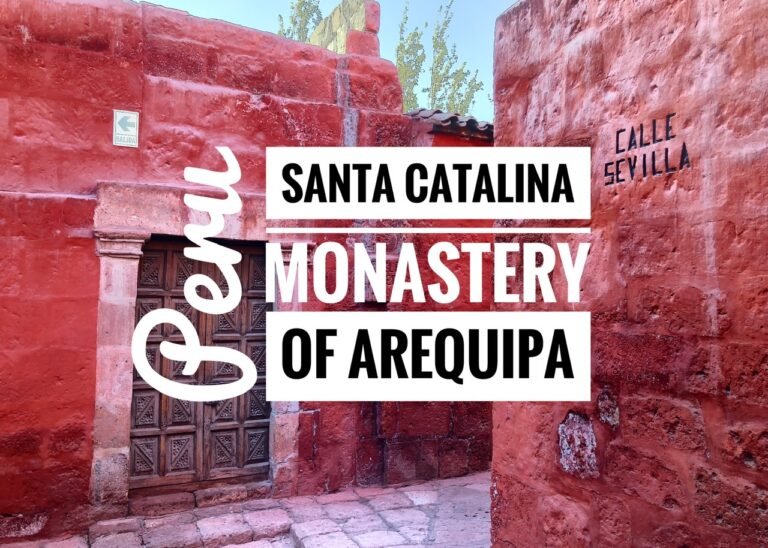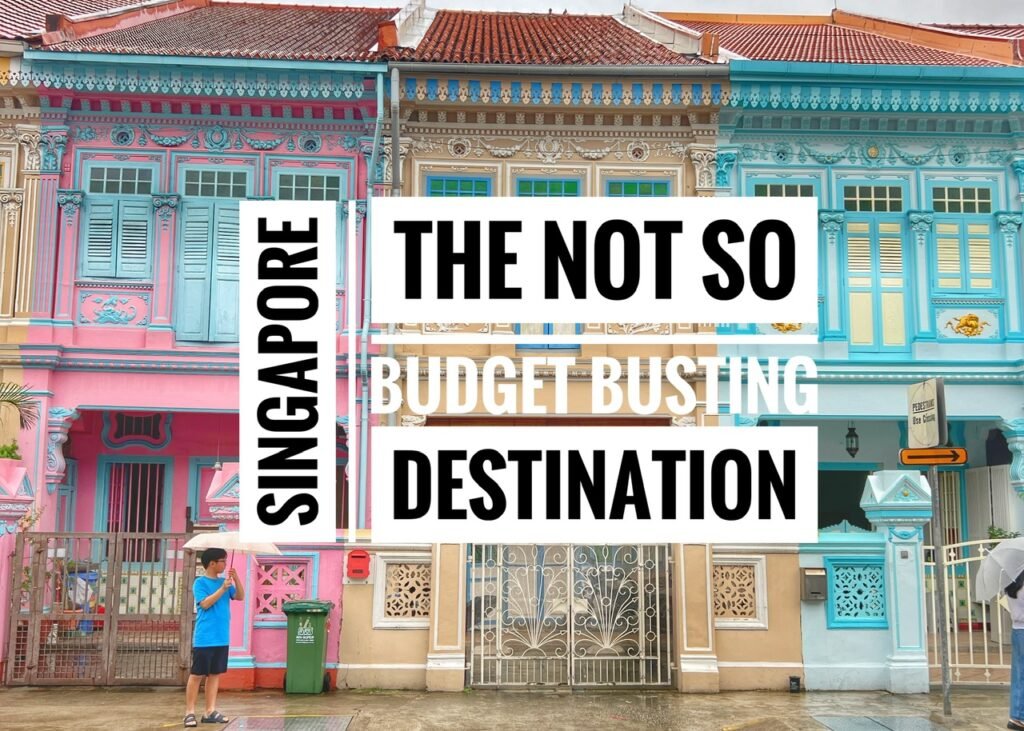
Getting There: Hanoi—–>Singapore
After three months traversing Vietnam, it was time for a little culture shock as we launched ourselves into the immaculate and very developed English-speaking island country and city state of Singapore, population 5.6 million.
We flew on budget carrier, Scoot Airlines which is “the proud little sister of Singapore Airlines.” We appreciated them a lot because they allow 10k of carry-on luggage per person instead of the standard SE Asia 7. Unfortunately our two small bags each still didn’t make the cut and we had to buy one check bag extra for $32. Other than that, our flight was free thanks to our Capital One Venture X card for about 15,000 points for both of us.
Naturally, we also arrived to the Hanoi Airport three hours early to take full advantage of our free lounge access. We then used our lounge access again when we arrived in Singapore which means we didn’t pay for food that day. Yes, there are a few airports in the world you can use lounges on ARRIVAL and Singapore is one of them. 😃
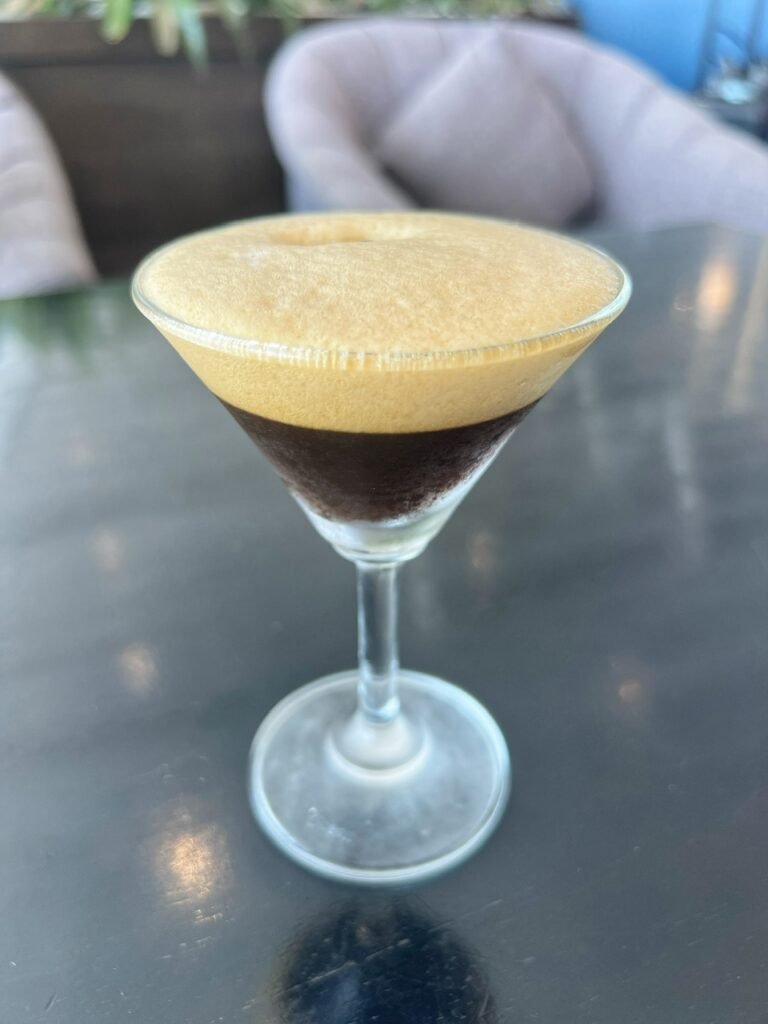
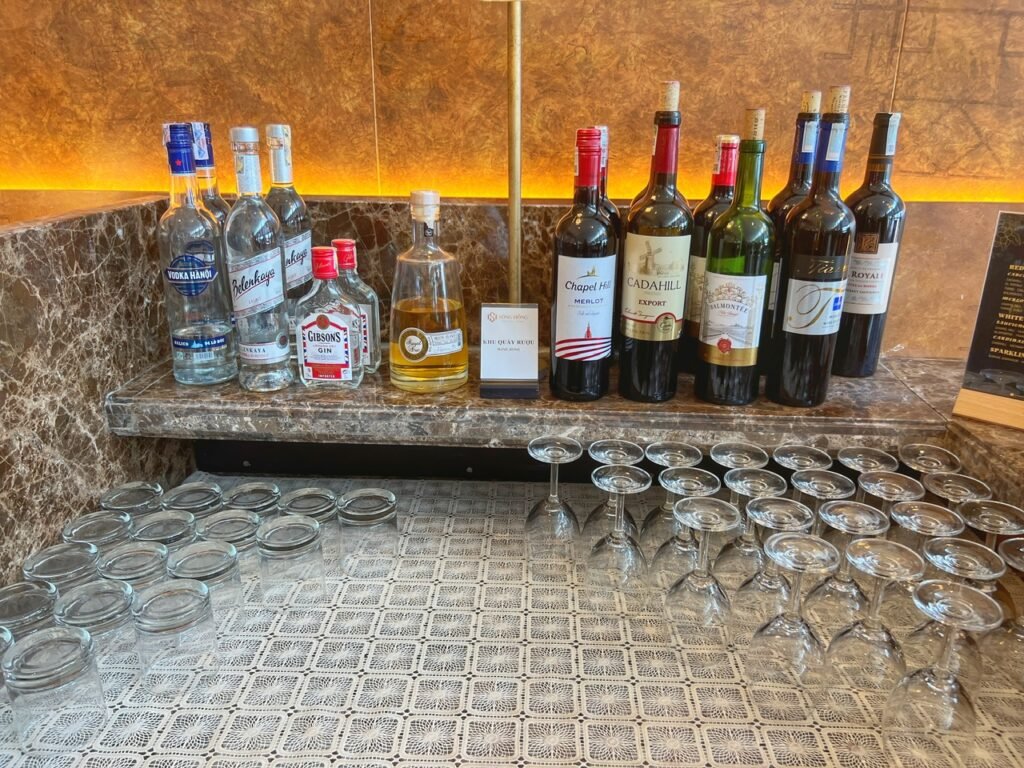
A Vietnamese lounge send away…a coffee martini made with vodka 😋 The booze selection which included the best treat…our first glasses of real wine in four months. (Because sorry, that “wine” in Dalat, Vietnam didn’t count.)
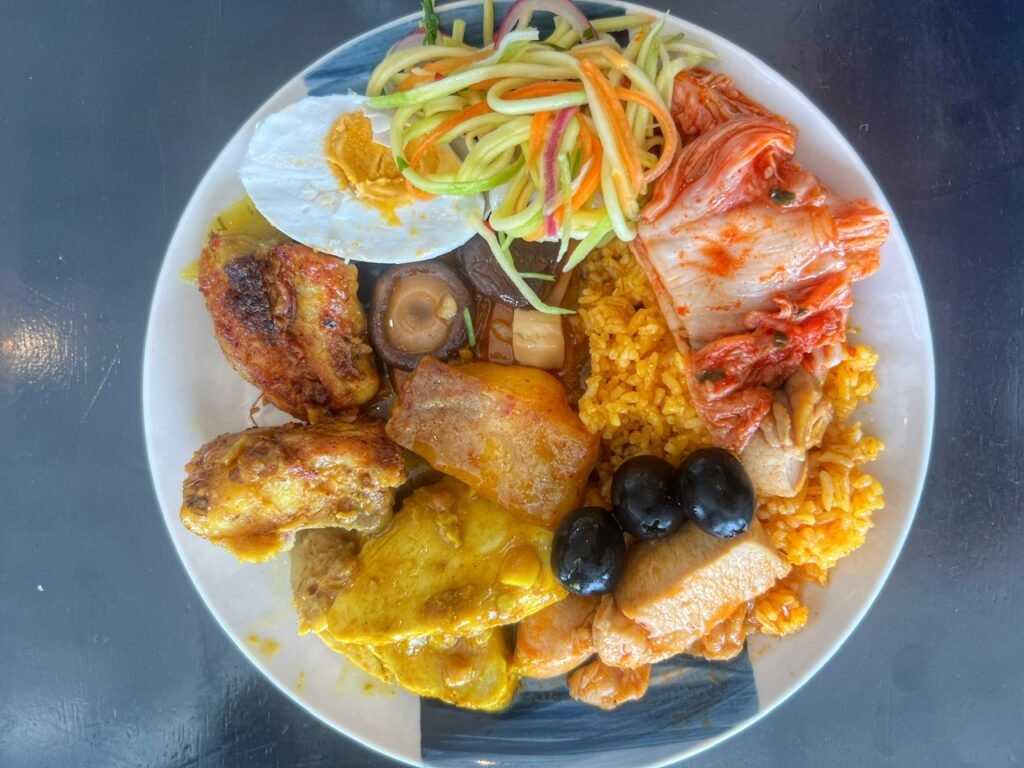
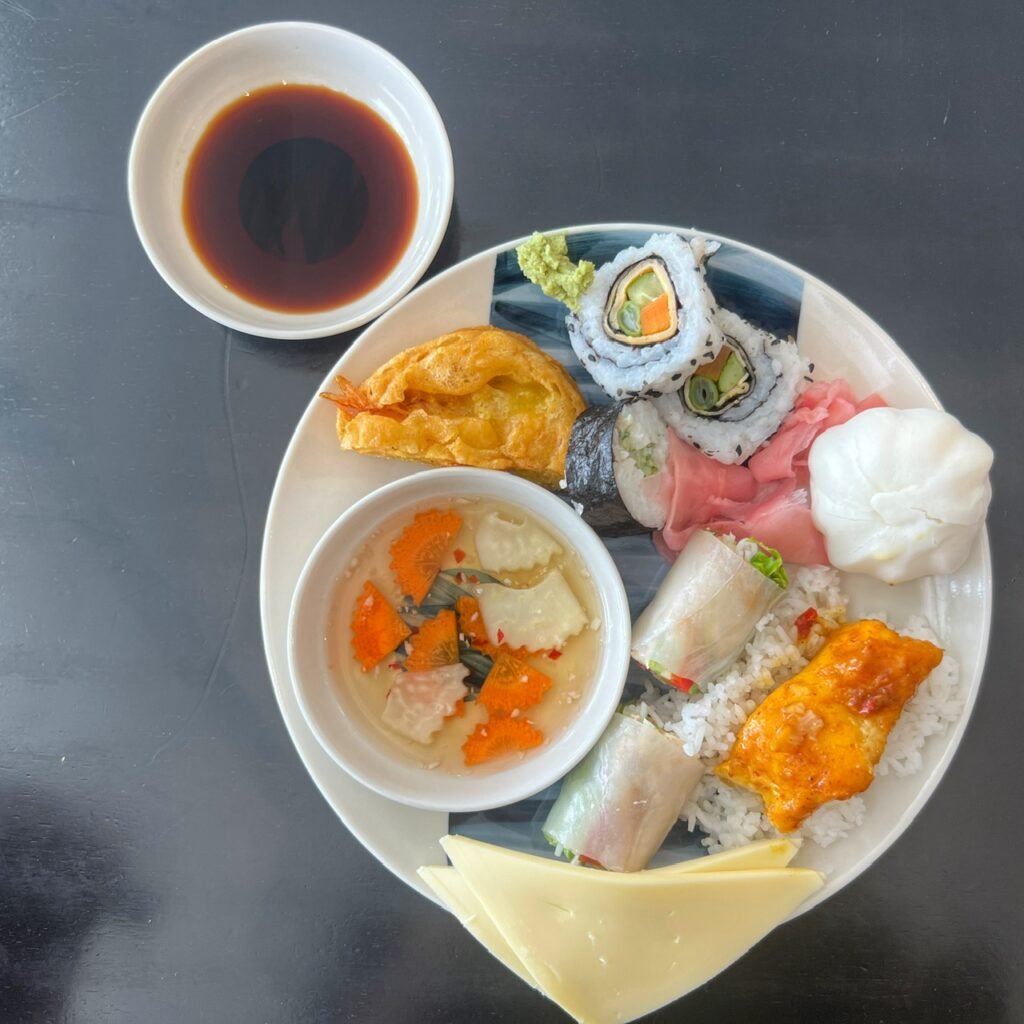
Greg’s pile of food. Uhhh…there’s a chance we may be getting a bit glutinous on travel days. Good thing this isn’t a regular occurrence. 🤣 Mandy was mostly happy they had sushi which we haven’t had since Japan.
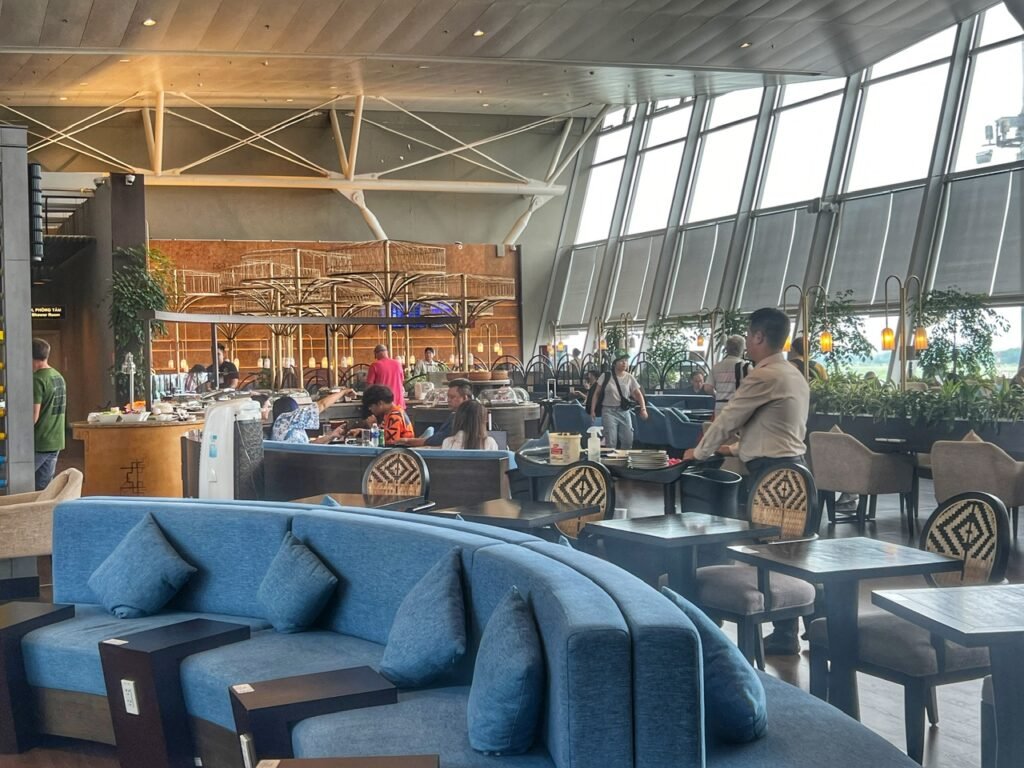
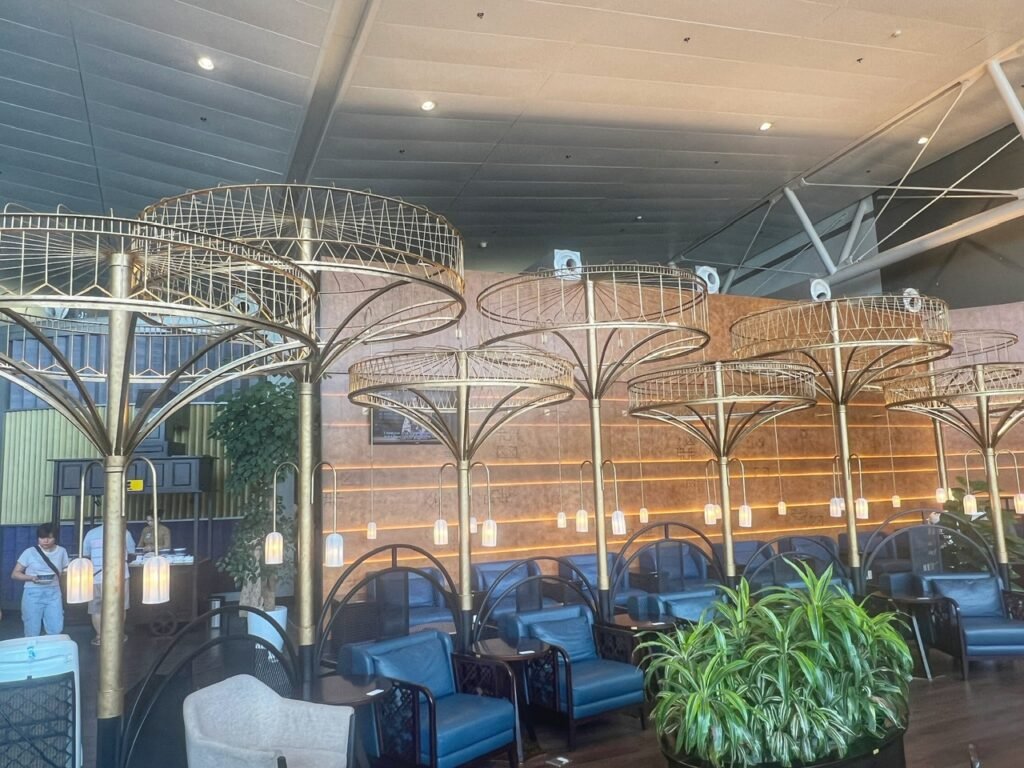
Of the lounges we’ve been in, so far this one in Hanoi is the best in terms of food selection and services, including showers and free magazines. Plus, it had a foreshadowing of where we were going…
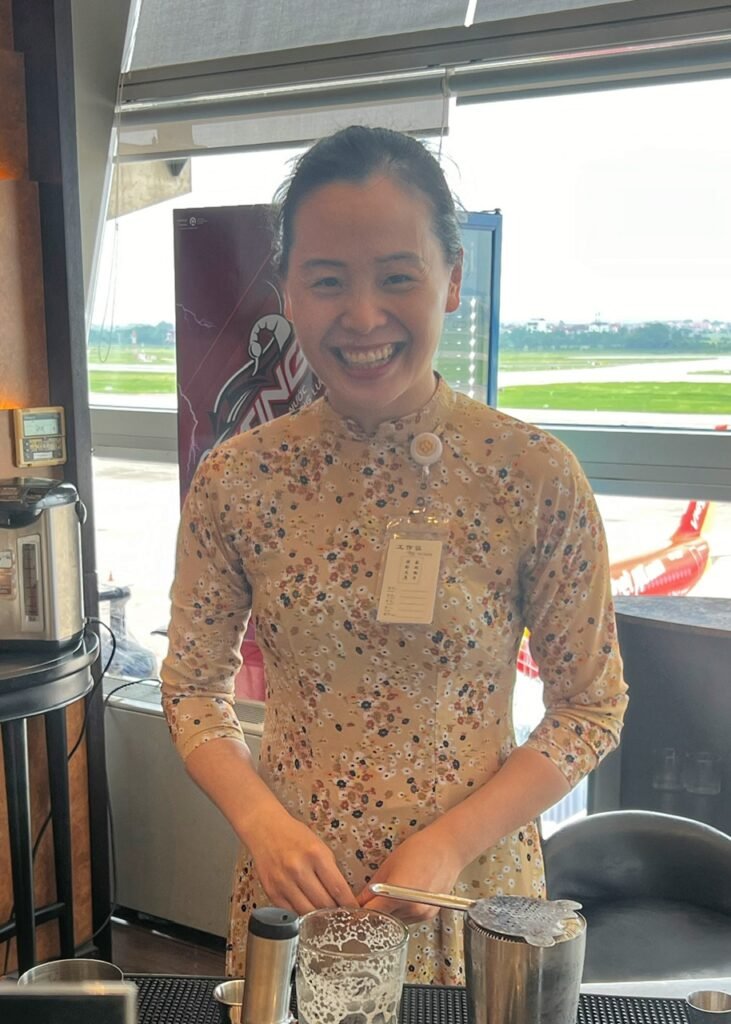
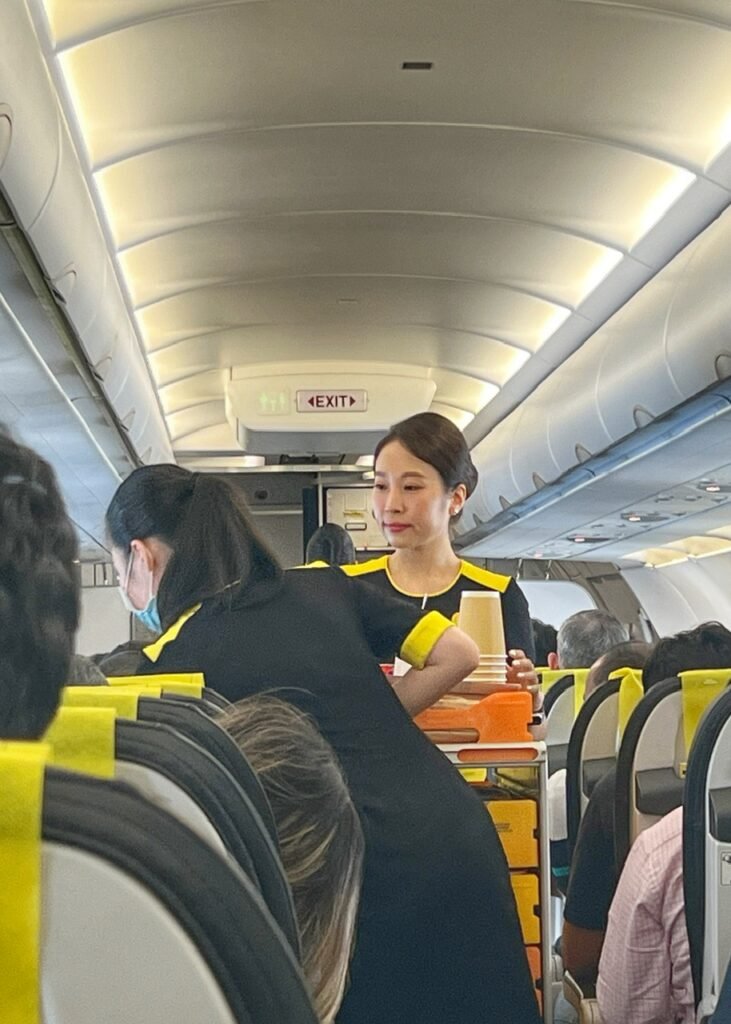
As far as the locals, we met our very smiley bartender…and the attendants on our three hour flight whom were all dressed like bumble bees, a never flattering color combo no matter what your skin tone.
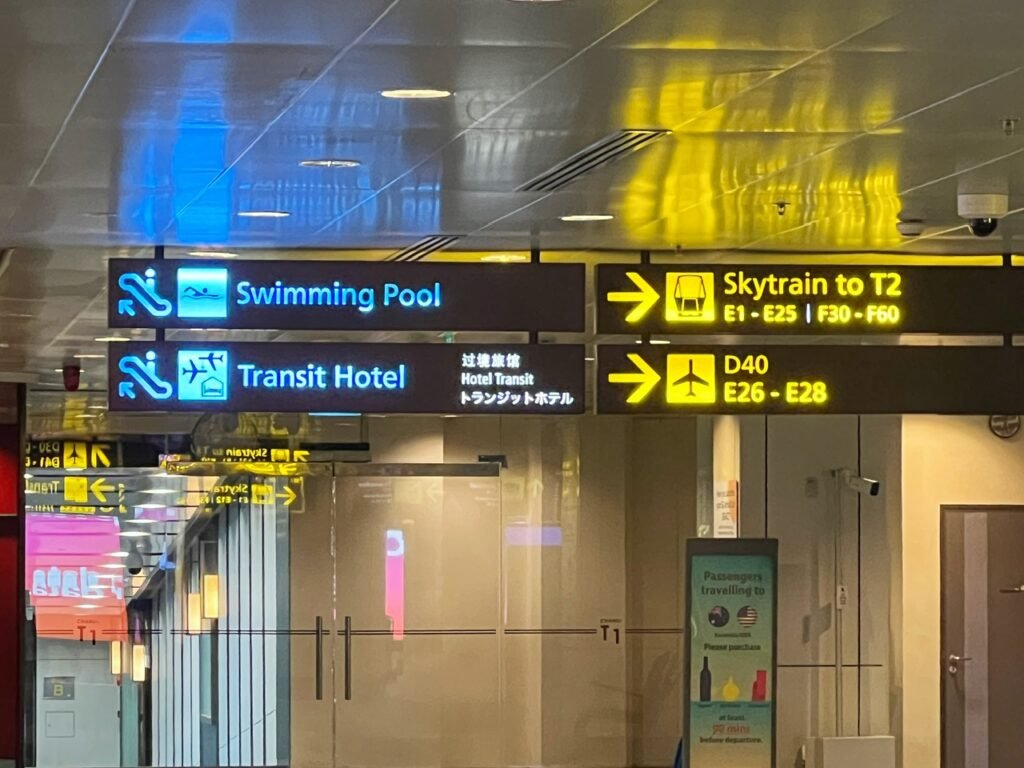
Arriving to Singapore, it was bizarre to see all the signs in English, including one directing you to a $19/visit (USD) swimming pool. We are hoping to explore more of the airport when we leave because it’s world renowned as one of the most fabulous airport experiences in the world.
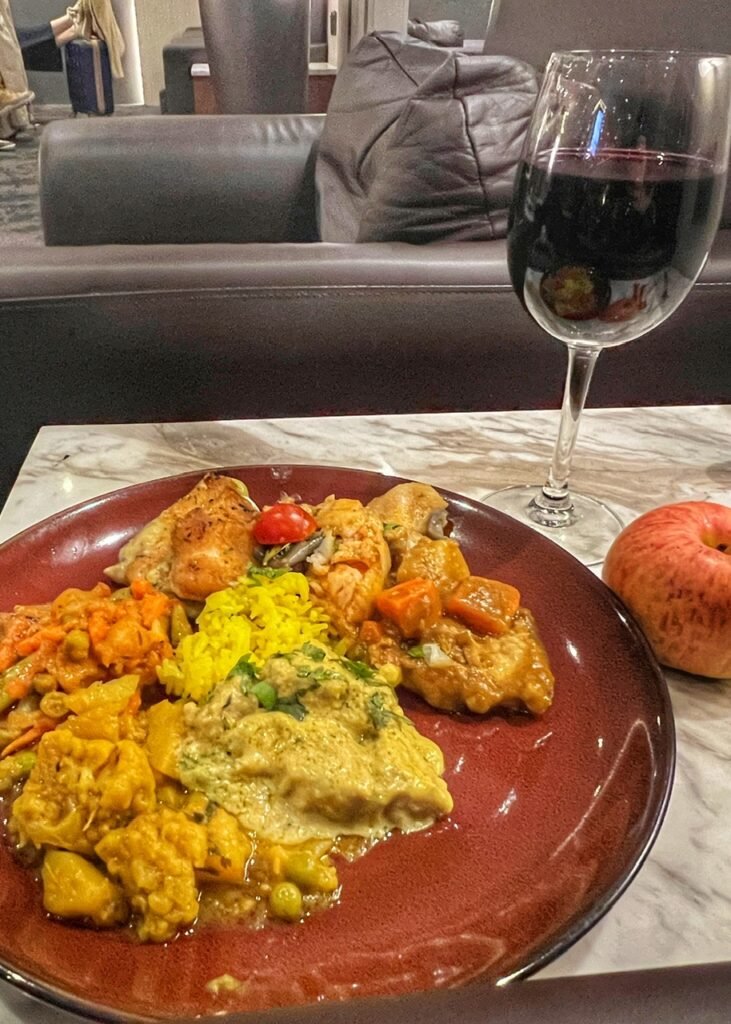
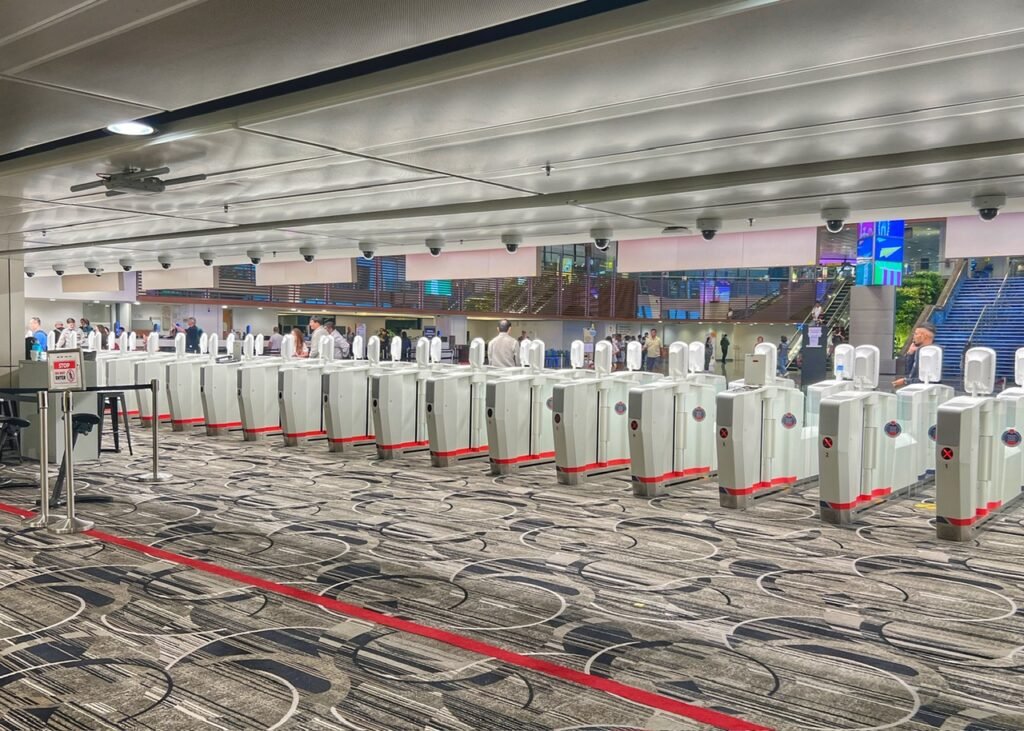
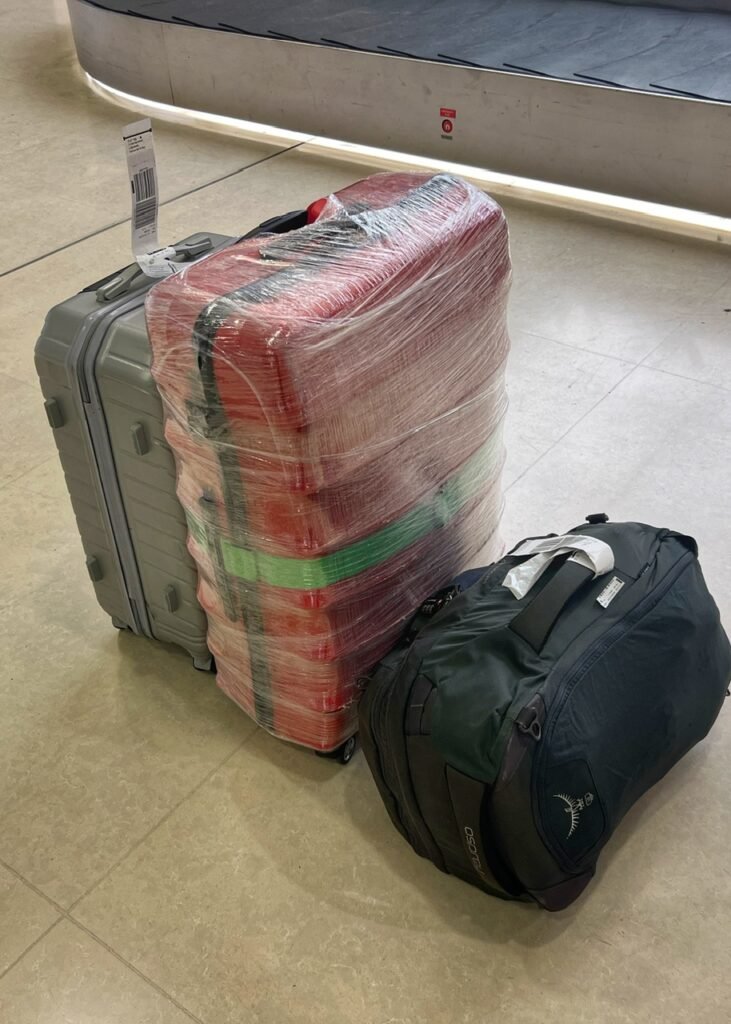
But instead, we had more gluttony to attend to. We chose the SAT Lounge and fortunately they had Indian options which balanced out our Vietnamese/Japanese indulgences we’d had earlier. And of course, more wine. Knowing well it’s a dry week in Singapore otherwise (too expensive!!), we took the opportunity to get a nice buzz on, before officially going through the completely computerized immigration system, which felt like being on an episode of “Black Mirror.” Fortunately, Greg’s bag (the non-planet killing one) was patiently waiting on the floor near the correct luggage belt, despite all our procrastination to fetch it.
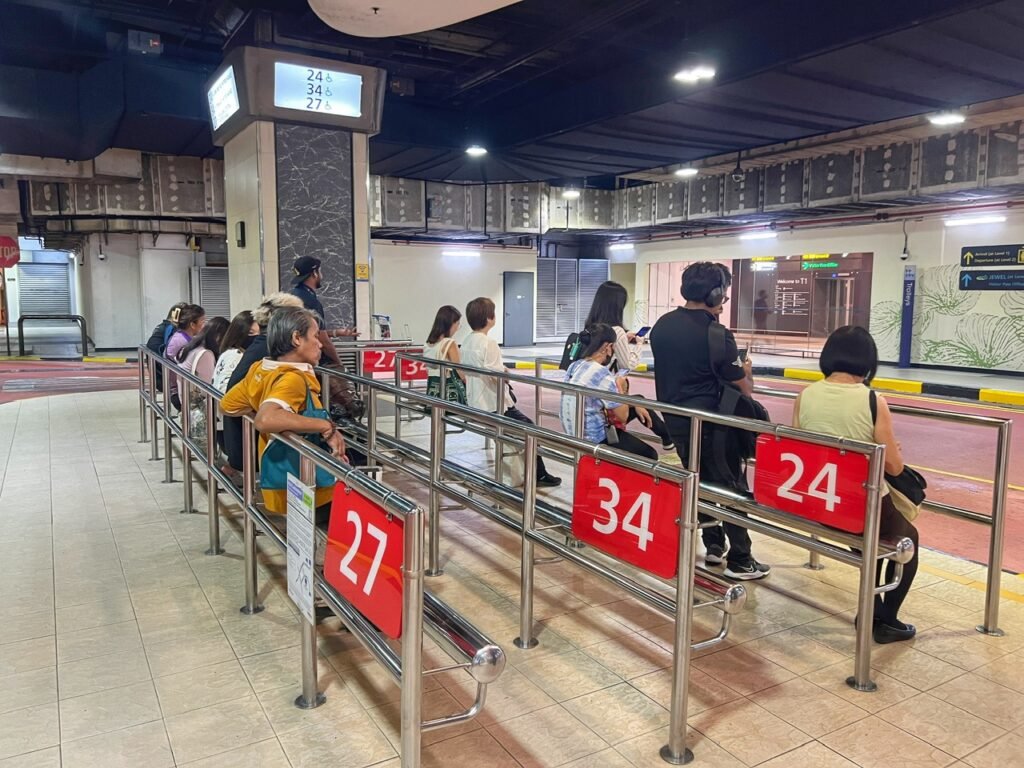
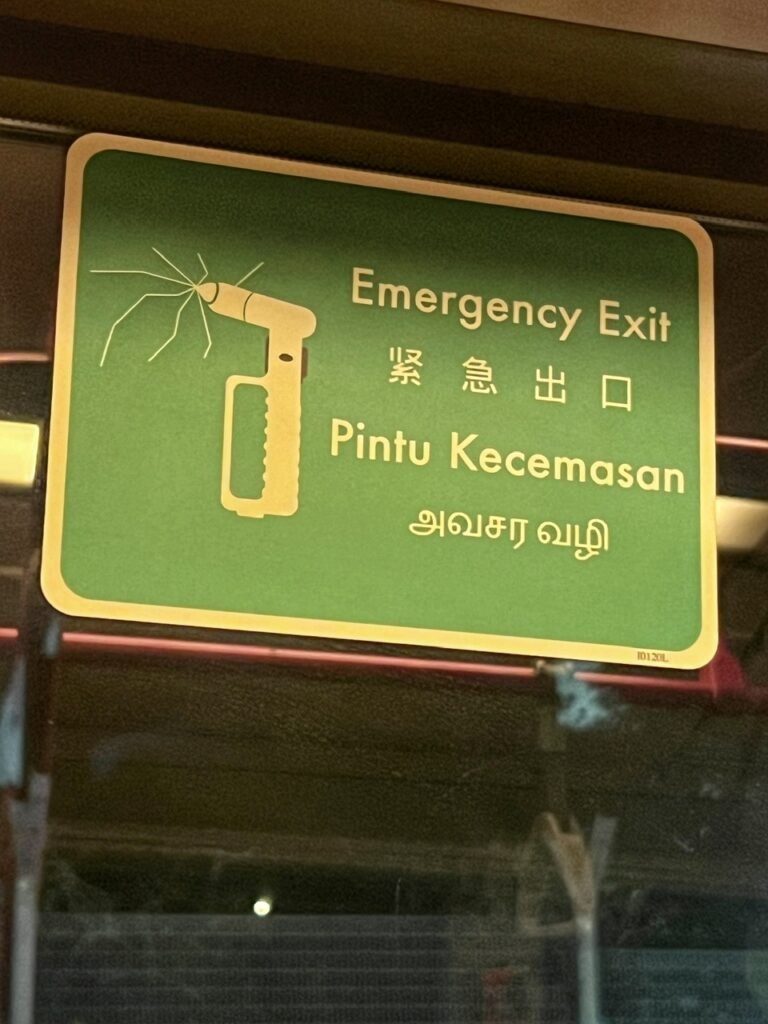
As would be expected, heading out to catch our bus into the city was incredibly simple thanks to Google Maps and the simplicity of Singapore’s systems. Pictured is the seated bus queues to board different bus lines. Once on board, you can easily tap your phone to pay for the ride with your Visa card, but just make sure to tap out when you get off. The ride cost under $2USD each and took about 50 minutes which was pretty reasonable for Singapore in our opinion.
On the bus we had new reading material to attend to. We easily figured out the second language was Chinese and the fourth was Thai, but was the third Indonesian or Malaysian? Google Camera confirmed it was Indonesian and translated it as “The Door of Anxiety.” Now that is a much more entertaining way to put it. 🤣
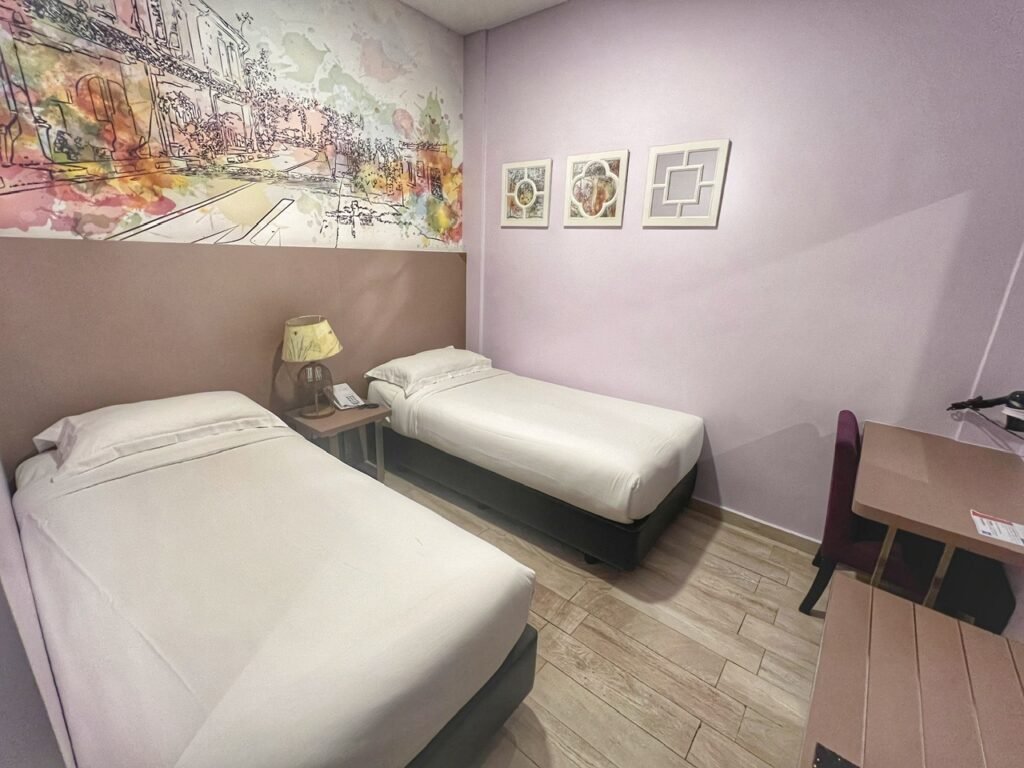
Arriving after 9 pm, we walked 10 minutes from our bus to our hotel, toting all our worldly belongings, and felt safe as could be before arriving to our Budget Ibis hotel room for the night. Yes, this is what $75 far from the center will get you in Singapore. Fortunately we used our Chase Sapphire credit to save $50 of that. Good night!! 💤
Our Housesit in Singapore
We had arrived to the most expensive country in SE Asia so of course, we had to cater to royalty in order to afford it. This time, in the form of two highly entertaining, quirky and huggable pugs. Yes! After a way too long 14-month housesitting drought, we’re finally at it again this week.
Our neighborhood was wedged between the airport and downtown near Joo Chiat and like seemingly everywhere in this city, has access to multiple supermarkets, multiple hawker stalls and multiple shopping centers loaded with food courts. It appears they like to eat around here.…
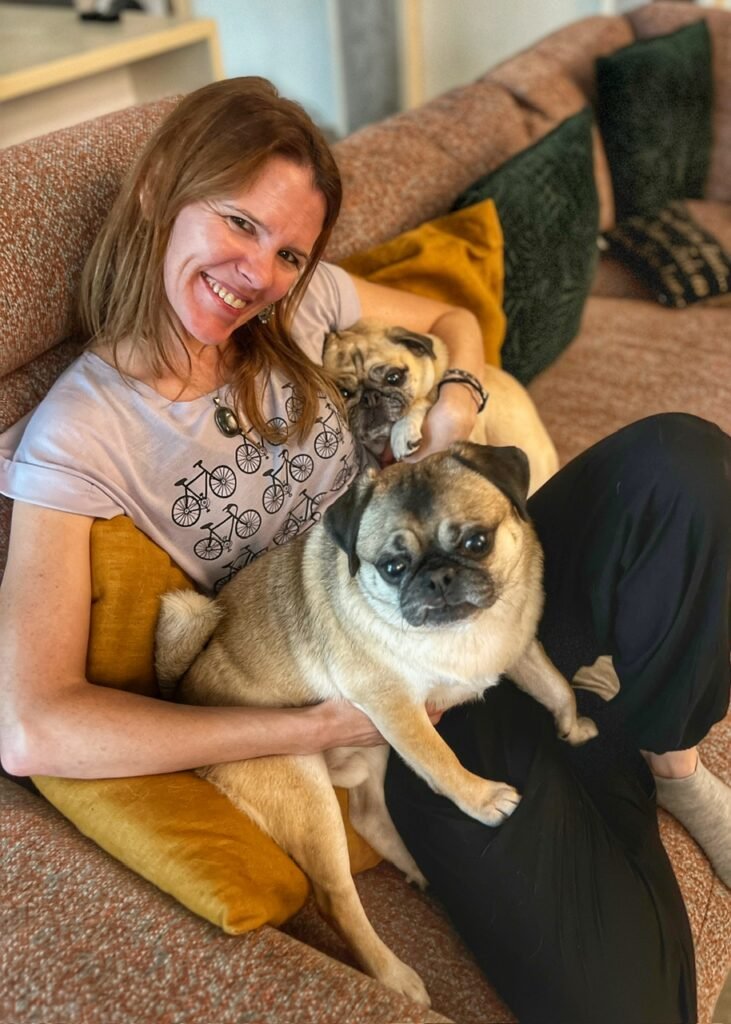
Our new clients were named Winnie and Dudley. It was obvious from the get-go that they couldn’t stand Mandy.
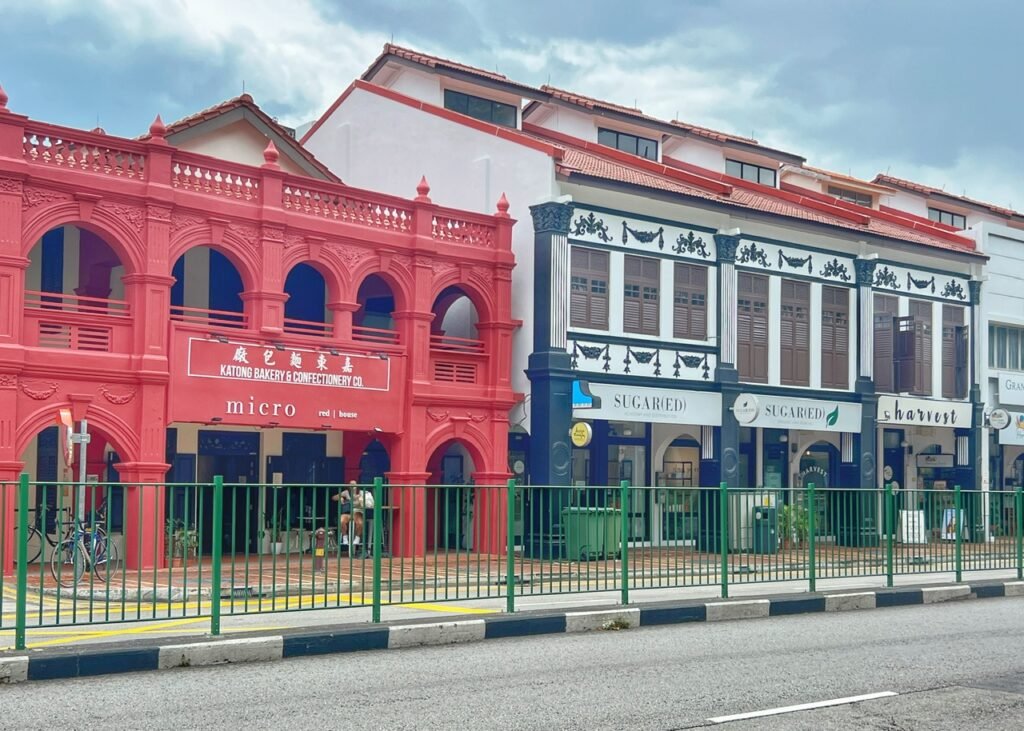

Our neighborhood was blanketed with colorful buildings and loads of charm. Nearby, one of the walking paths in the neighborhood where we attended to daily business. After a month in Vietnam, we couldn’t believe when two construction workers, in SAFETY GEAR(!), told us in advance to walk on the other side of the road because they were cutting down a tree. Wowee! They care about pedestrian safety in Singapore 😃

Fed, walked and farted.

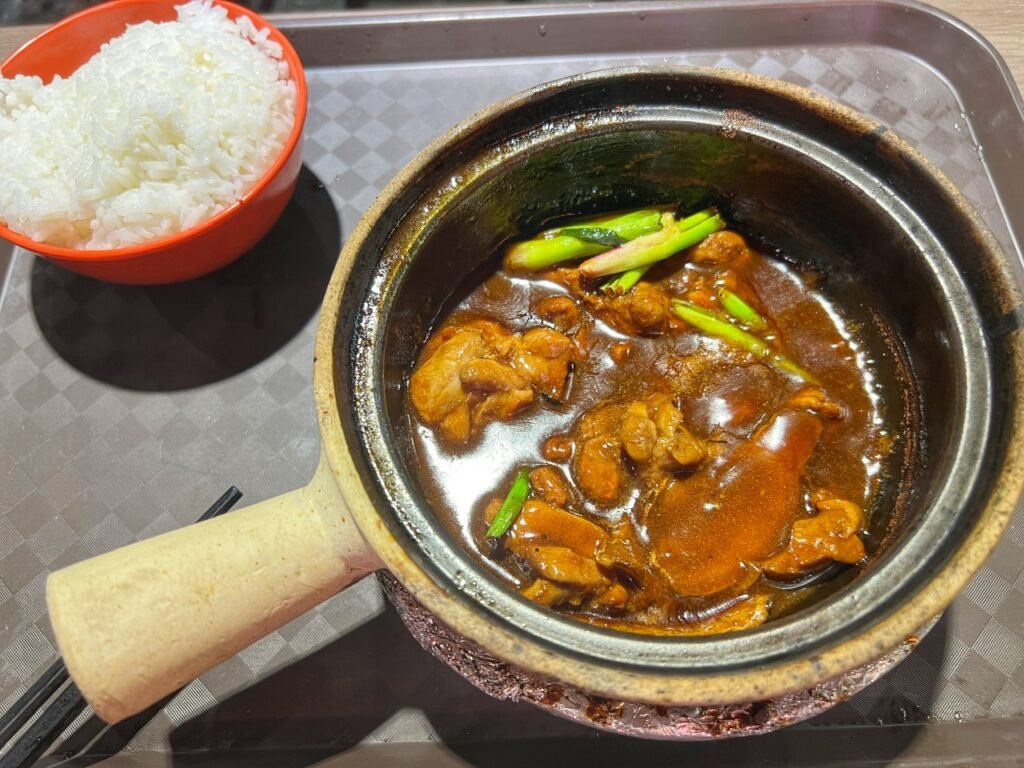
Unfortunately our very first meal at a nearby food court was not the best choice. Mandy had seafood fried rice and Greg, a chicken hot pot. Neither were very good and cost $10 total. Nope, we’re not in Vietnam anymore, kids. Fortunately we’ve got many days to make up that mistake!
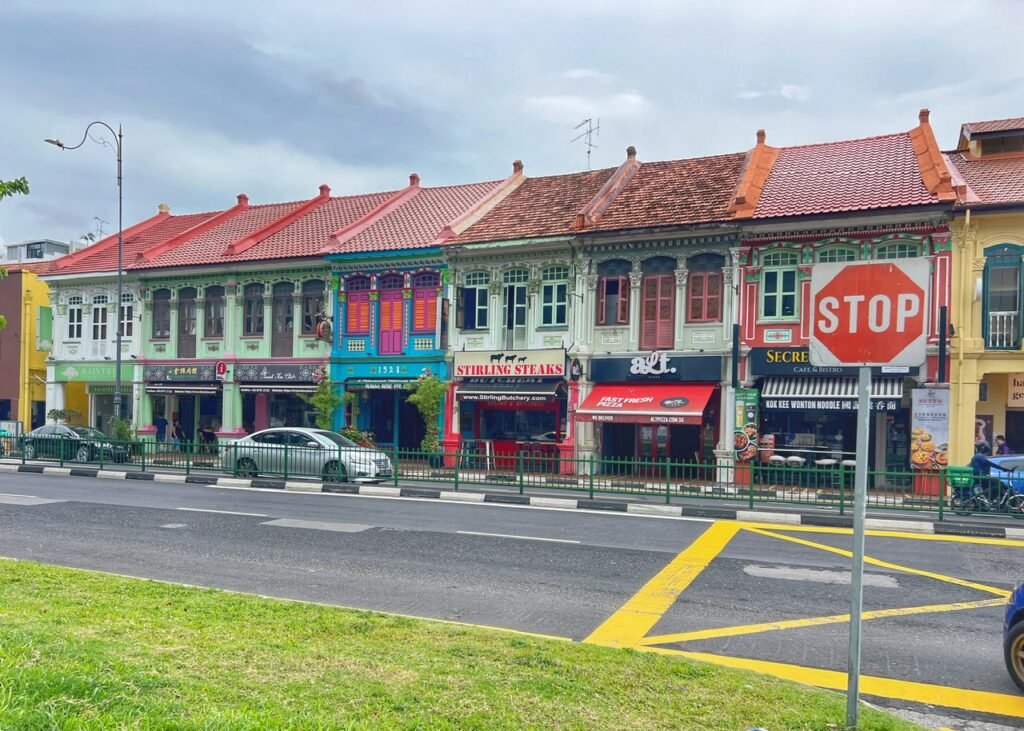
The vibrant feeling of the architecture is a bit like UK, except way less drab! 🤣
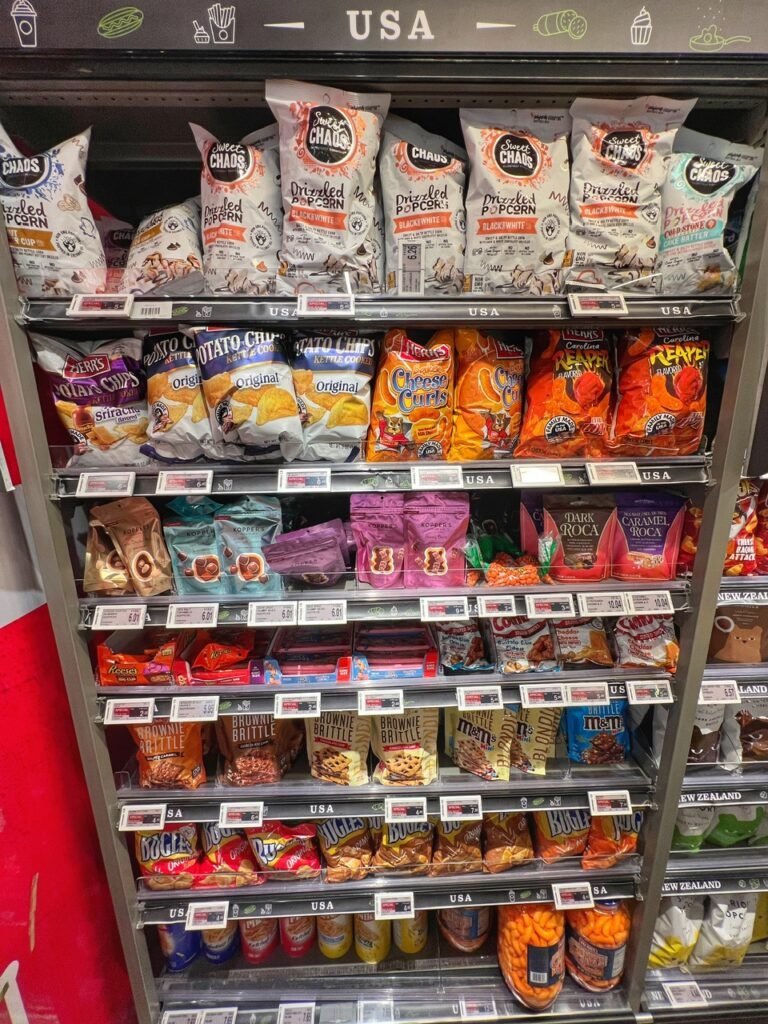
And this is the US selection of products at the supermarket. They did a good job including all the food groups of salt, sugar and fat. We’ve been away so long, we don’t even remember half these brands!


After four months in dairy lean Asia, we were far more interested in this pile of goodies. 😋 Our loot for the week totaled $53.84 USD, which included some more expensive items like Danish feta cheese ($4.70), Norwegian salmon ($5.96) and Australian hummus ($5.69.) Nearly everything is imported here. It felt comparable to a US shopping trip and made us definitely glad we’re not here longer than a week!
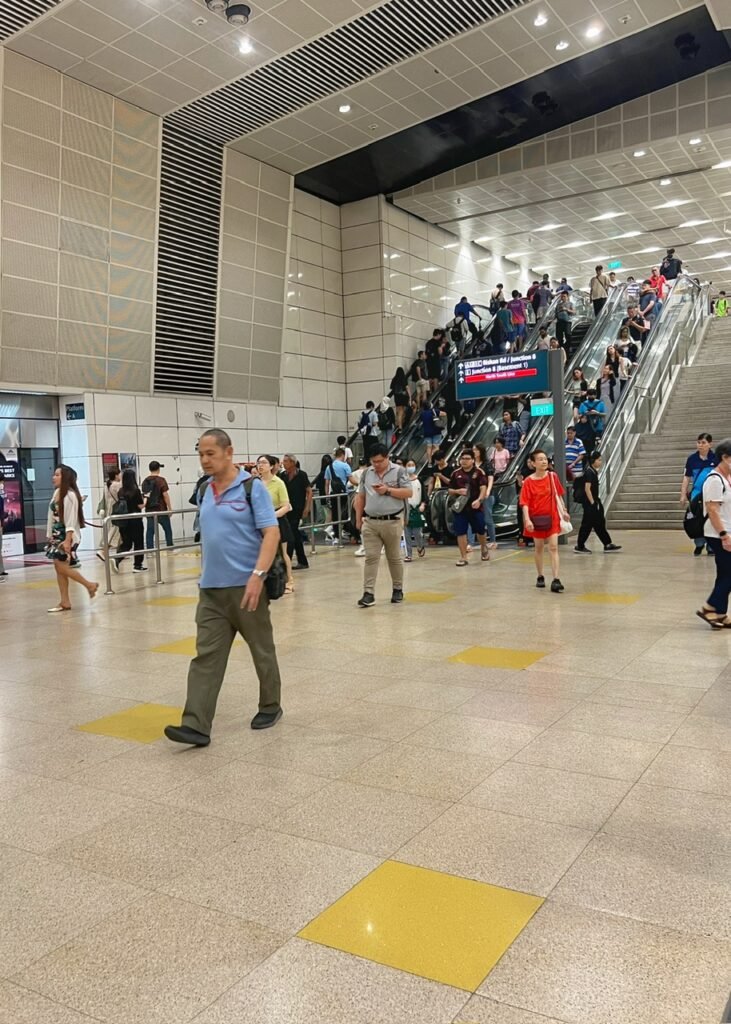
Moving into the subway system, we confirmed that the floors did indeed look clean enough to eat from.


The directional signs on how not to be an asshole on the subway were also considerate,

Other laws that keep things clean, considerate and/or interesting in Singapore include:
- No importation or sale of chewing gum.
- Serious penalties for jaywalking and littering
- Only hand-holding in public shows of affection
- it is illegal to use a public restroom without flushing
- At hawker centres, failure to return meal trays may result in fines
- Walking around naked in your house is illegal because it’s considered a form of pornography
- It is illegal to feed pigeons
- Do not eat or drink on public transport
- Do not connect to another persons WiFi
- Busking (playing music in public) is illegal
So if you are a house-strolling nudist, gum chewing busker, filthy non-tray removing anti-flusher, you may want to steer clear of Singapore.

All this considered, we were shocked to learn that Singapore still has Dengue, although they are bringing in another mosquito variant to attempt to eradicate the tiger mosquitos which carry it.




Back at home with the rambunctious and quirky borrowed children. Speaking of which, we’ve never met a canine quite like Winnie. She loves watching TV, tongue flopping peacefully, especially soothing tranquil scenes like this one. That is, until horses start racing or a lion prowls on screen, and she goes apeshit. Dudley, standing nearby will then pounce on Winnie to try and “get her under control” and then they end up mauling or humping each other. Winnie also has the same behavior when a large truck goes chugging down the street. “Like, seriously, what is gonna do if she actually catches it!?” responded Lisa, Winnie’s mama. Good point🤣 Check out the video in the Singapore wrap!
Perankan Houses

In the Katong neighborhood of Singapore, one can find an explosion of pastels and architectural jewels in the “Perankan Houses.” These pre-WW2 terrace houses display some of the best examples of Straits Eclectic architecture in the city, which in turn showcases the various cultures that comprise Singapore.
For example, Chinese influence is evident in the first floor bat-shaped vents which symbolise good luck, Malay influence in the timberwork fascia boards and Western influence in the plasterwork featuring dentils and floral swags. The fusion of tile work with intricate details also reminds us a bit of Portugal meets Queen Anne.

According to Atlas Obscura, the Peranakans refer to the descendants of Chinese who immigrated to the Malayan Peninsula and the Indonesia Archipelago between the 13th and 15th century.
These immigrants adopted some Malay customs and traditions while retaining some of their own; some say they retained the original Chinese traditions much better than the Chinese who remained in China as they were unaffected by the eradication of culture during the Cultural Revolution.
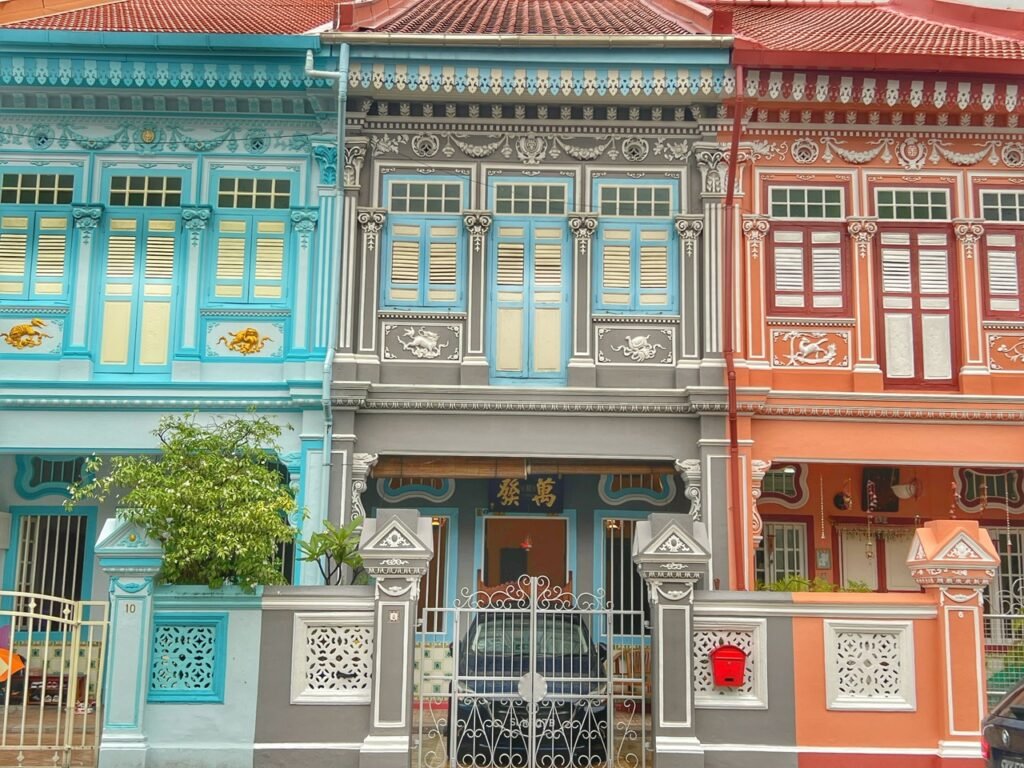
They eventually went on to develop their own culture and language based on that of their adopted countries. When Singapore was colonized in 1819, some Peranakans moved to the tiny island state and befriended the English colonialists, thus beginning their history in Singapore. (Atlas Obscura)
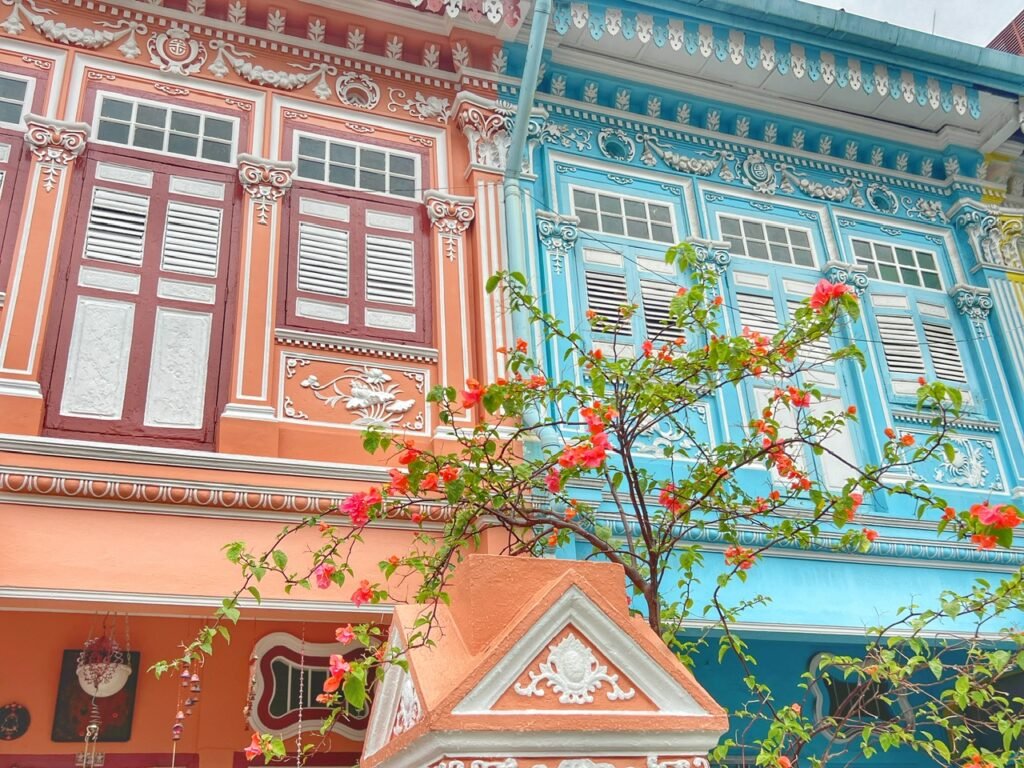
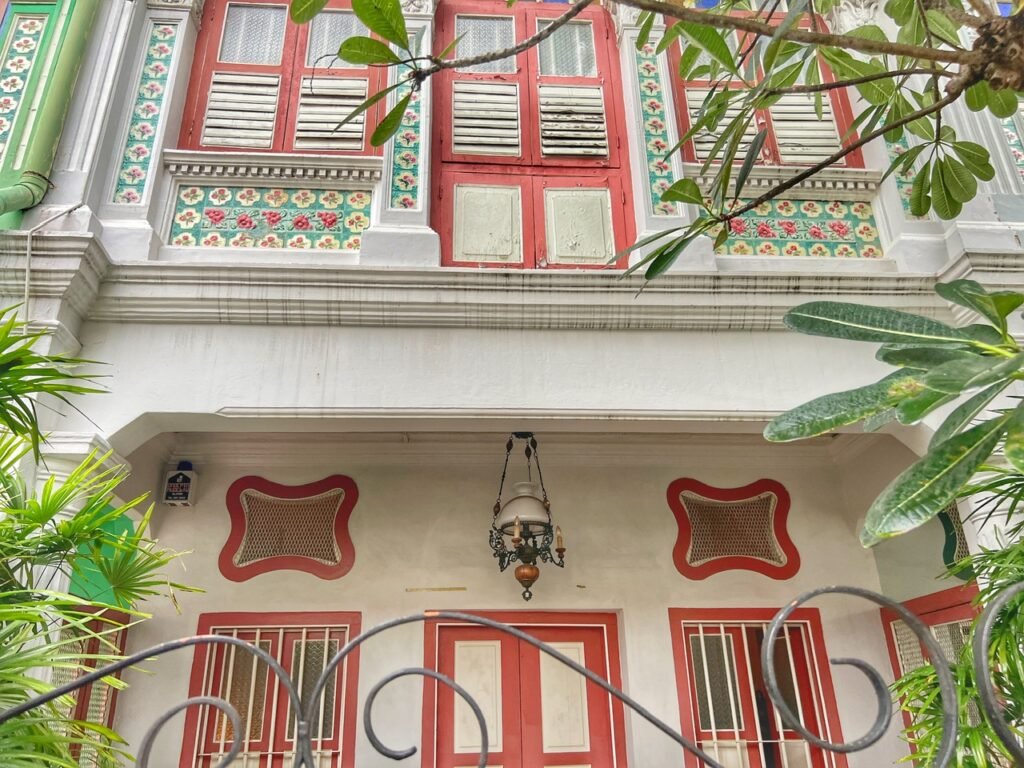
We think we’ll prefer this historic side to the city to the modern side. Bat shaped vents keep the bad spirits out, according to the Chinese. They do like their bats in China, so this is not surprising.
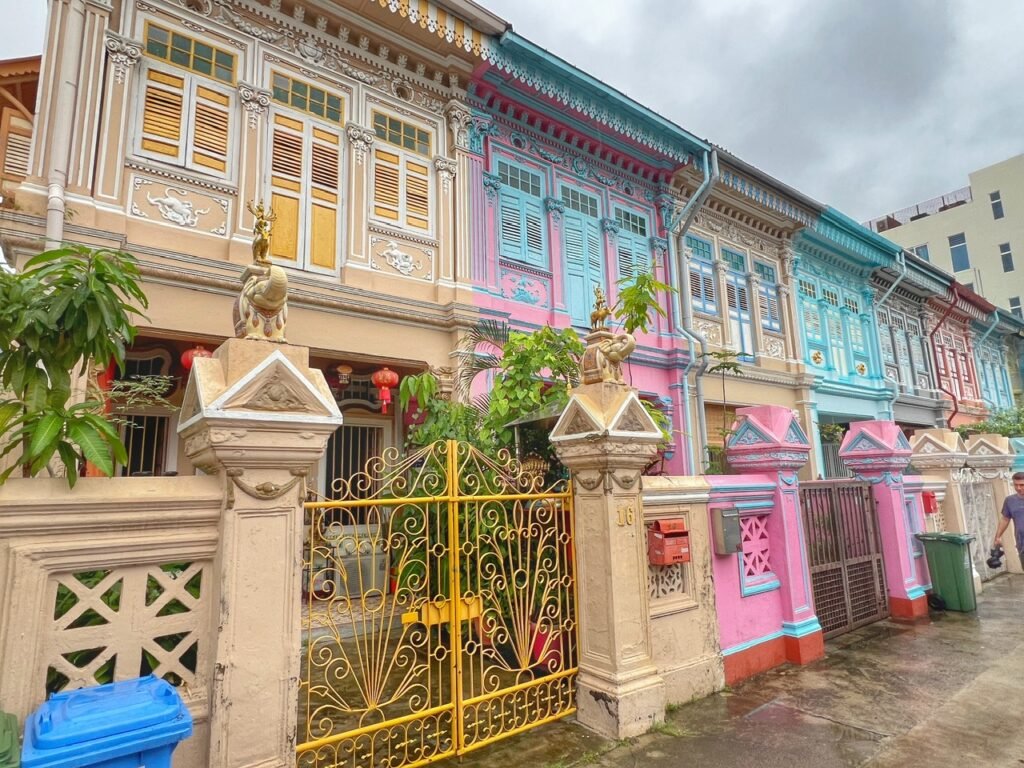
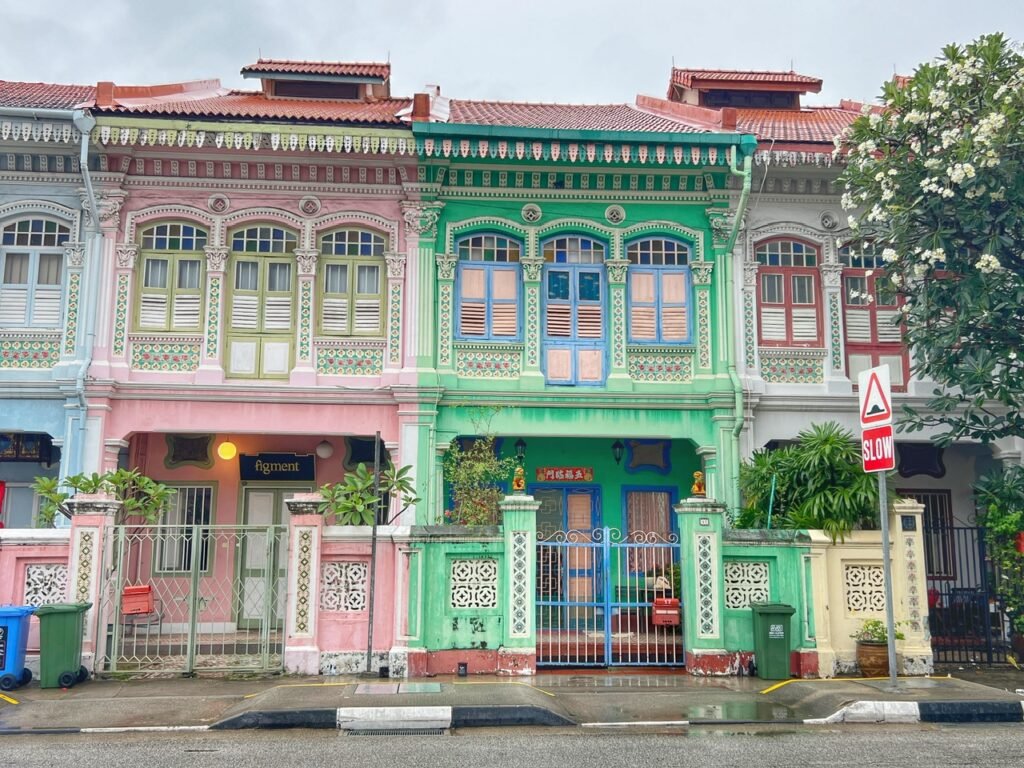
The Peranakans decorated their houses and furniture with these colourful tiles as they believed the floral motifs and vibrant colours would bring longevity, wealth and prosperity to the family. The street was conveniently empty when we went at about 5 pm on a Sunday.
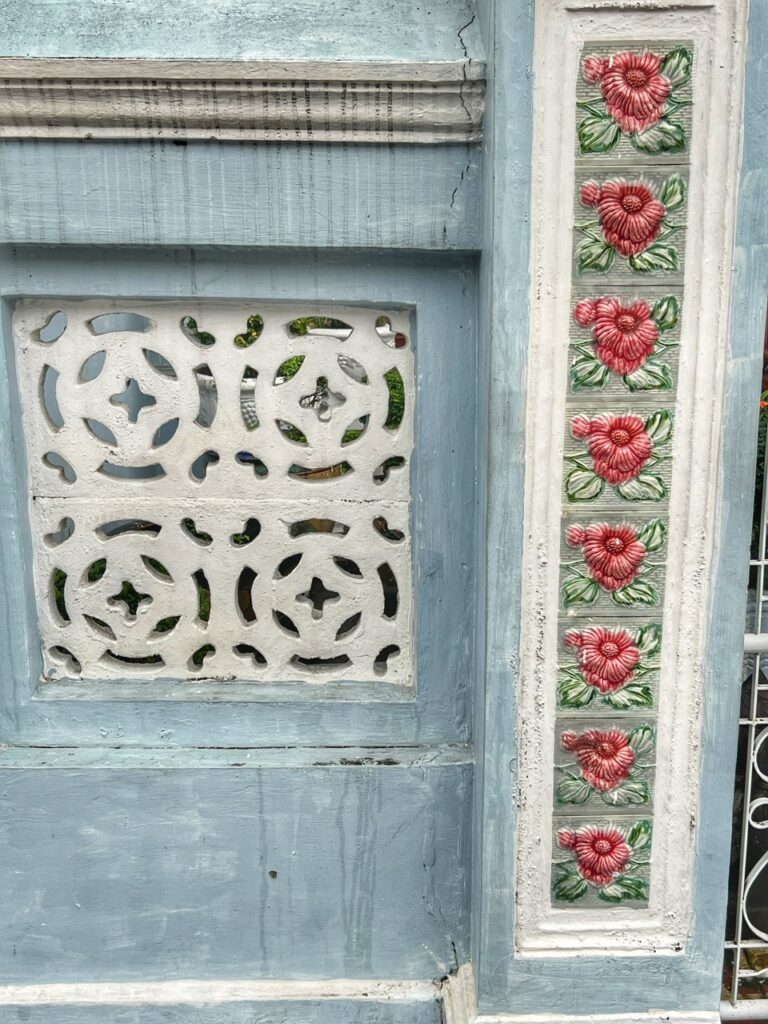
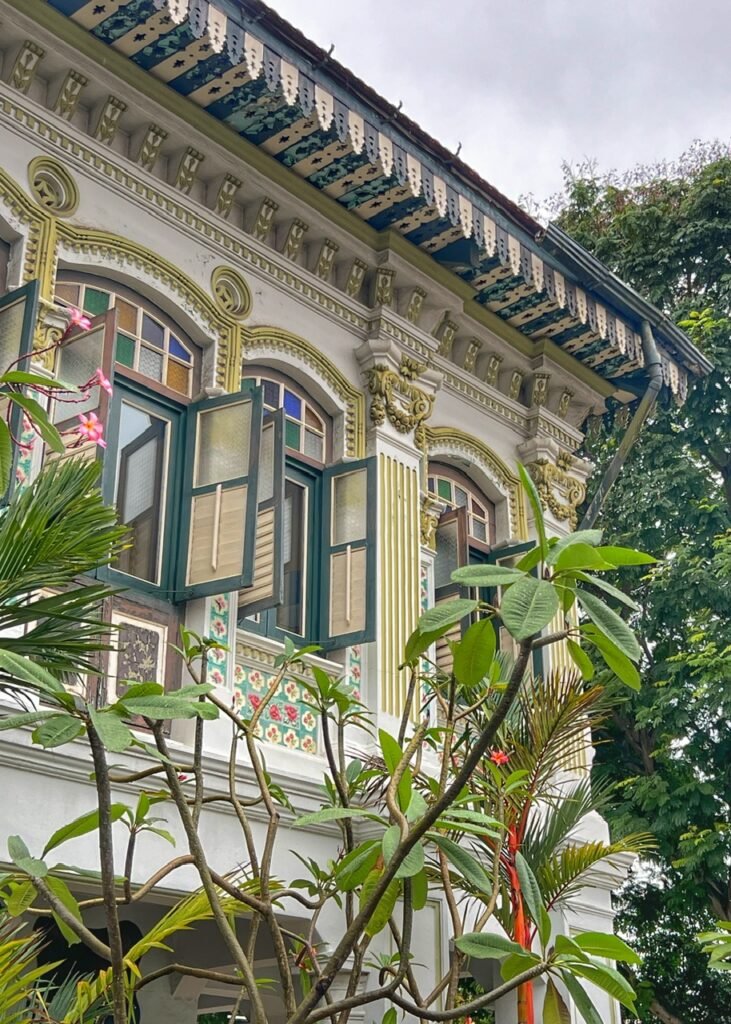
The tile work which exudes Portuguese influence. They are still individually owned by private residents. With all the lurkers outside their homes taking insta shots, they really have to make sure to keep their clothes on.


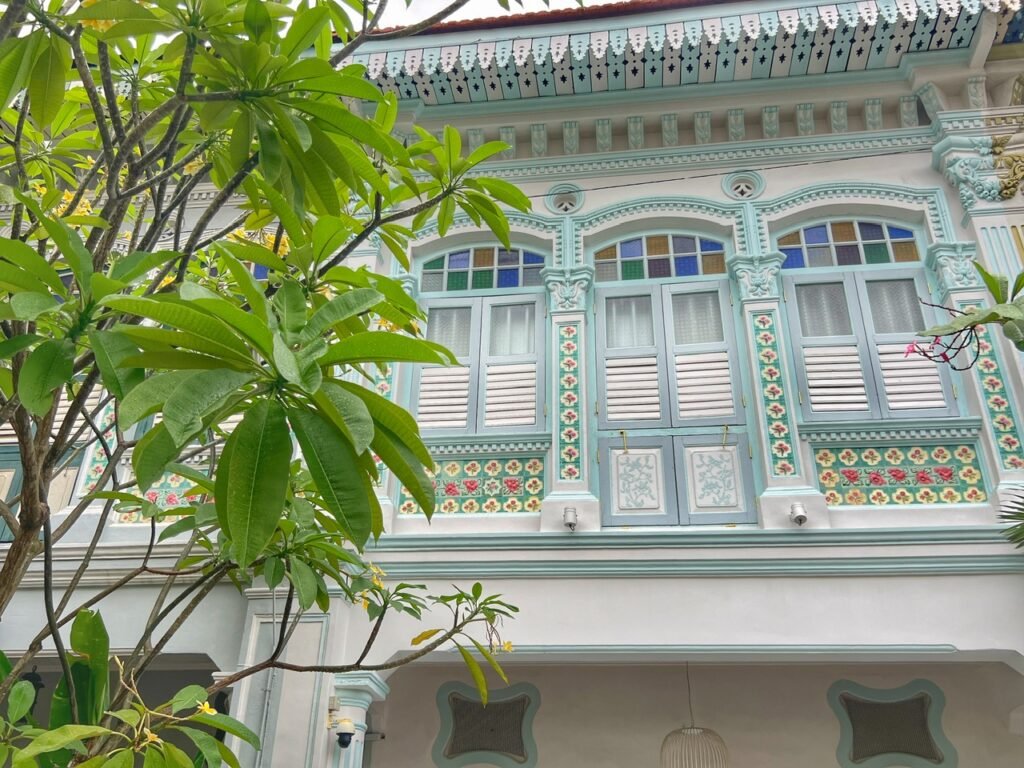
Wow! They are truly just ravishing!

Also in the neighborhood, it’s worth it to wander down Joo Chiat street where you can find vibrant street art…

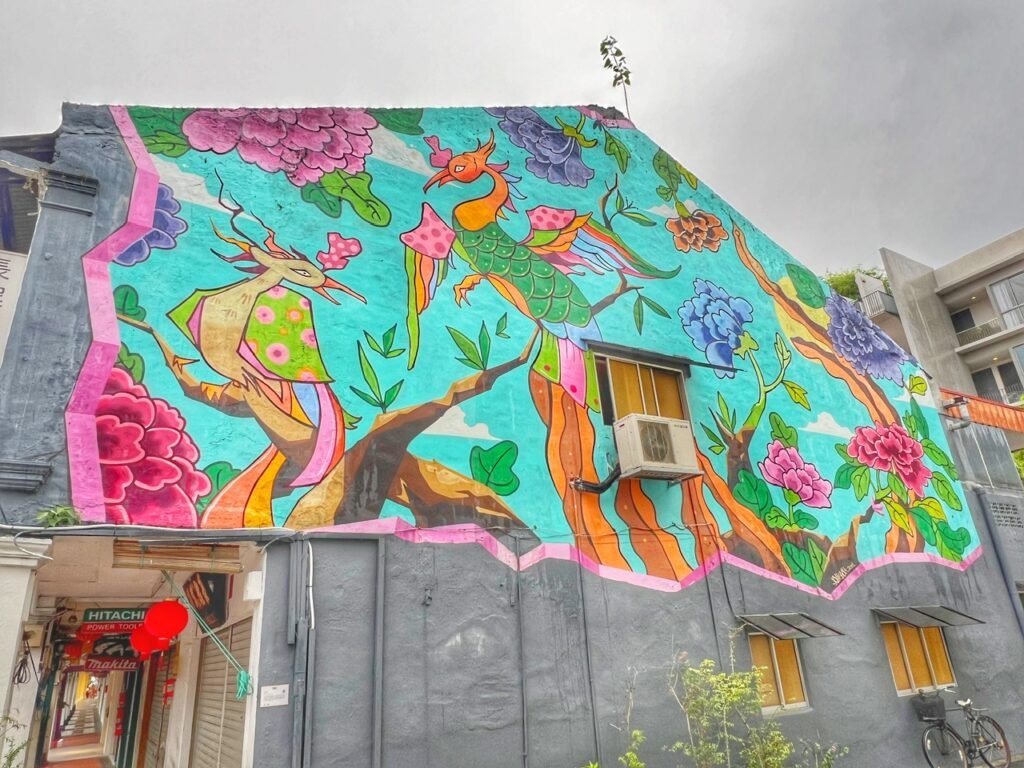
…lots of heritage houses now posing as shops and restaurants, and so many pops of color to brighten up even a grey day.

Corner crush ❤️
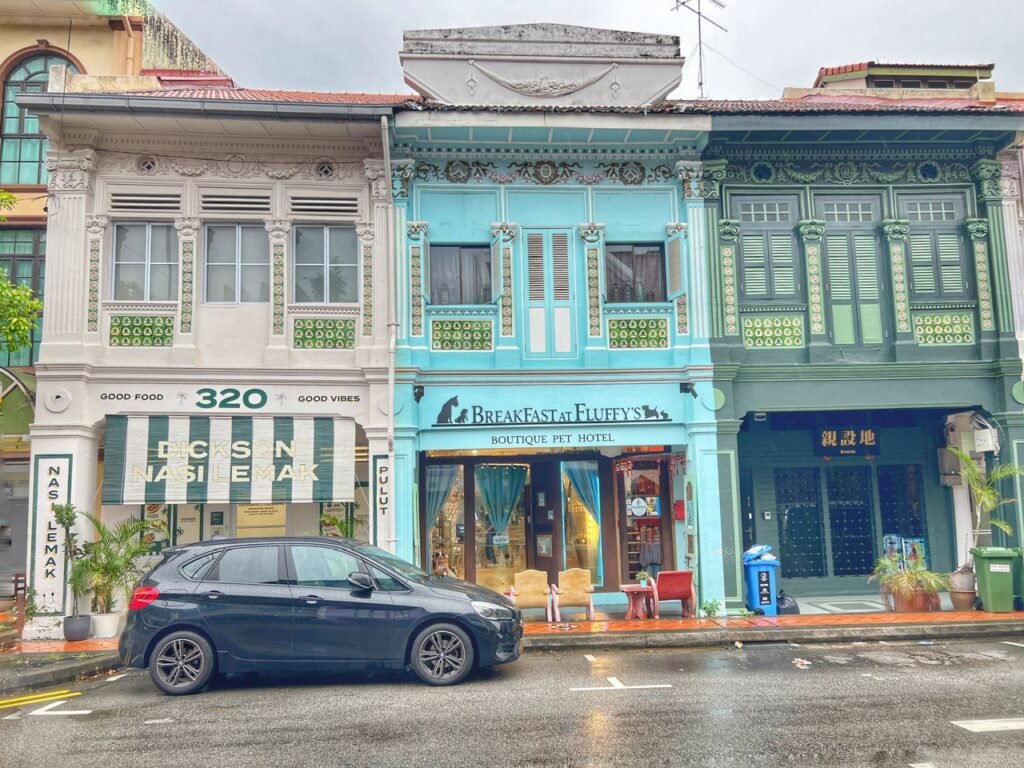
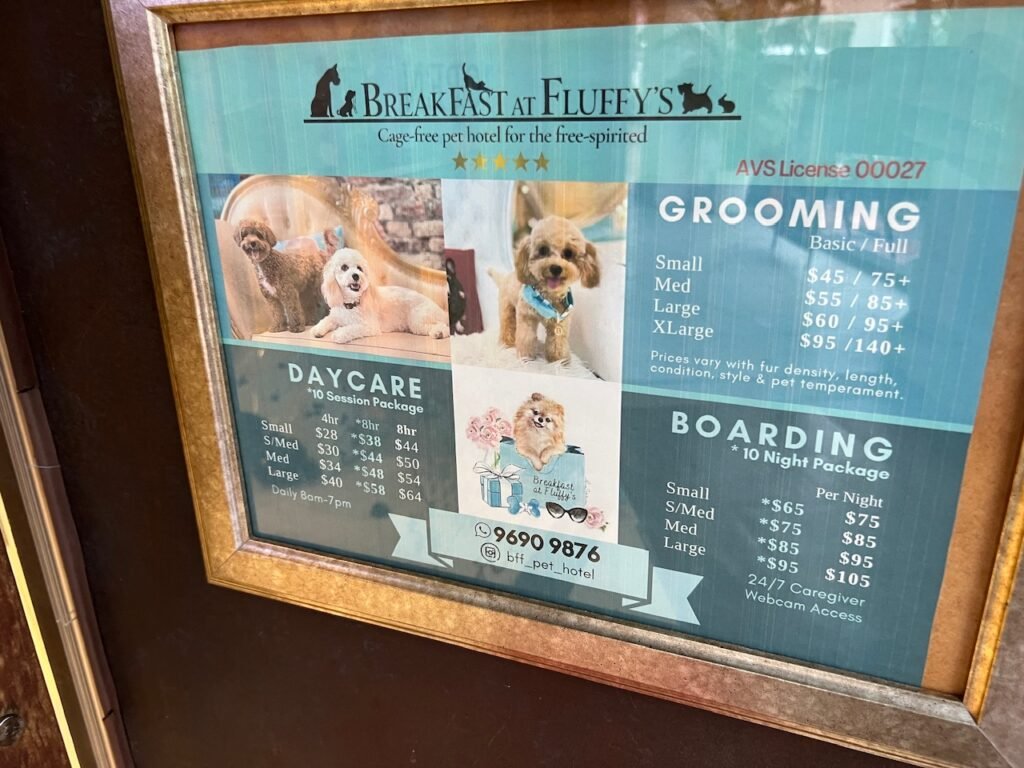
Breakfast at Fluffy’s, a designer boutique pet hotel. In case you’re curious what pooch pampering costs in Singapore… (the prices are in Singaporean dollars, which is about $1.35 for $1 USD so about 35% cheaper than this.)
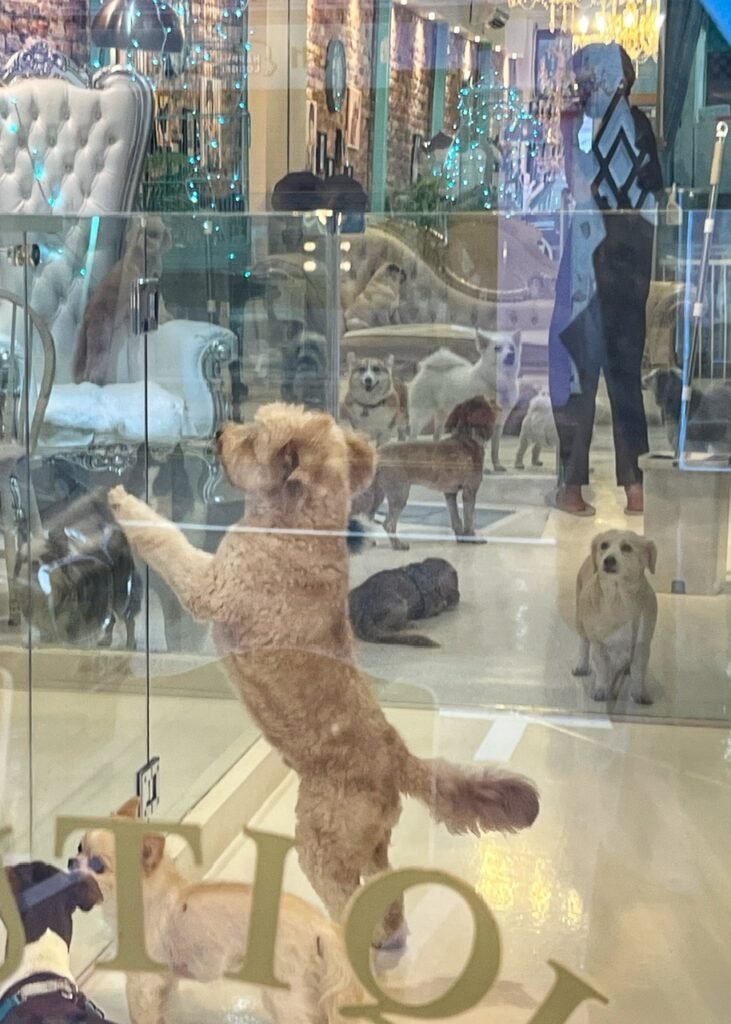
We couldn’t help peeking inside the window and seeing this. Our rent-a-kids could have this set-up, but they ended up with us.
Gardens by the Bay

Of course, no trip to Singapore is complete without a wander into the UNESCO World Heritage site of Gardens by the Bay. This world renowned 250-acre garden has some of the most eco-friendly artistry on the planet, including 18 soaring iconic Supertrees shrouded in plants and flowers, which superbly harmonize nature with modernity.
This wonder of garden genius was built on reclaimed land and completed in 2012 for the price tag of 1.035 billion SGD or $769 million USD. We were fortunate to be in Singapore on a Monday night to be mesmerized by the nightly “Garden Rhapsody” show, as well thrice-weekly “Borealis” Northern Lights show. Both feature dancing lights and music, and yes, all is free.
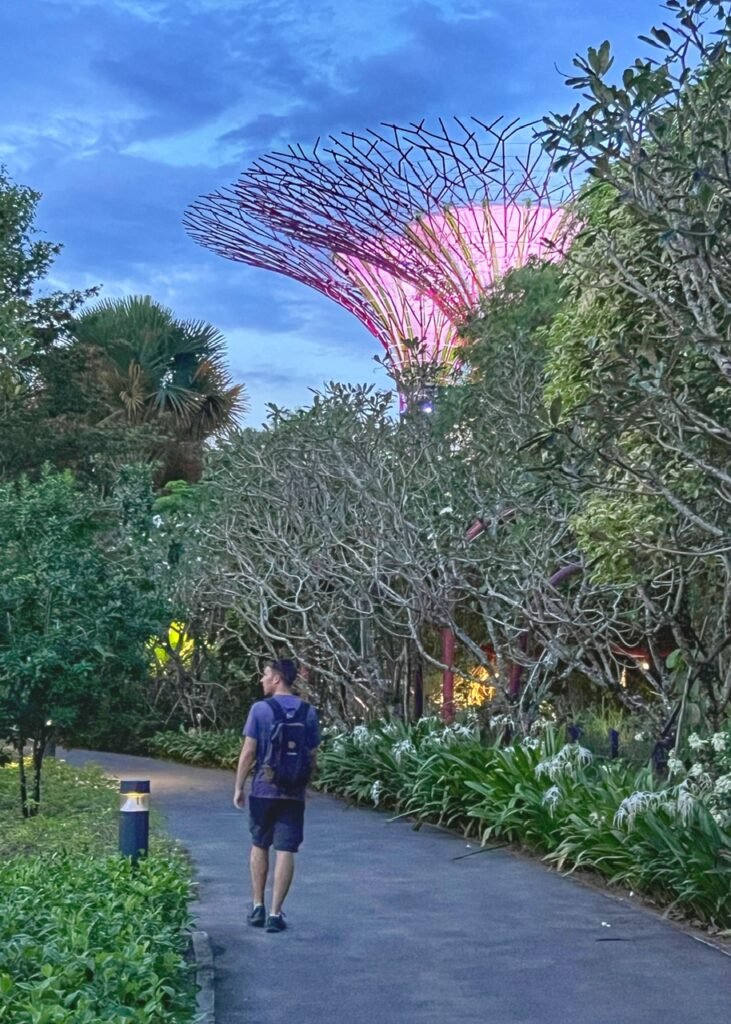

Also, make sure to arrive early. We spent about an hour walking through the gardens before arriving to the super tree forest where we admired more soothing nature encompassed scenery of the famous Marina Bay Sands…
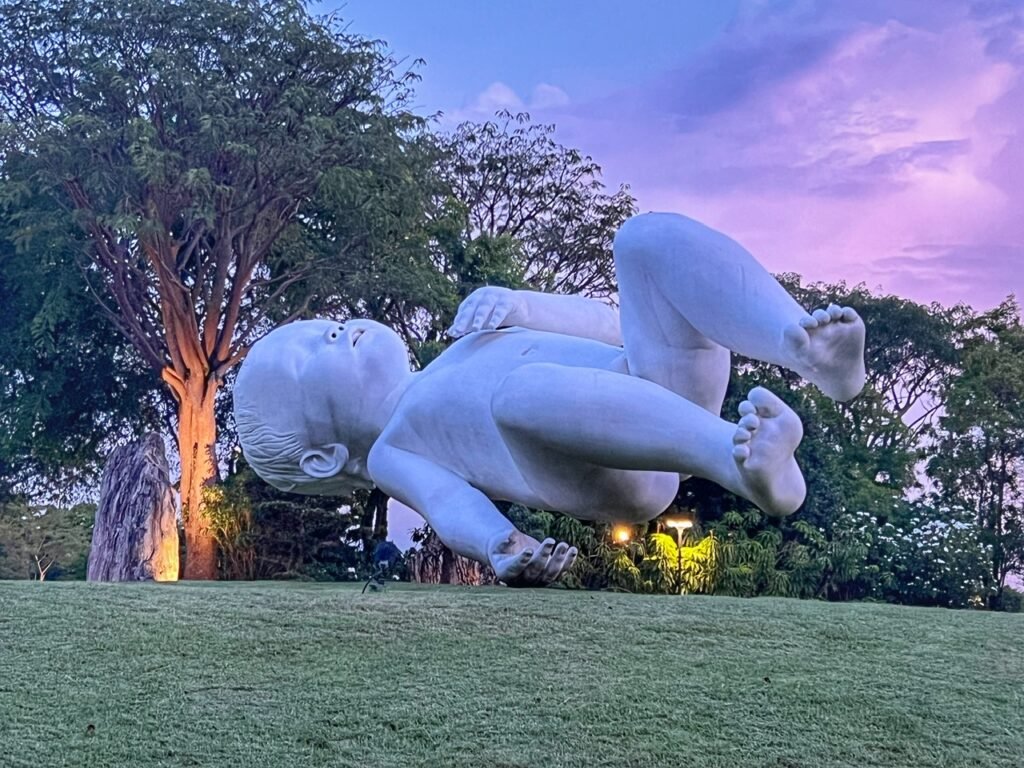
…and a giant floating mini human, who is in fact, “balancing on a languid arm of a sleeping boy child.” (says the plaque.) This seven ton, bronze cast sculpture was created by Marcus Quinn in a depiction of his infant son, Lucas.
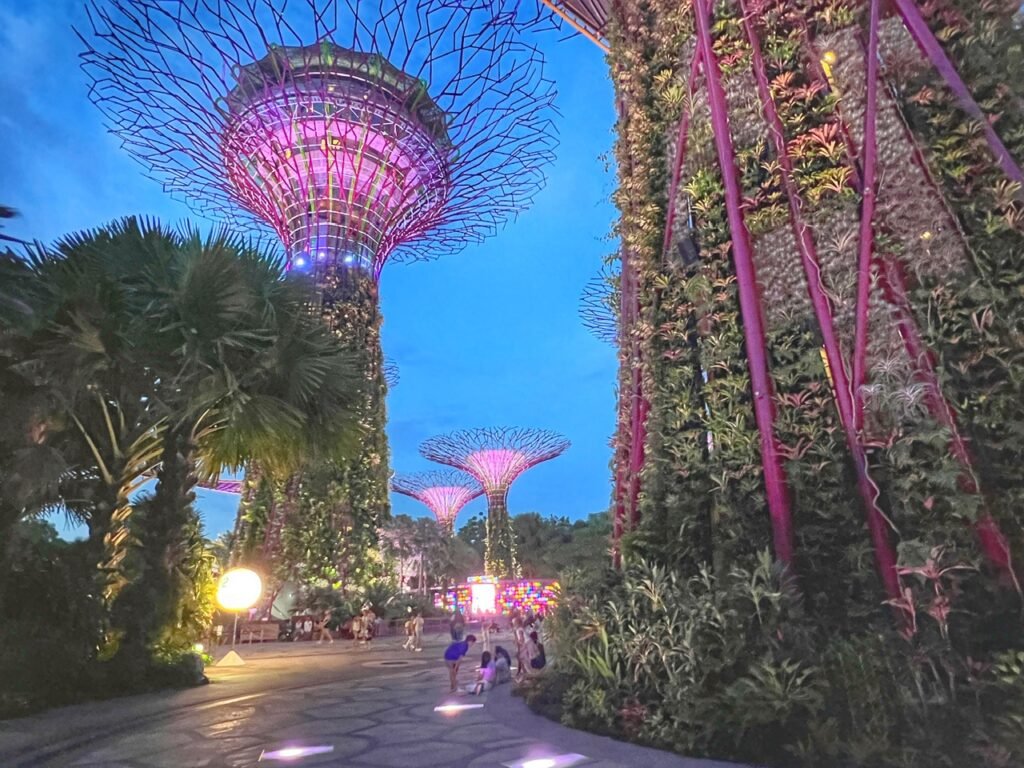
Heading into the super tree grove, you realize just how colossal they are compared to the real trees.
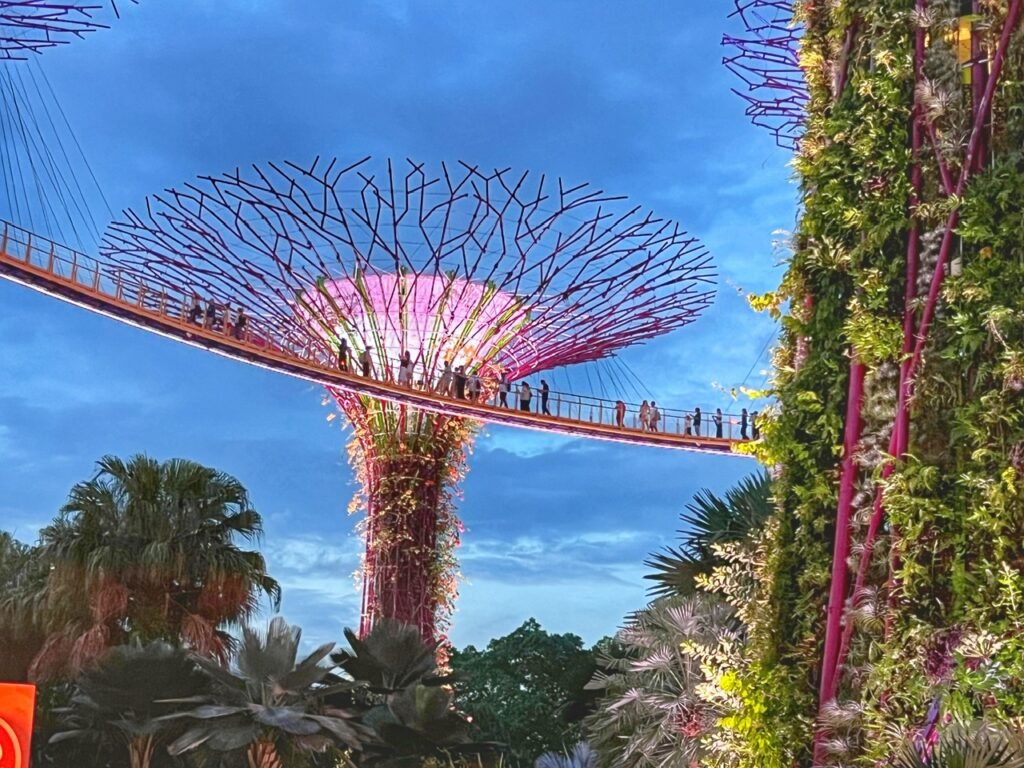
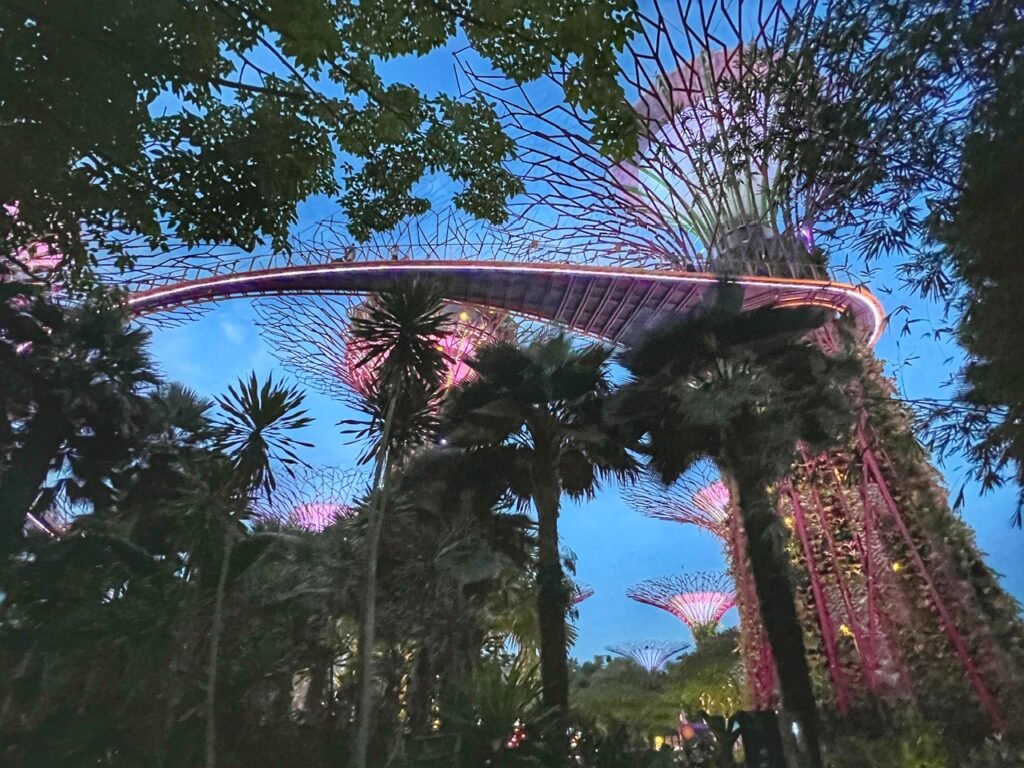
There is also a suspended aerial bridge known as the OCBC Skyway between two of the SuperTrees which you can glide across in your Insta dress for about $10 USD.


The lights twinkling overhead during the Garden Rhapsody show. The Borealis show, which transpires on Monday nights at 8:00 and Satruday/Sundays at 9:00 magnificently created floating light clouds hovering amongst the trees. It was cool, but we think we’ll still head to the Arctic for the real deal…
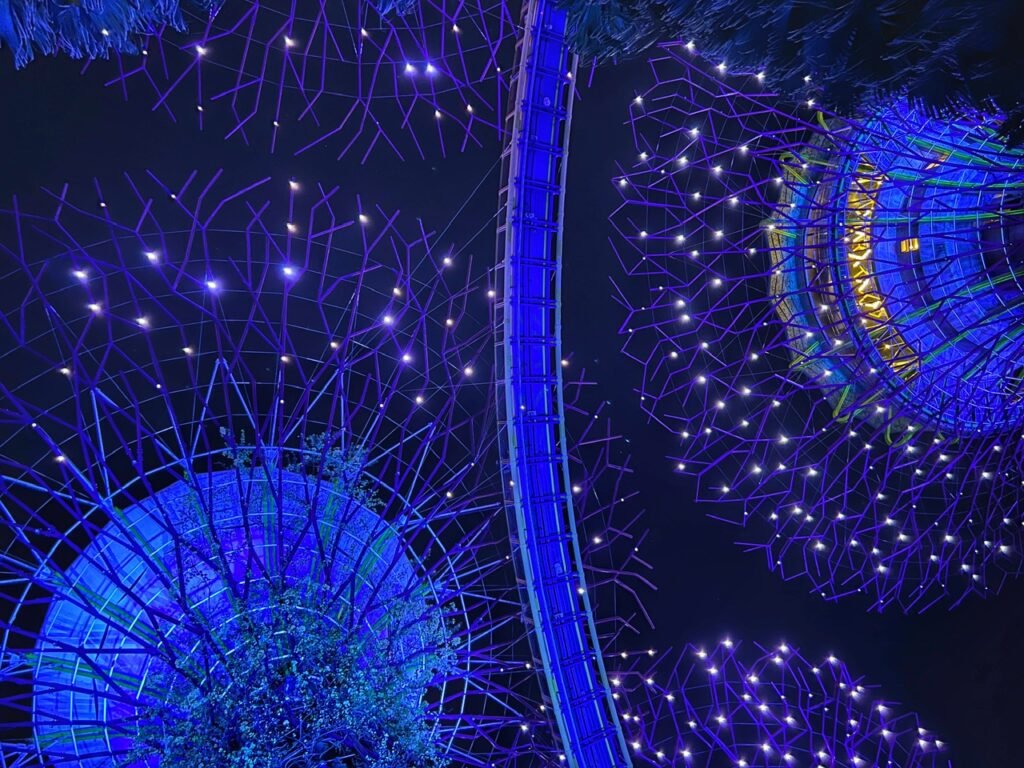
Garden Rhapsody takes place every night at 7:45 and 8:45. It includes a wide variety of light patterns and color sequences that range from gentle, soothing colors to vibrant, dynamic displays that make you tap your toe. It was a unique moment to lounge back underneath the towering vertical gardens…
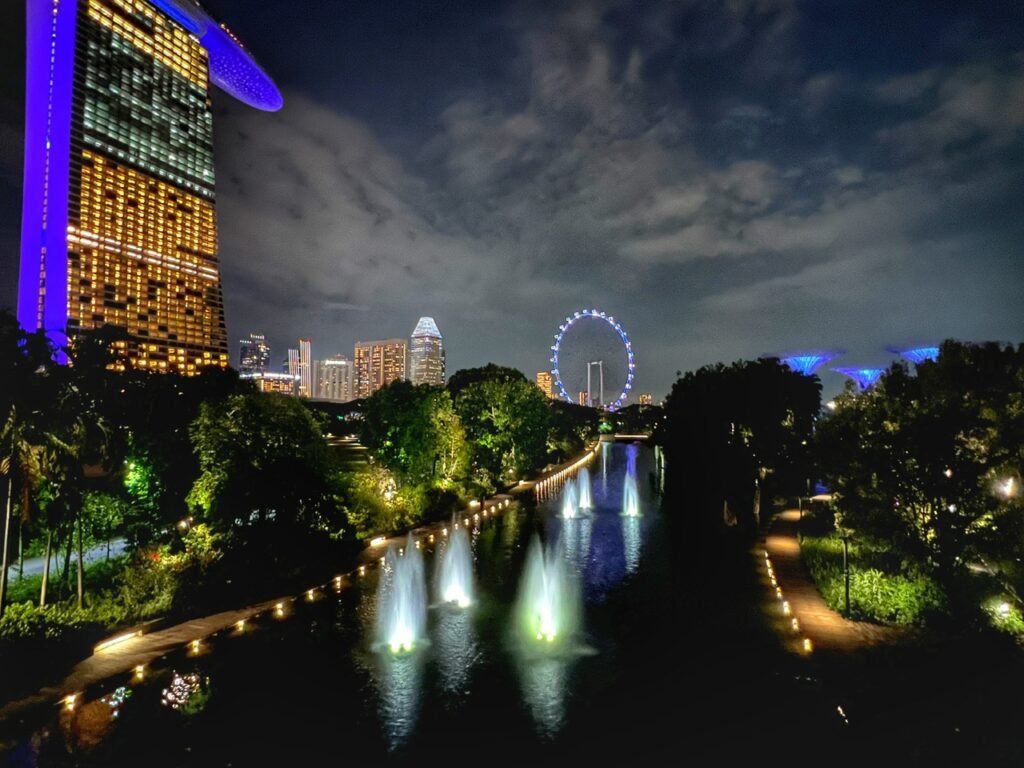
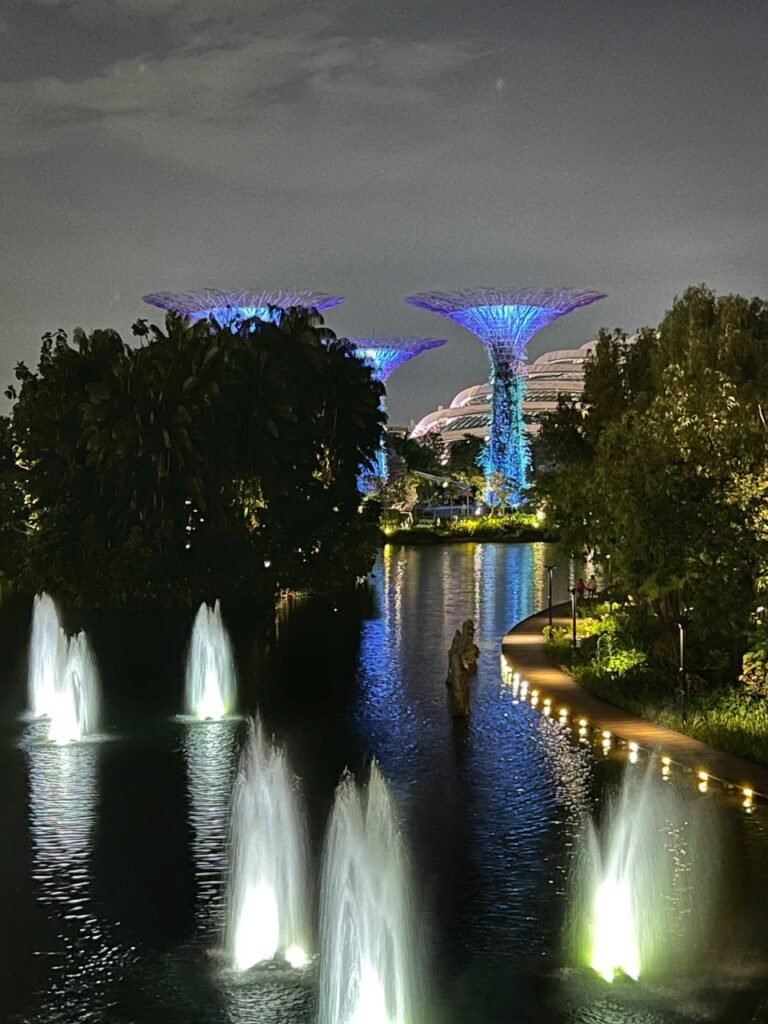

We’re so glad we visited at night! Heading to catch a bus after the show, was a stunning view of Marina Bay Sands and the Singapore Flyer.
The Marina Bay Sands Hotel & Financial District
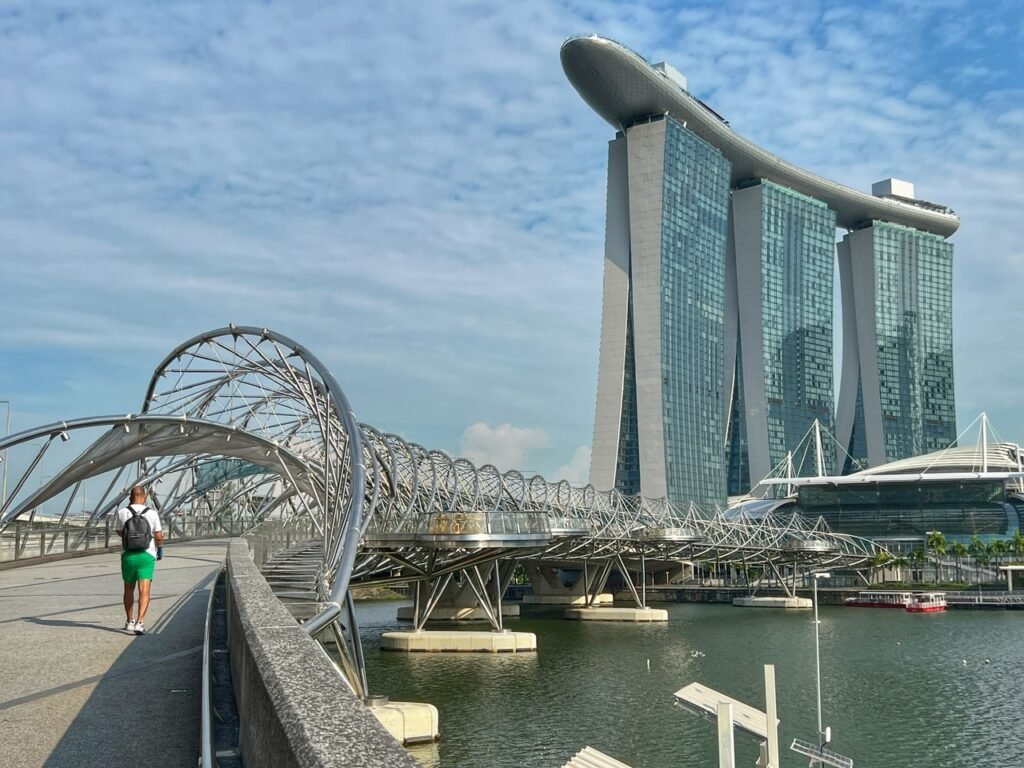
The Marina Bay Sands hotel and surrounding area is the landmark of Singapore and an icon that is showcased on many travel shows as an architectural marvel. The three iconic 55-floor towers are among the most complex buildings ever constructed. Each tower has sloping, as well as straight legs and is crowned by a giant surfboard on top which features arguably the world’s most famous infinity pool.
Nearby, there’s also other perplexing architecture, an ostentatious mall ringed by untouchable designers like Versace and Dolce & Gabanna where Mandy can peruse new $4 elephant pants, a mermaid/lion mixed breed which breaks Singaporean law by endlessly spitting, and plenty of hawker stalls for those who’d rather not spend $50 a plate at a “real” restaurant. Who? Us?
We took the bus for about $1 down to the 280 meter long bridge, in the shape of the world’s first curved double-helix where we ventured toward Marina Bay Sands and the financial district.

The view coming in offers a complete snapshot of all the main sites: Gardens by the Bay, the Singapore Flyer and Marina Bay Sands.

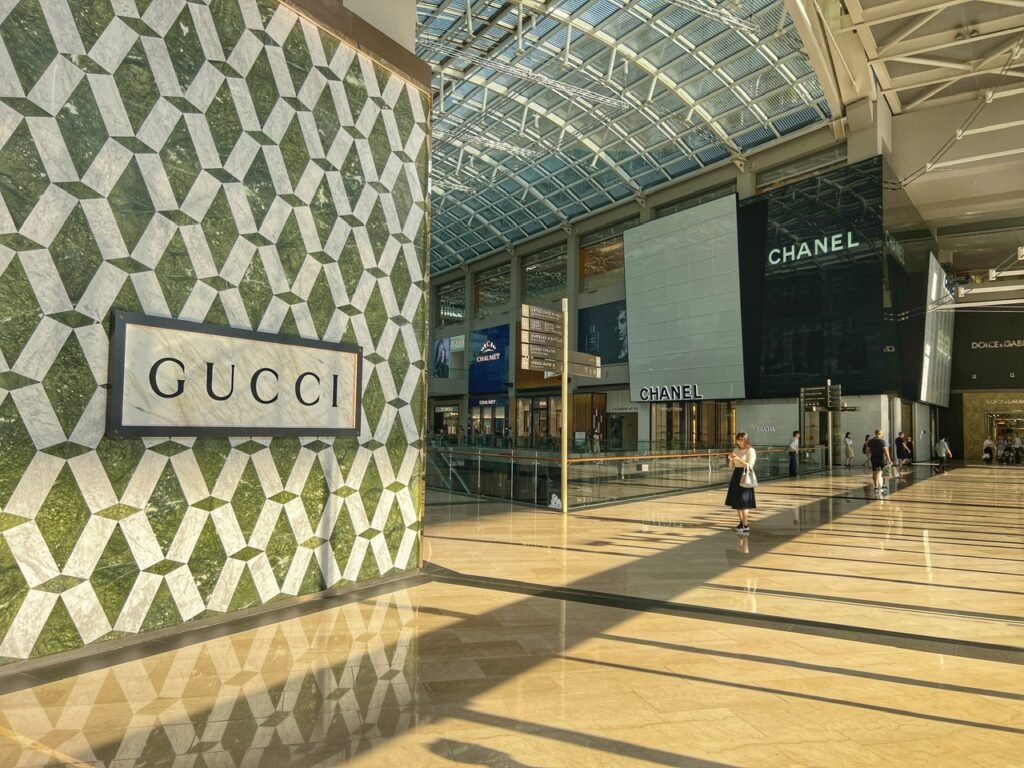
The Shoppes at Marina Bay Sands is mostly useful as an air conditioned god send, because god knows, we won’t be shopping there.
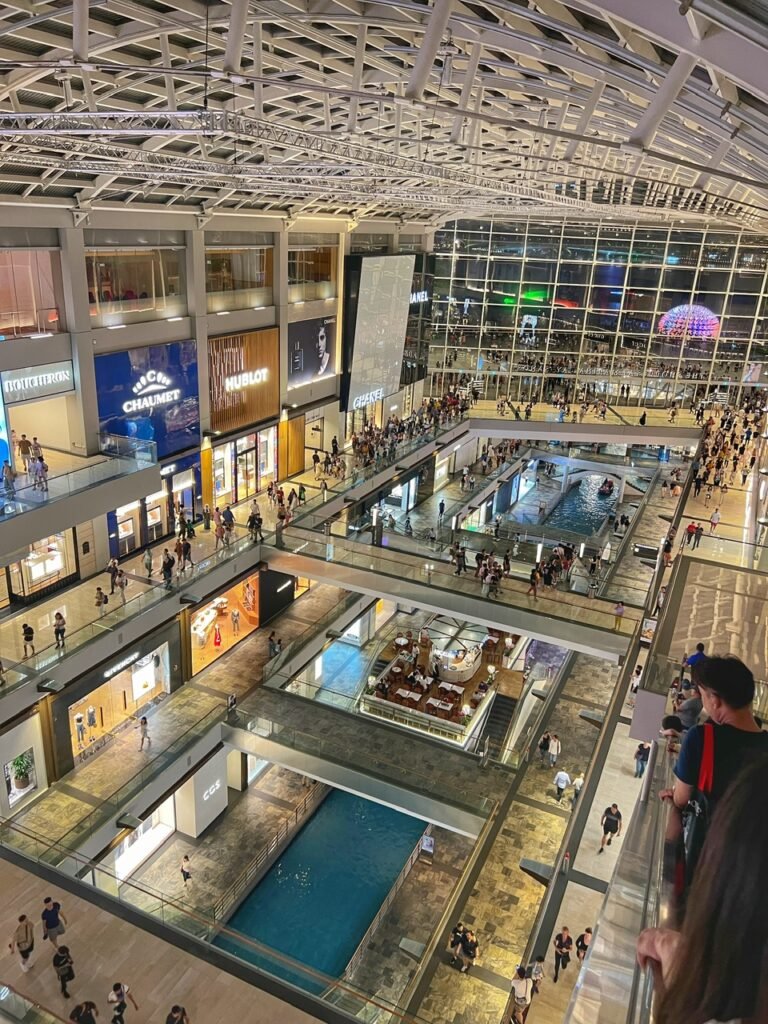
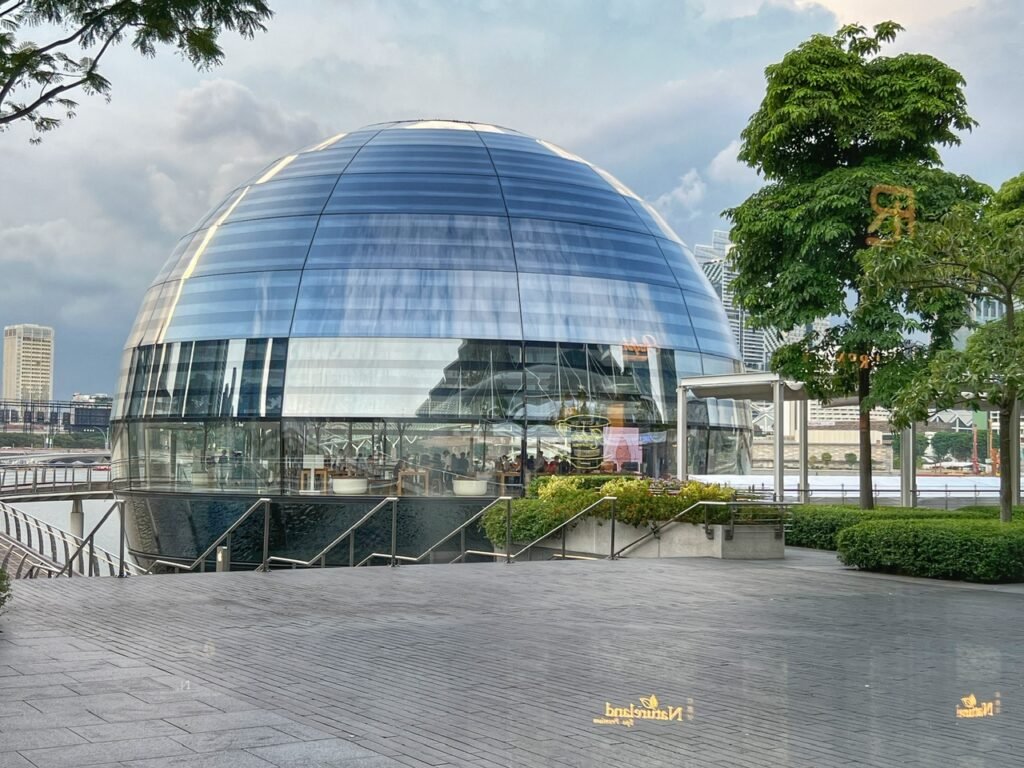
Unlike going up the middle like in most malls, the escalators line the sides for a panoramic view of all the capitalism. Speaking of capitalism, this shiny dome belongs to the Apple Store.
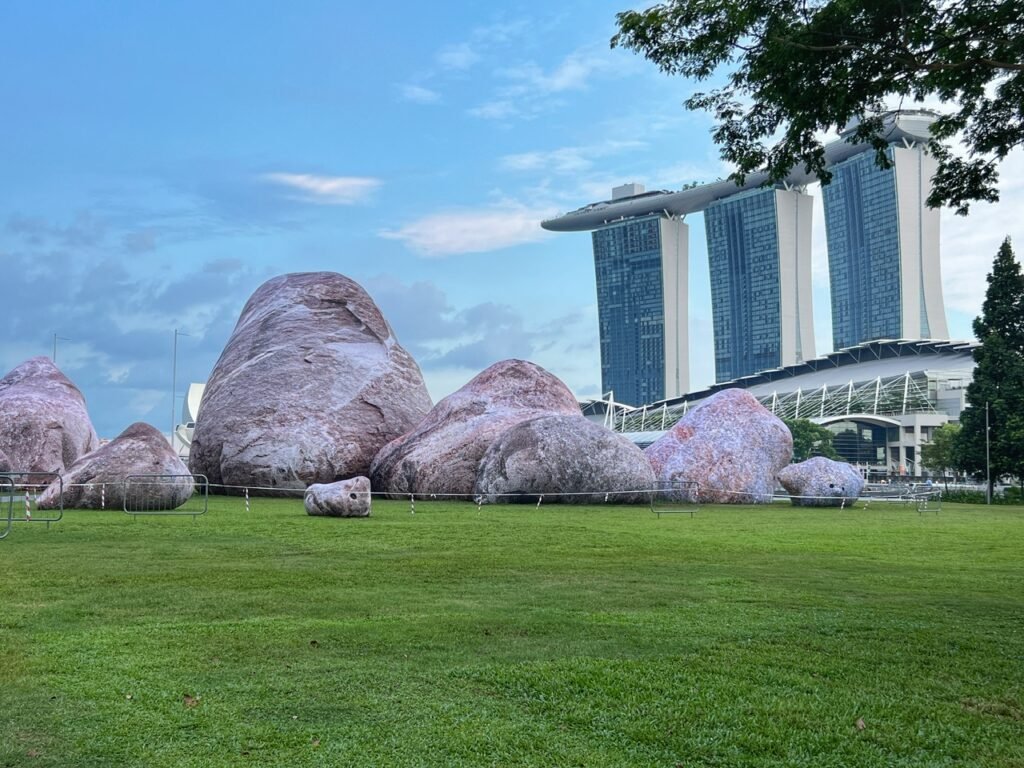
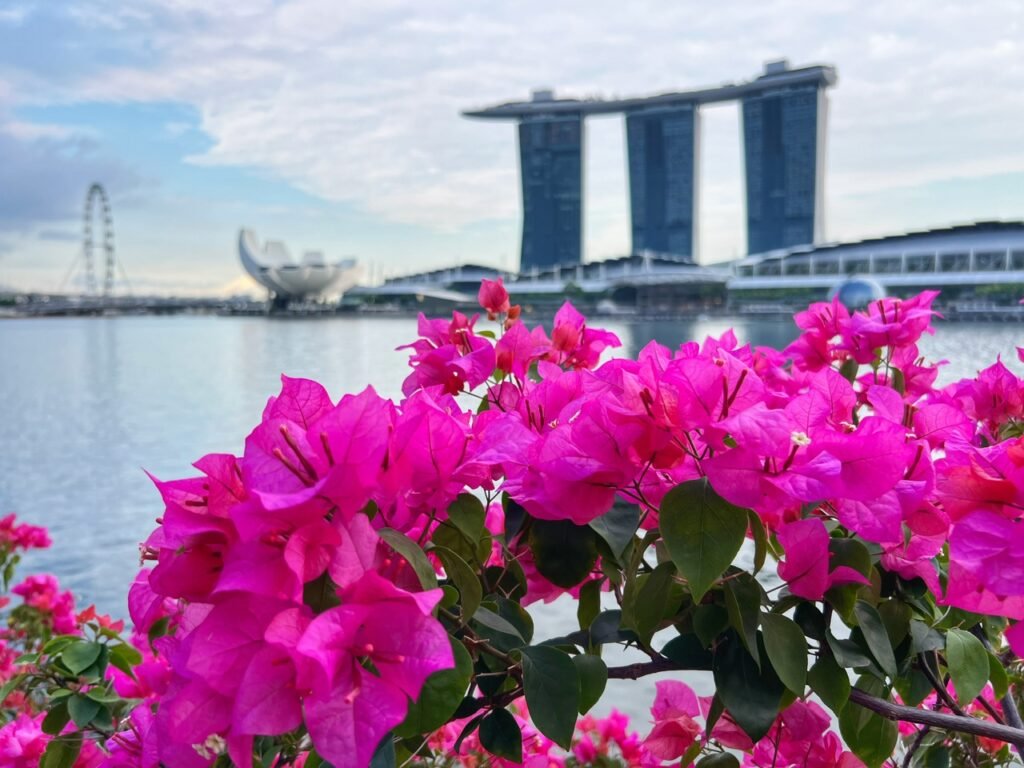
With all this, we were a little surprised to see piles of piles of pink rocks across the bay. But, nope, not rocks. According to the plaque, they are, “air-filled inflatables which carry the allure and mystery of mountains within them.
Encountering these quiet but majestic boulders which are typically found in untamed landscapes brings a sense of awe and wonderment of existence into the urban experience.” Mmmm…ok. Is it possible this city has TOO much money? 🧐

Yes, we were there too, perspiring like roasted potatoes.

The Merlion is the official mascot of Singapore, which is depicted as a mythical creature with the head of a lion and body of a fish. However, along with the Little Mermaid of Copenhagen and the Manneken Pis statue of Brussels, it’s also known as one of the “Three Major Disappointments of the World” according to Atlas Obscura, which we might agree with. At the very least, it is certainly underwhelming after all the hoopla surrounding it. But that doesn’t stop hundreds of tourists from thronging it.
The fish body represents Singapore’s origin as a fishing village when it was called Temasek, which means “sea town” in Javanese. The lion came fromSang Nila Utama, who was the first person to discover Singapura and was supposedly met with a lion when he got off the ship. Unsurprisingly, sounds like there’s a couple versions to that story though. (Wikipedia)
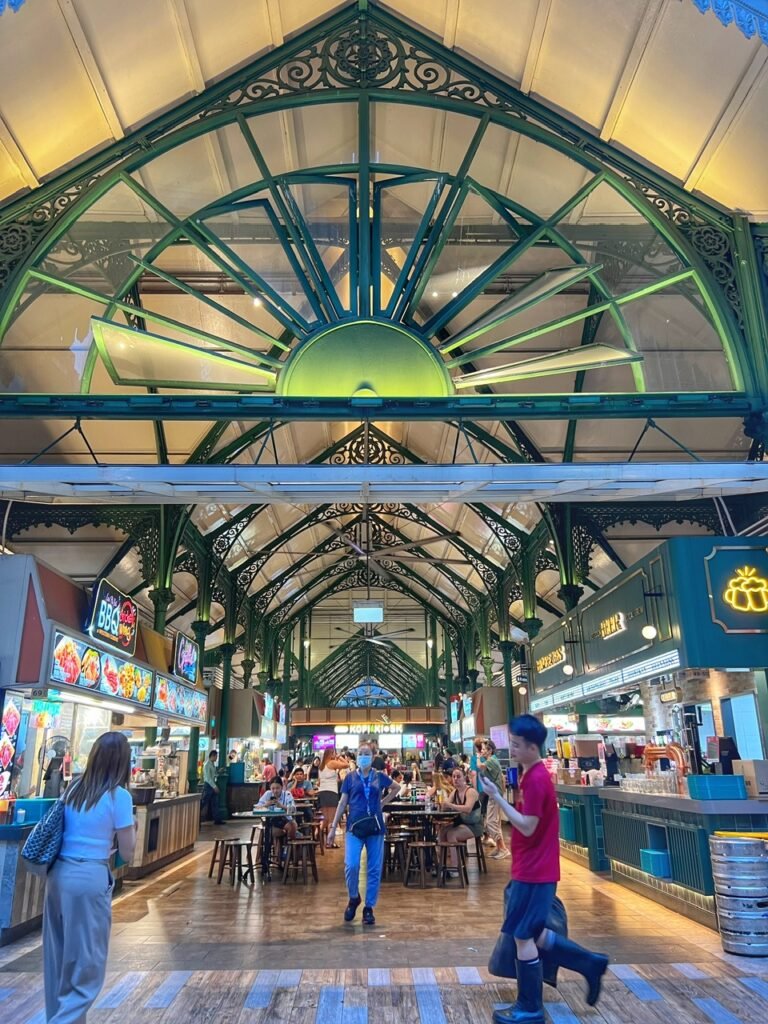
Entering the Victorian covered Lau Pa Sat hawker stalls, definitely the biggest and with the most overwhelming selection we’ve seen yet.
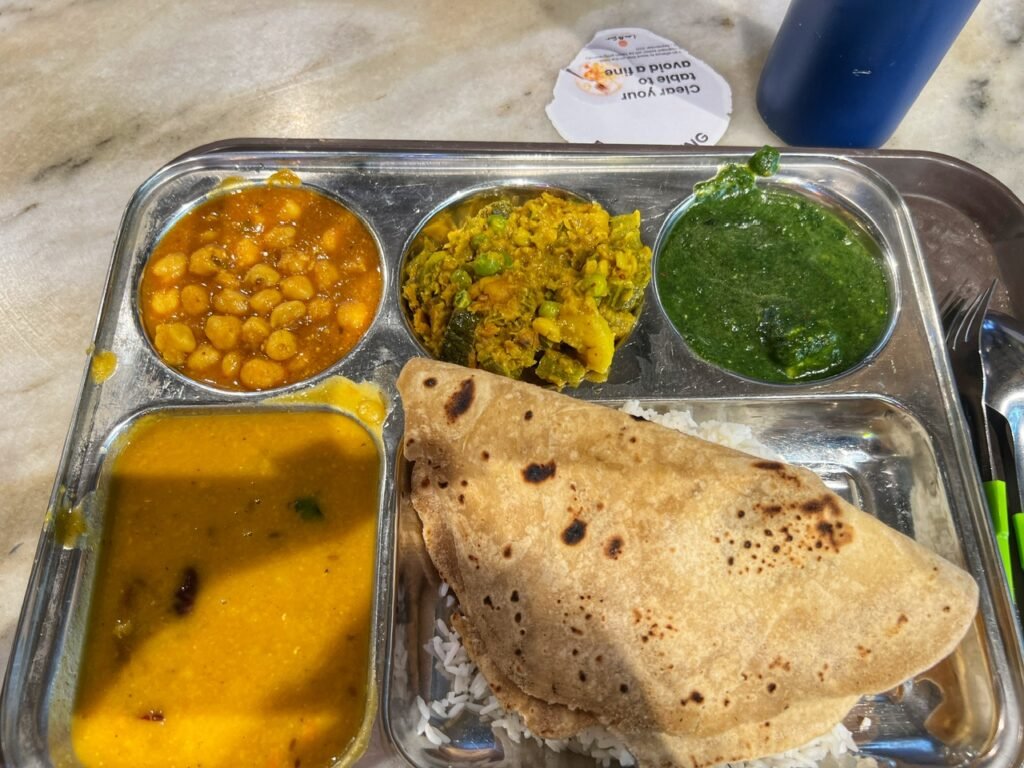
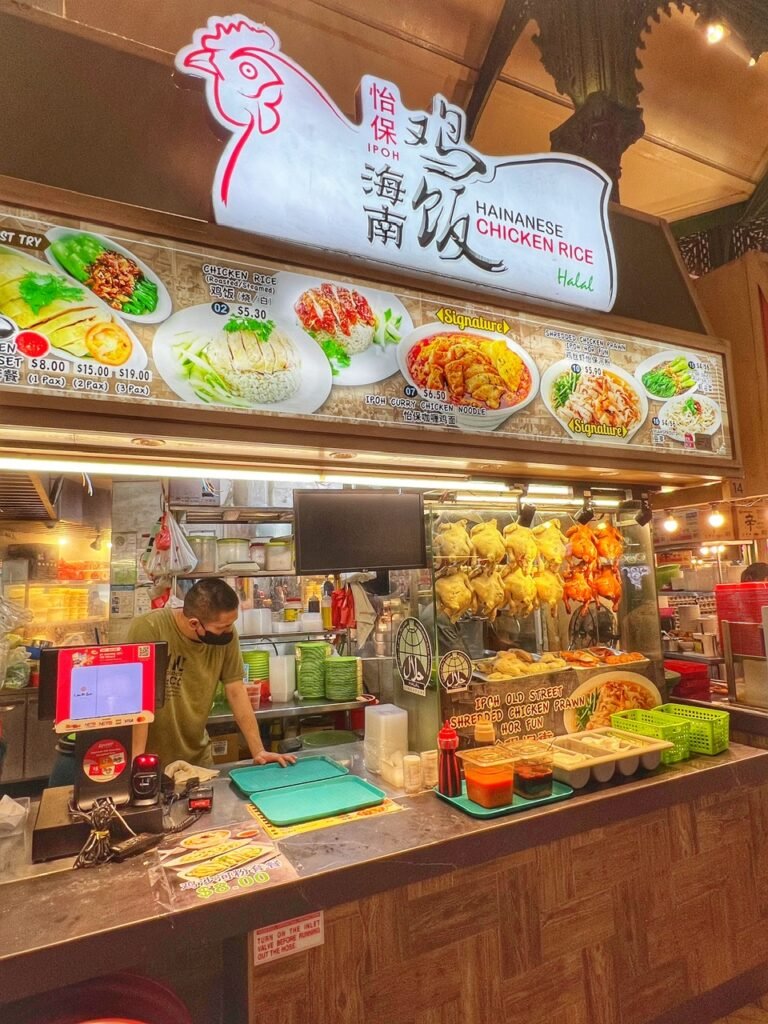
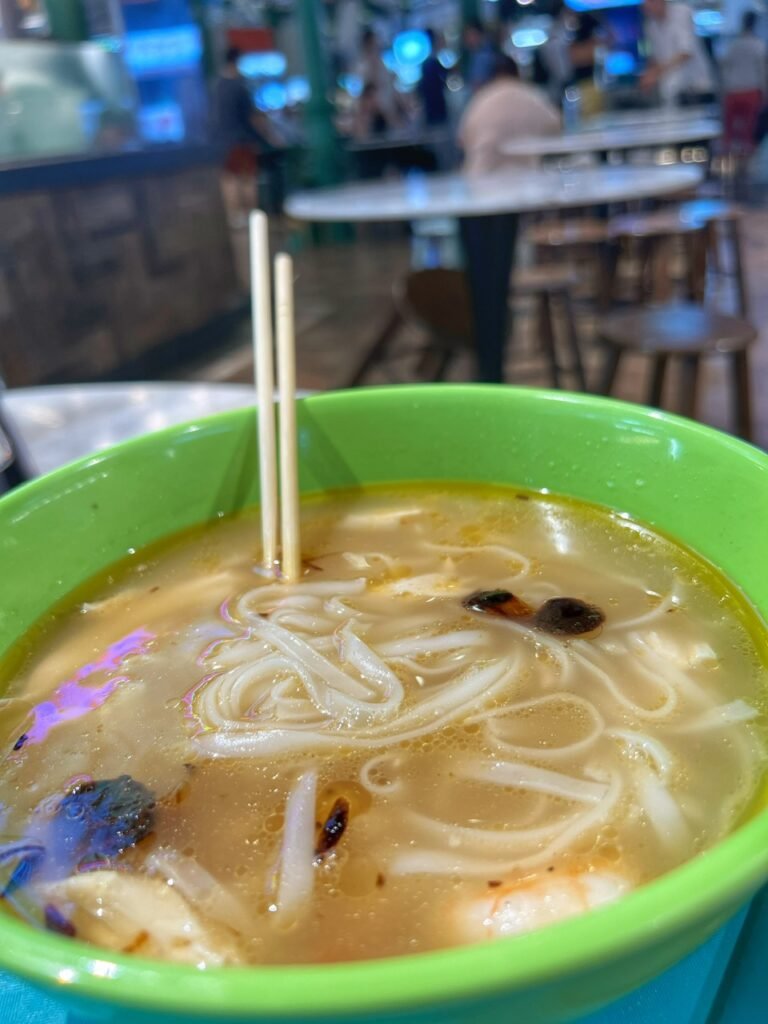
Mandy settled on an amazing Indian veg platter for about $5.50 USD. Thankfully considering Indian is mostly eaten with your hands, she remembered to bring napkins this time….a MUST for any hawker stall…and Greg got Hor Fun, a shredded chicken and prawn soup for $4.30. Seriously. Who says Singapore has to be expensive?!
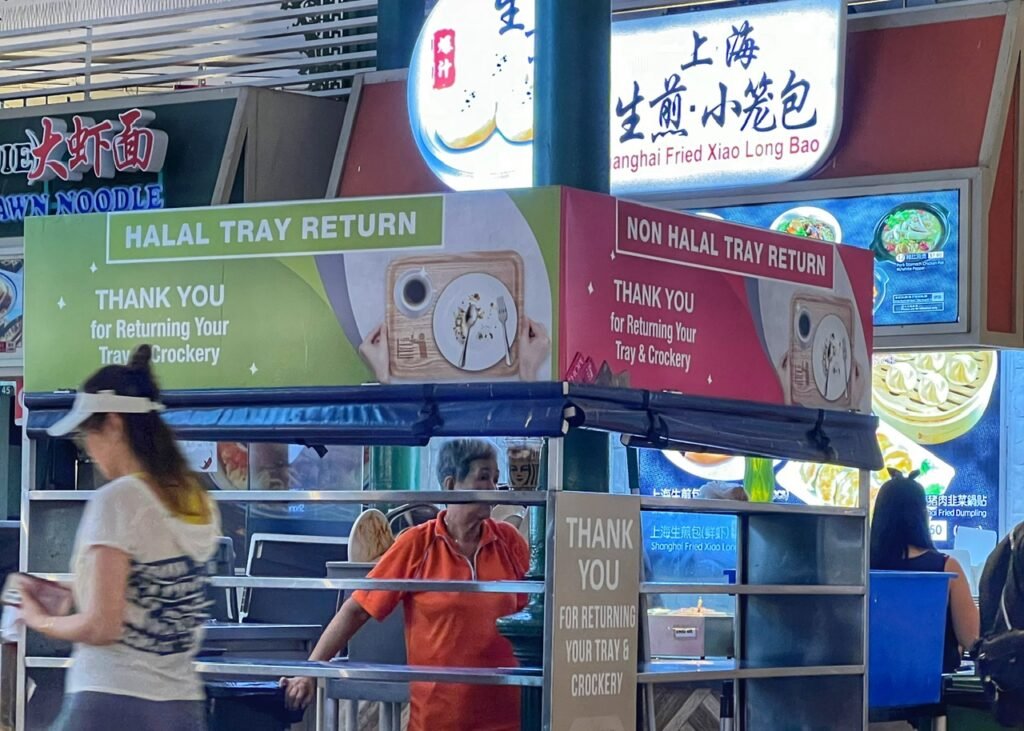
Of course it could get expensive if we were fined because we didn’t clean up our “table litter.” Also make sure you place it in the correct tray hole for a halal or non-halal wash job. The challenge is, it’s likely that at least 80% of tourists don’t know what halal means. For the record, Halal is an Arabic word which means lawful or permissible. Any food or drink which falls under this category is permitted for Muslim consumption. Examples of Halal food include vegetables, spices and meat deriving from animals slaughtered in accordance with the Islamic Law. Bottom line…if you’ve had a pig on your plate, definitely don’t slide it in the halal section.
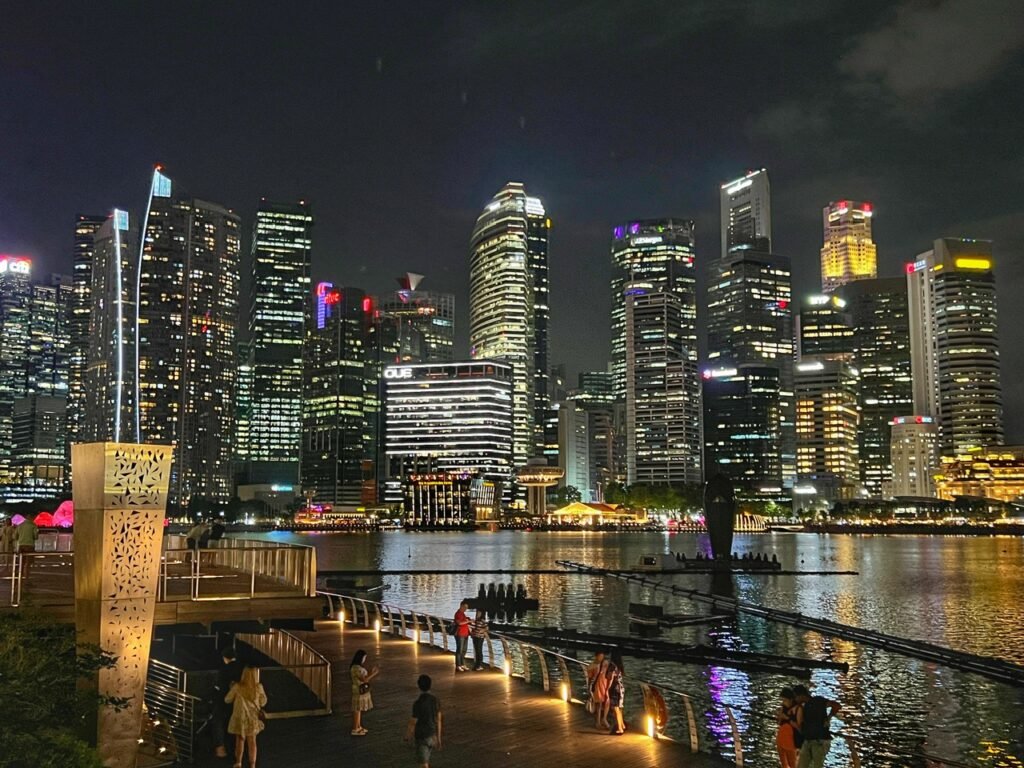
The financial district by night. Splashy….
Little India (Our Favorite)
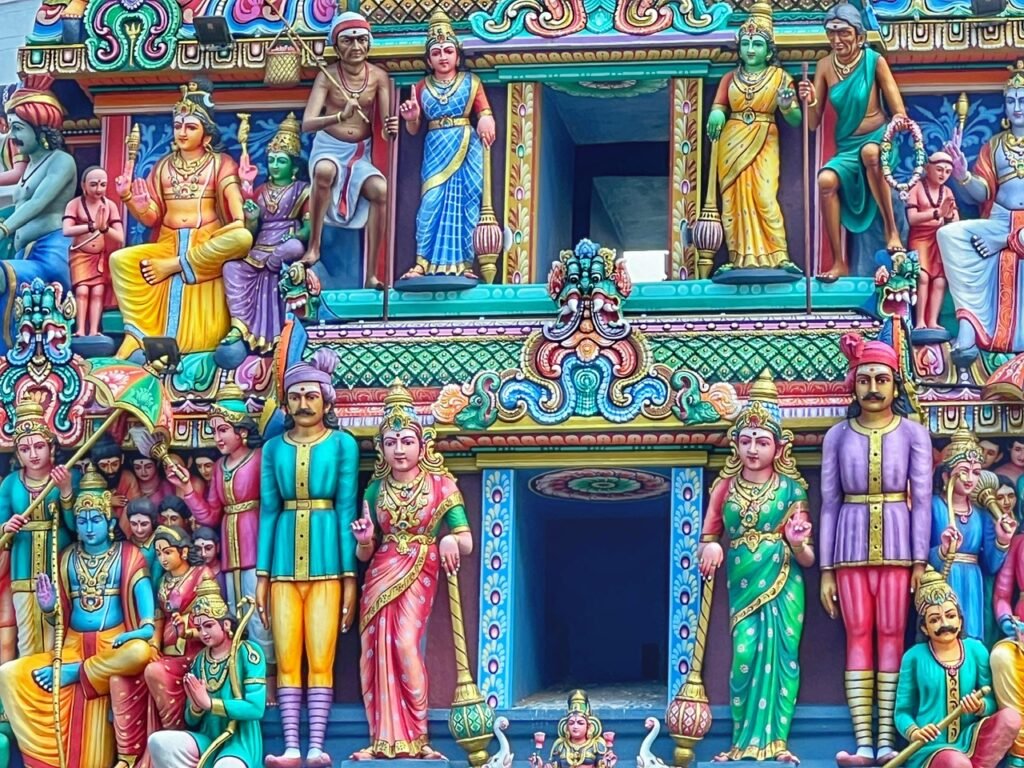
As one of the world’s most prosperous countries, Singapore feels strange after three months in Vietnam. It’s a bit extravagant, very polished, very organized, very clean and very rule abiding. All things which Vietnam is definitely not. 🤣 Thus, by this point we were kind of having mixed feelings.
That is, until we arrived to the pulsating enclave of Little India…which, with very few tourists and majority local Indian expats, felt more traditional, more relaxed and more our speed. But this India, of course was a Singapore version. This meant it was also clean, organized, polished, with no fear of Delhi Belly, AND no sad cows wandering in the streets. Sign us up!
Sri Veeramakaliamman Temple, above, is an undeniable canvas of art. Its was built by Indian pioneers living in the Serangoon district in the 19th century, and is dedicated to Kali the Hindu goddess and destroyer of evil.
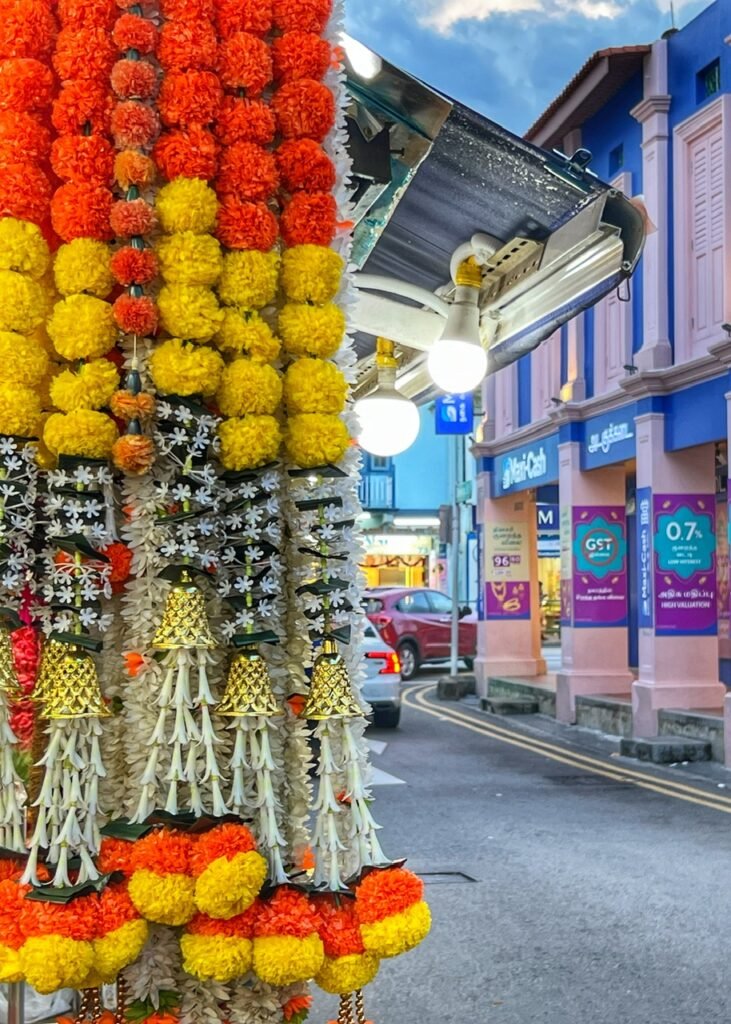
We appreciated the details that took us right back to India like the floral vendors, complete with marigold garlands, ladies bustling down the streets in vibrant saris, tantalizing aromatic spice fragrances, and lively Bollywood music bursting out of venues at sporadic and quieter-than-real-India (because they’ll probably get fined) intervals.

Speaking of art, Little India is also loaded with the street variety.
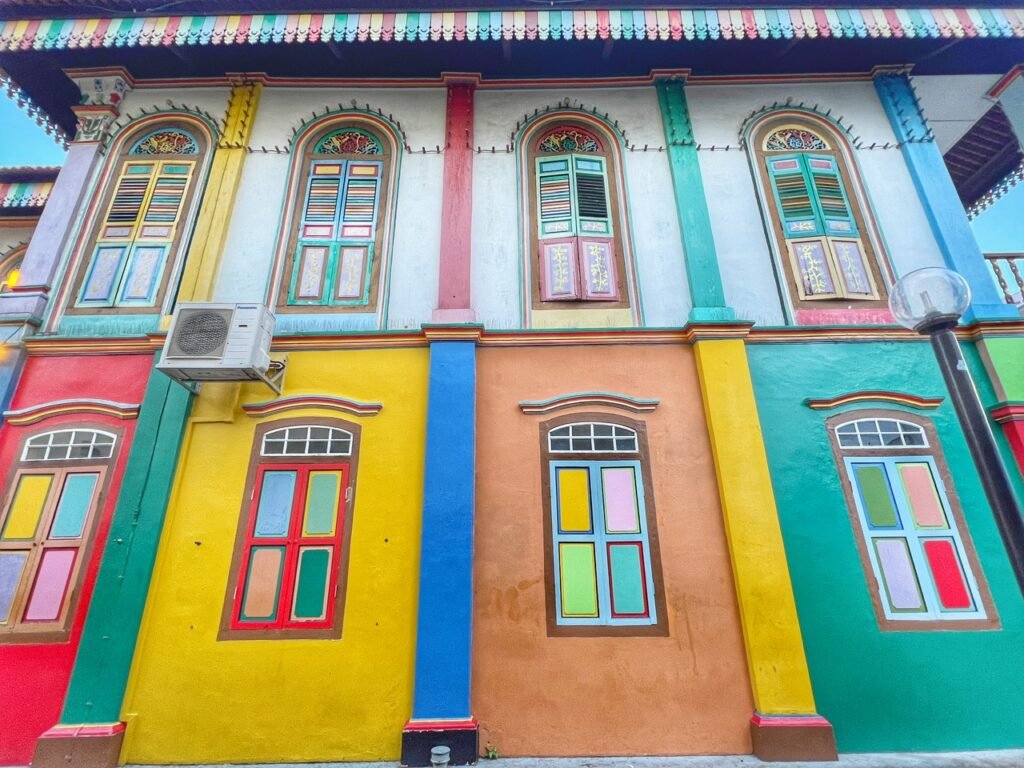
The unmissable Crayola box of Little India is the Former House of 1900 Tan Teng Niah, the last surviving Chinese villa in Little India. This former house of Tan Teng Niah embodies an often overlooked story of the days when small Chinese industries operated alongside the cattle and rattan businesses of Little India.
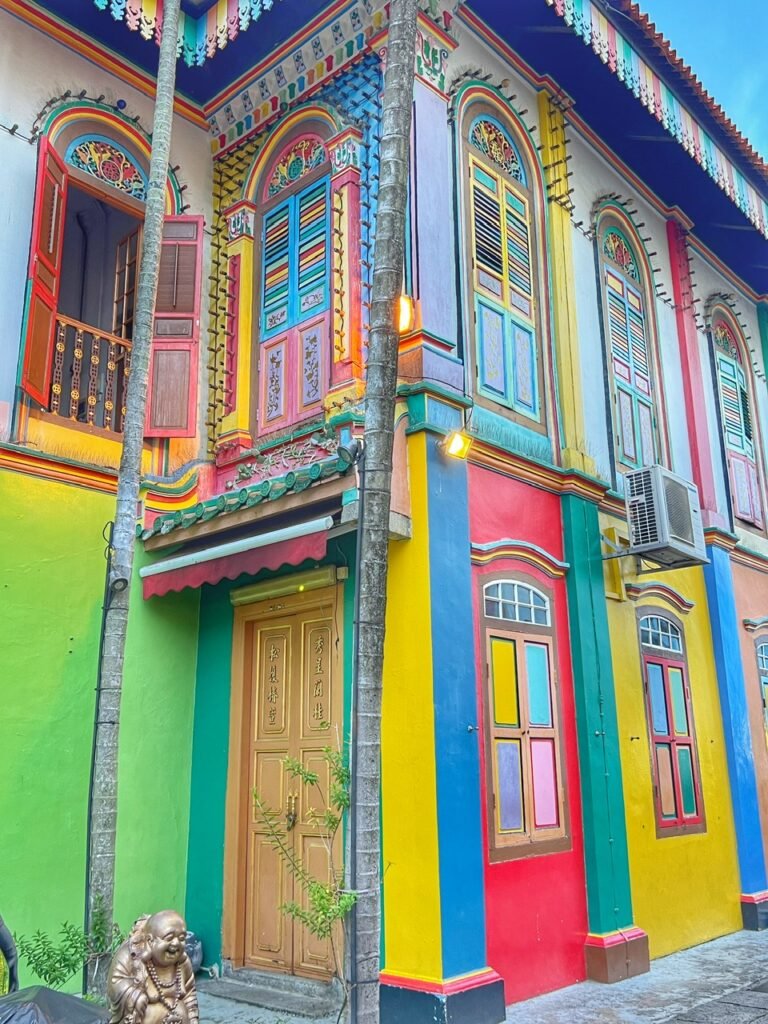

Tan Teng Niah was a towkay (Chinese businessman of good standing) who owned several sweet-making factories along on this road that used sugarcane to produce sweets. It’s hard not to feel jolly when you stumble upon its exterior.
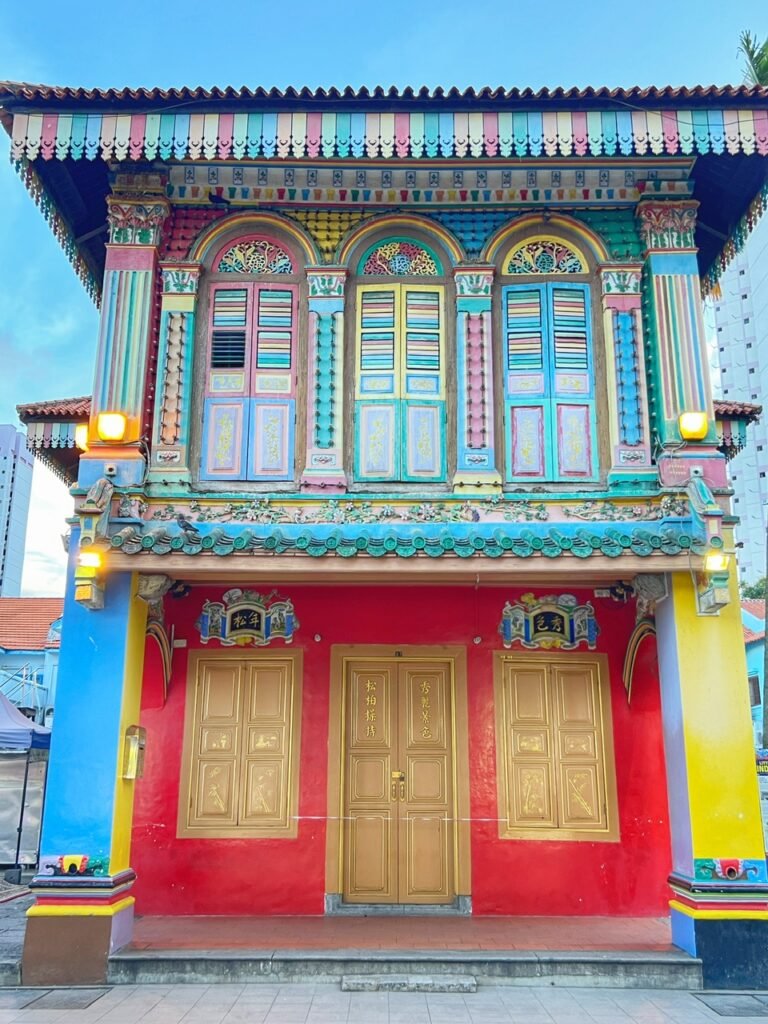
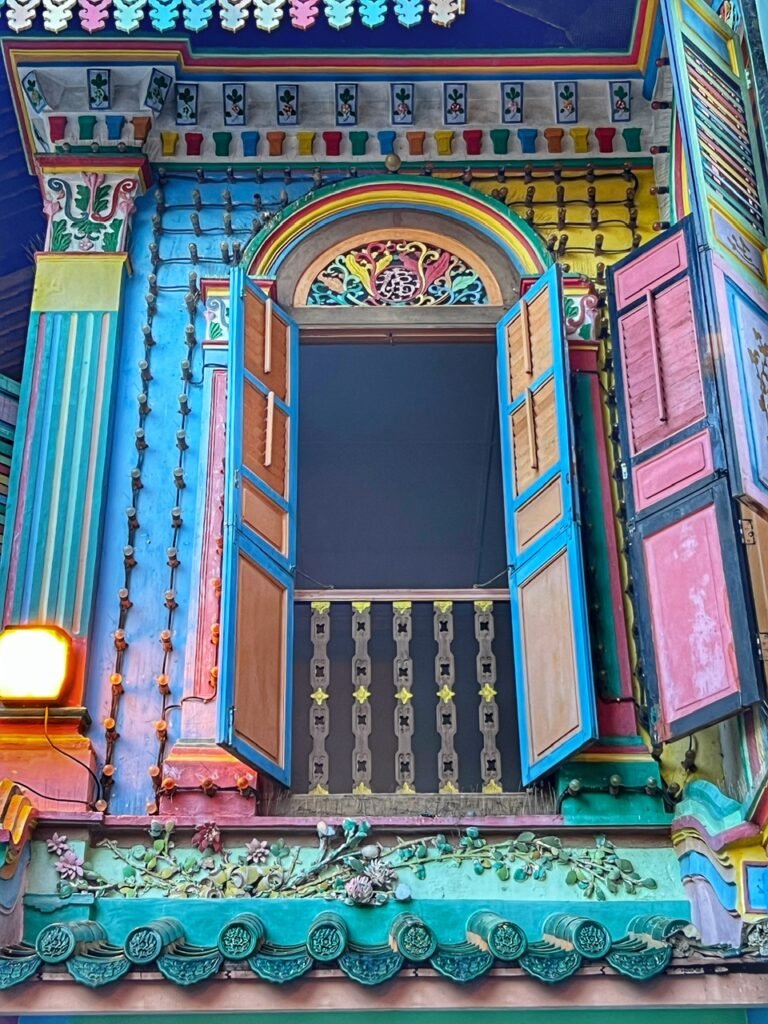
What an extraordinary blend of color, not to mention the detail.

And this wasn’t the only place with these color pops…
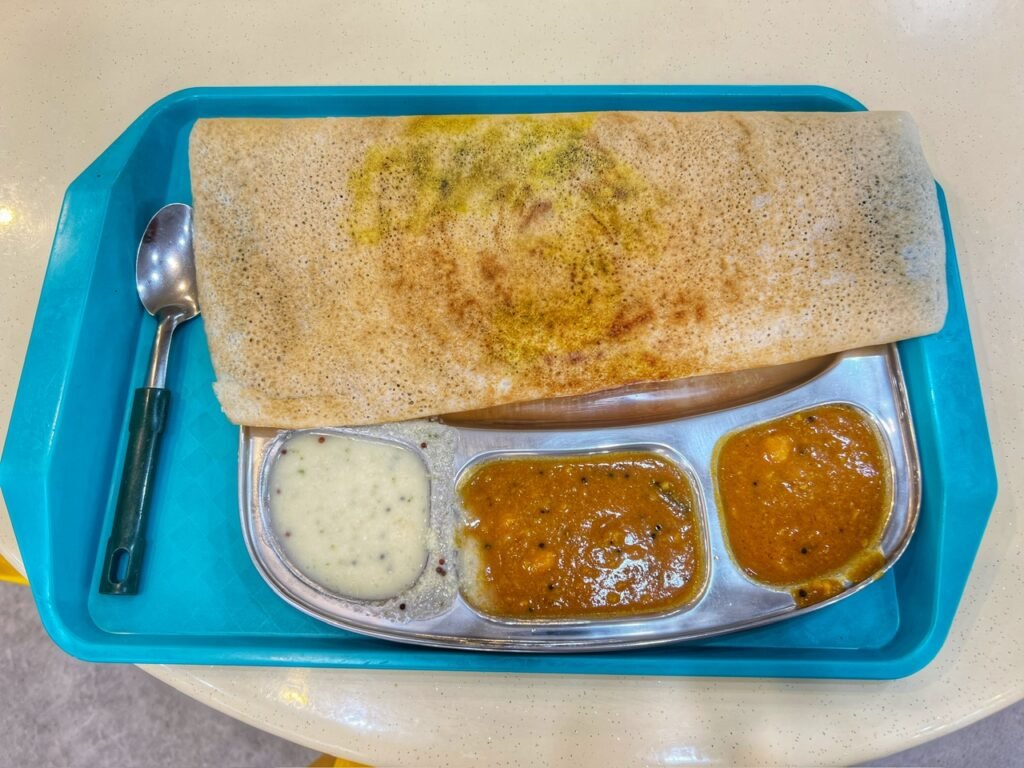
Of course we had to grab Indian while in Little India, which consisted of a Masala Dosai for about $2.50 USD. Delish!

We loved being swept in the buzz and bustle of the neighborhood.


More color splashes along the street..
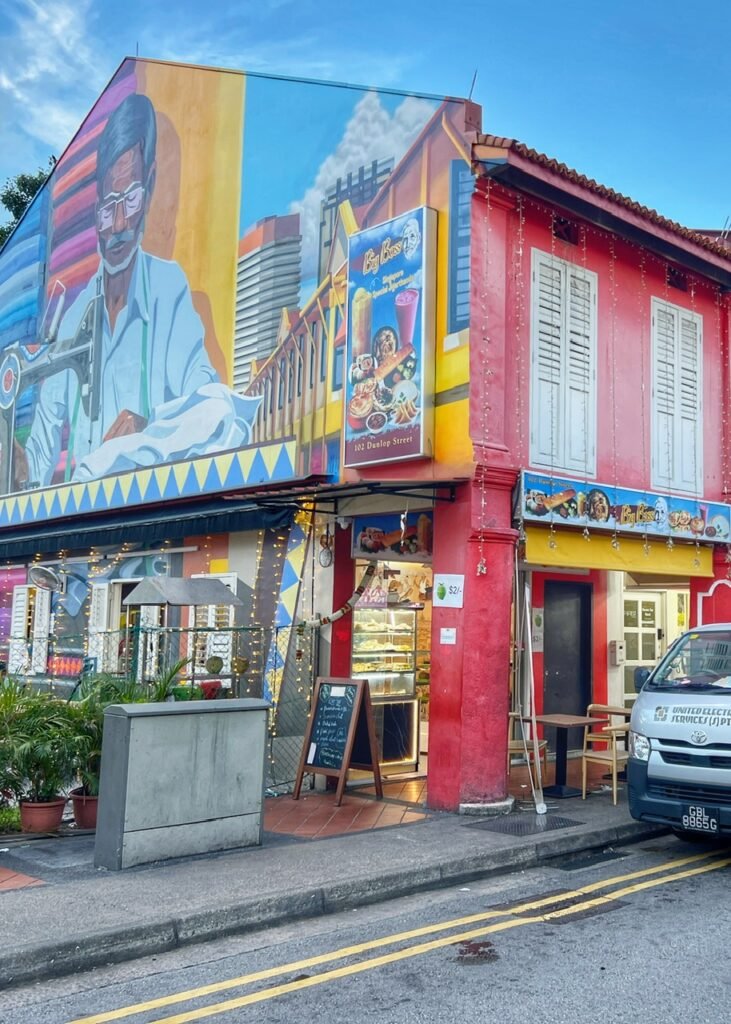
…and murals that speak to the age old trades and crafts of the people.

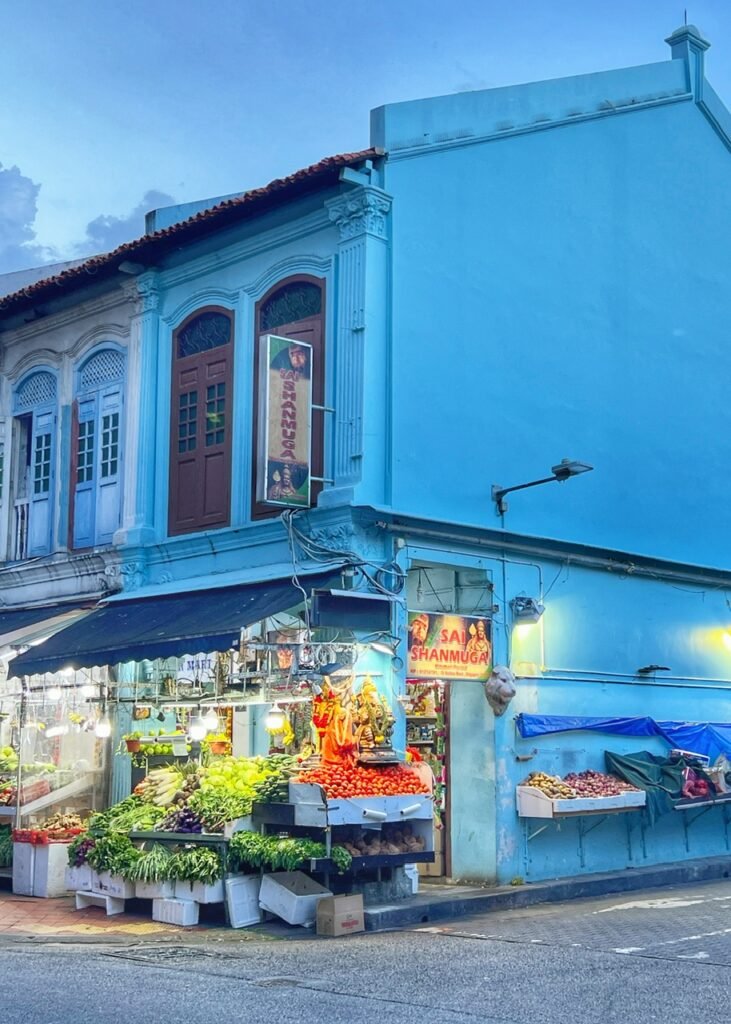
Of course you’ll likely never find a commercial street in India that looks this empty. 🤣 Piles of produce, which seem cheaper in this area than elsewhere.
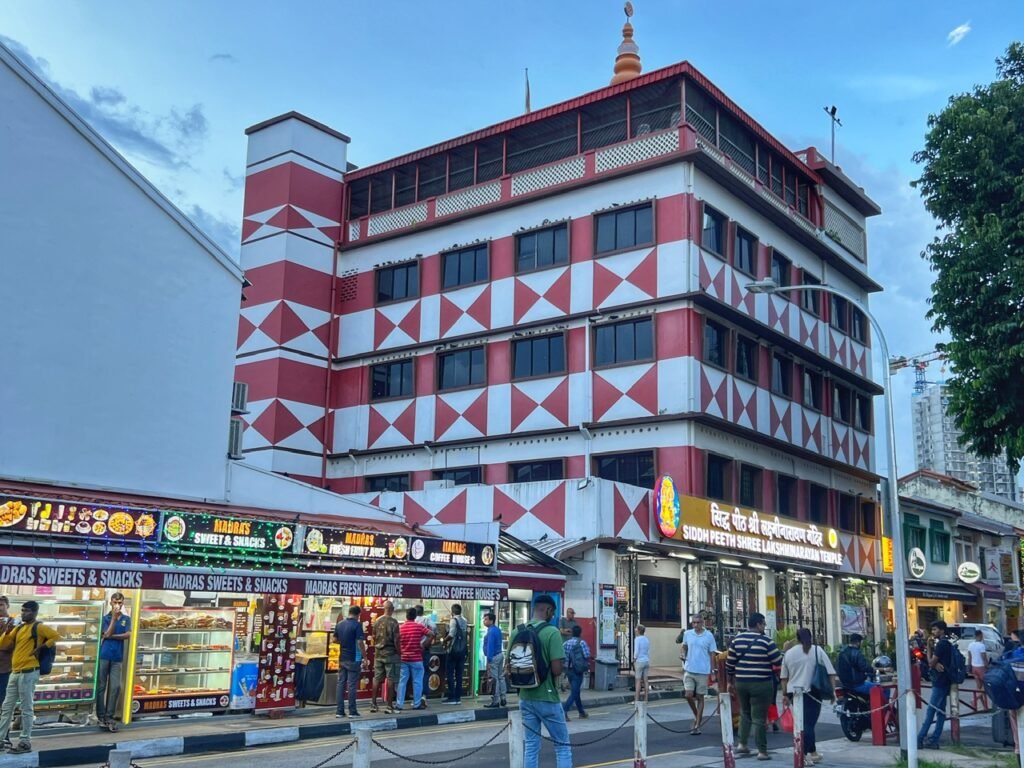
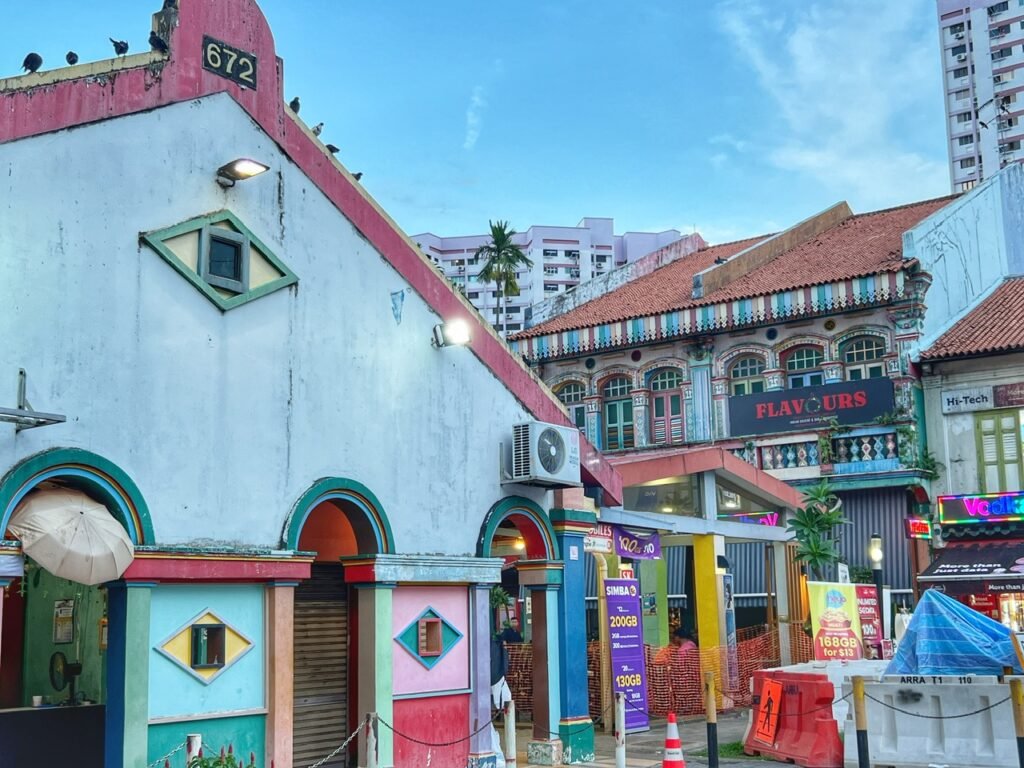
Another temple, packed with worshippers when we strolled by.
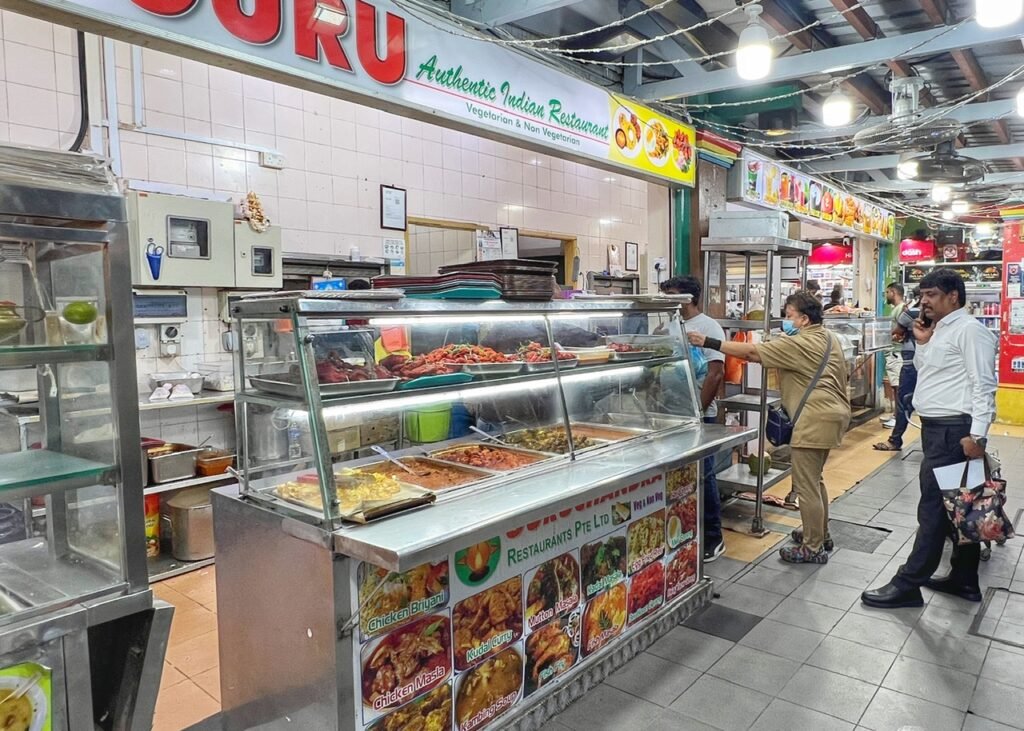
The food selection is a vegetarian dream.
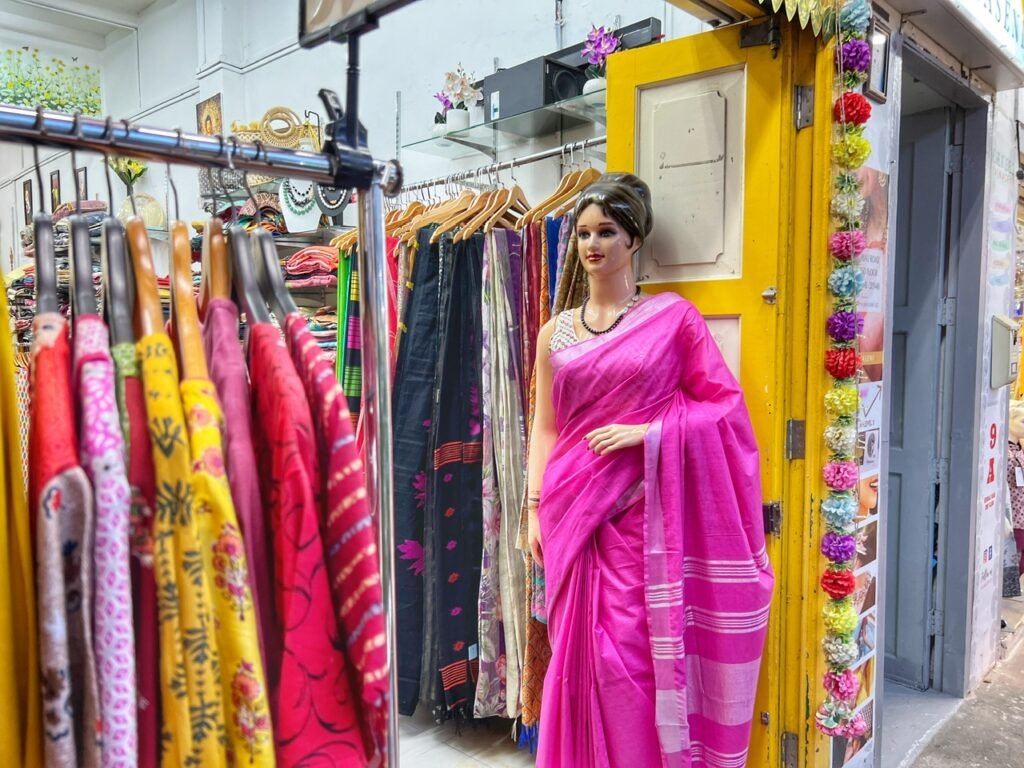
Also, if you forgot your sari, you can buy one here!

Even the Western Union is cute! Looks like Scoot Airlines employees though…
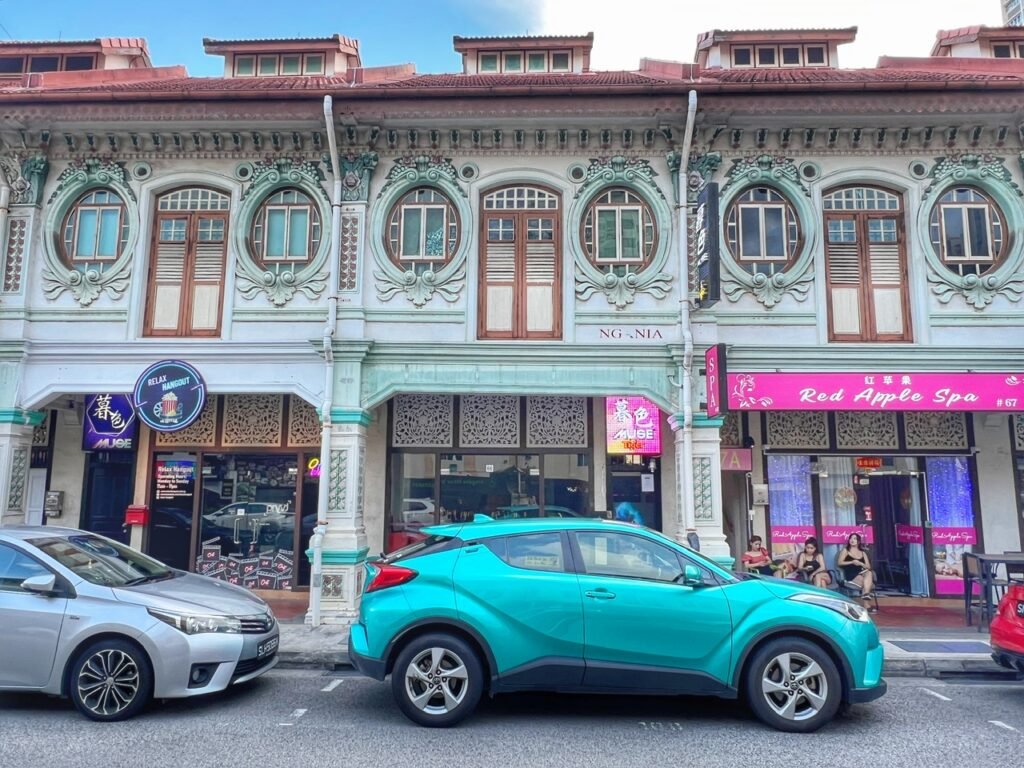
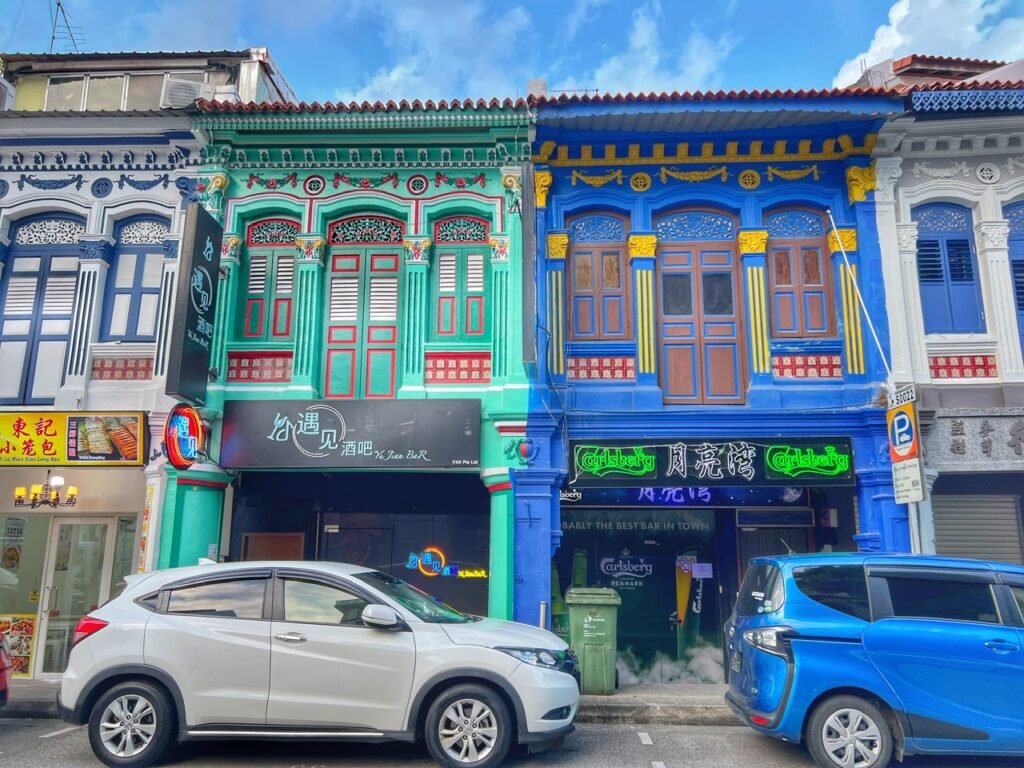
While in Little India, it’s also worth having a walk in the Jln Besar area where you will find more uniquely accessorized shop fronts, and yes, more shades of the rainbow.

Check out the tile balconies on this one.

The Malabar Muslim Mosque almost perfectly matches the sky in this neighborhood.
Arab Street
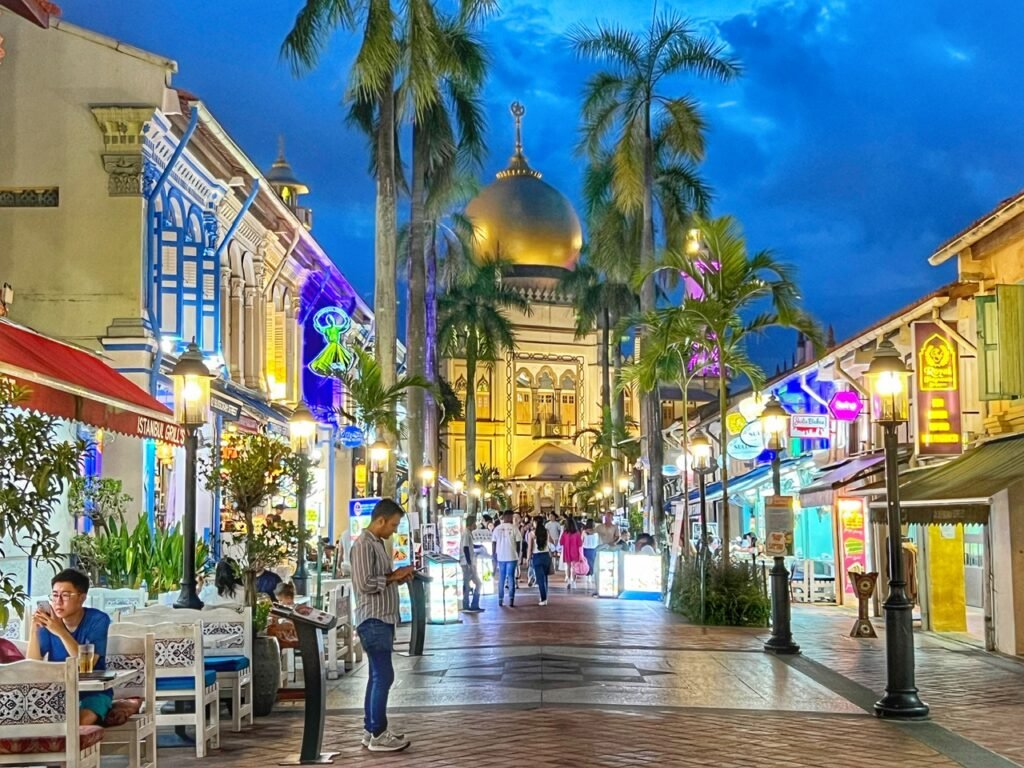
We love that Singapore is a multiracial and multicultural Asian melting pot and wanted to explore as many sub cultures within as we could. With its opulent golden crowned mosque, fetching historic shop fronts, a treasure trove of Middle Eastern goodies, rugs and fabrics, and wafts of kebab twirling on the spit, another area of Singapore we quickly became enamored by was Arab Street, aka Kampong Glam. It was seriously like being transported to a whole new world….pardon the cheesy Aladdin reference…but certainly one we definitely didn’t expect to see in Singapore.
What was even more curious, was then wandering a few more steps onto Haji Lane with its explosion of murals and Bali Lanes where rows of bars and restaurants melded together under the collective glow of black lights.

This whole area is rich in history dating back to the early 19th century. And no exception is Bali Lane, named after of course the island in Indonesia which reflects the cultural diversity of the area. Originally a residential area for wealthy Arab merchants, Bali Lane evolved over the years into a bustling commercial and cultural hub. Today it’s a notable place for night life and a good place to break out those glow sticks in your backpack you’ve been hauling around.
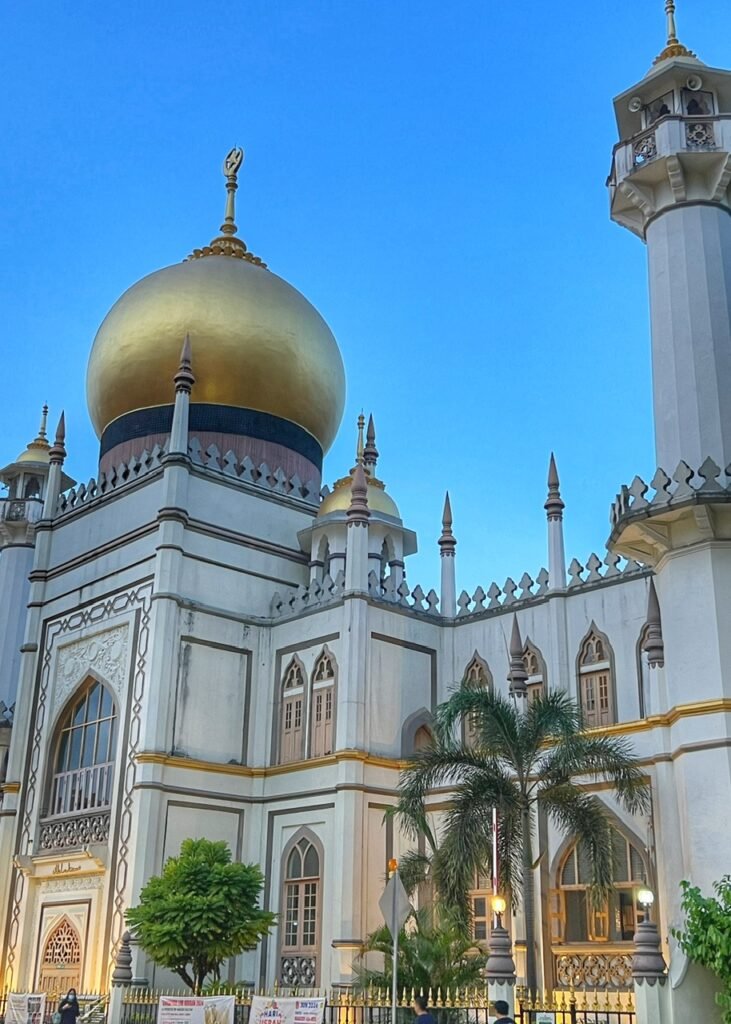
Nearby Arab Street was a little more our flavor, although it lacked the authenticity that Little India had and was definitely more polished for tourism. That said, not too many tourists seemed to make it up this way, which is too bad considering it’s gorgeous Sultan Mosque, which is 200 years old in 2024.
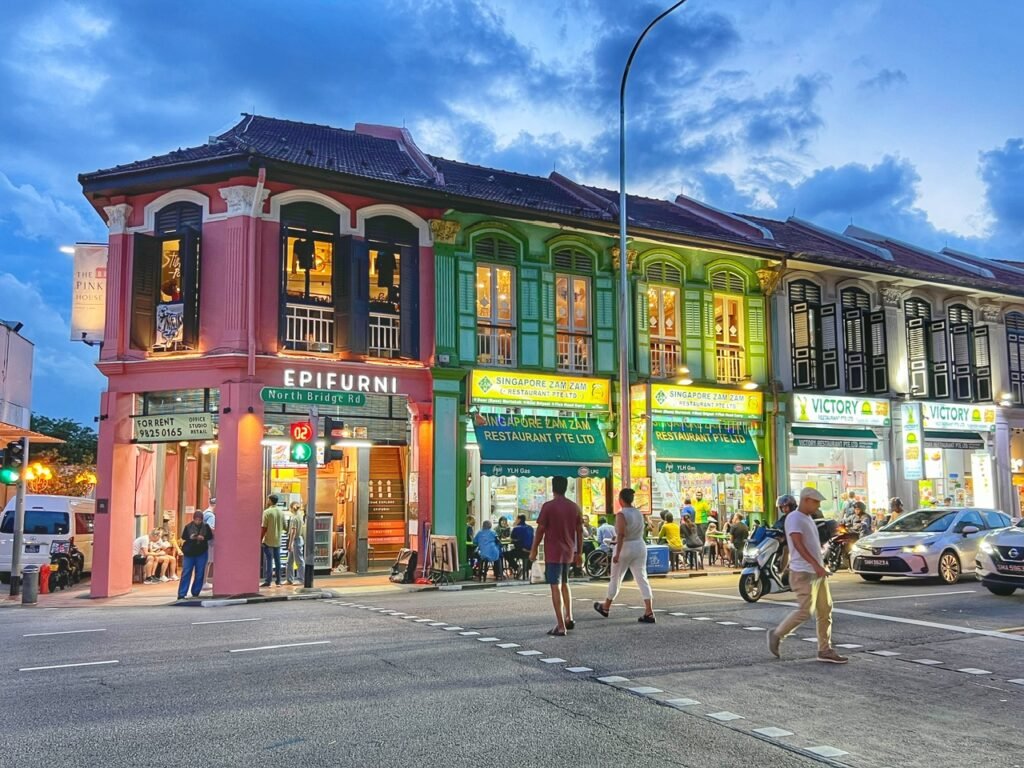

The charming shopfronts along Arab Street boasted bright tutti-frutti colors.
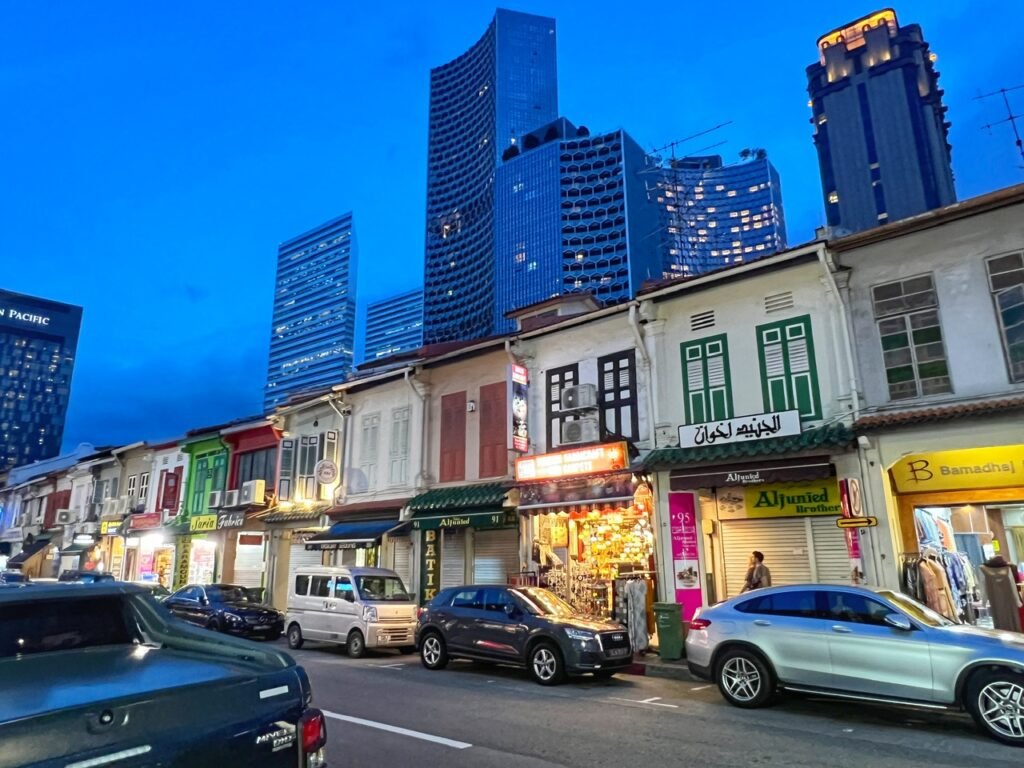
What a contrast in past meets present!

Within the area you will also have the opportunity to wander down Muscat Street so you can get in touch with your inner Omani.
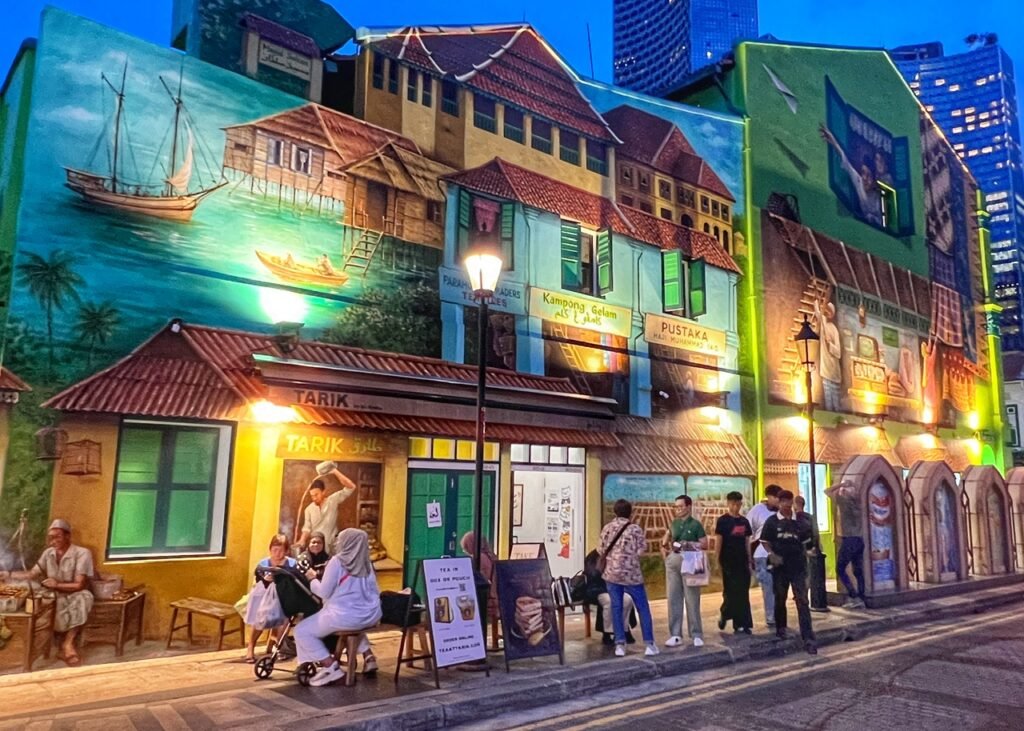
Muscat Street was named in 1909 after the capital of Oman and was jointly redeveloped in 2012 by Singapore and Oman. The arches (previous photo) reflect Kampong Glam’s role as a hub for Arab traders during Singapore’s early history. The murals symbolise the maritime and trade connection between Singapore and Oman which has continued to this day.
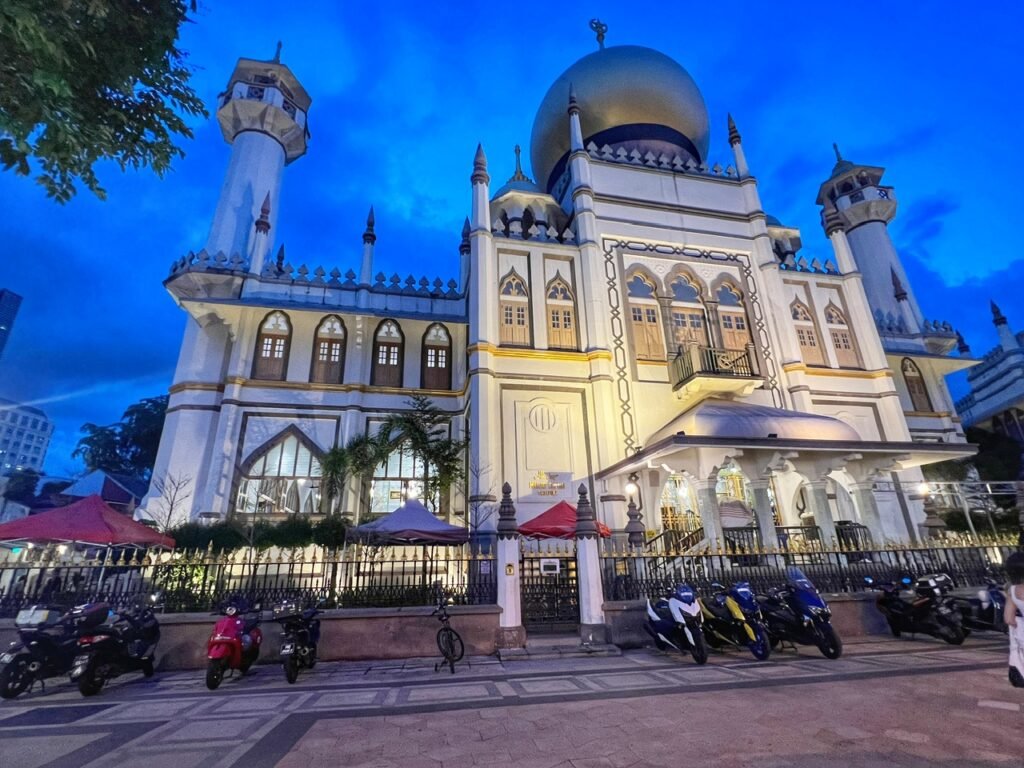
Little Muscat Street finds its finale at the Sultan Mosque. This is the only mosque in the city with outward facing loudspeakers so if you don’t wanna hear the Call to Prayer, you’d probably prefer not to stay in its immediate vicinity. Interestingly, Singapore was the first city to begin using loudspeakers in mosques in 1936 and “it could carry more than a mile.” Uhhh…Thank you Singapore?! 😬🤣 (Wikipedia)
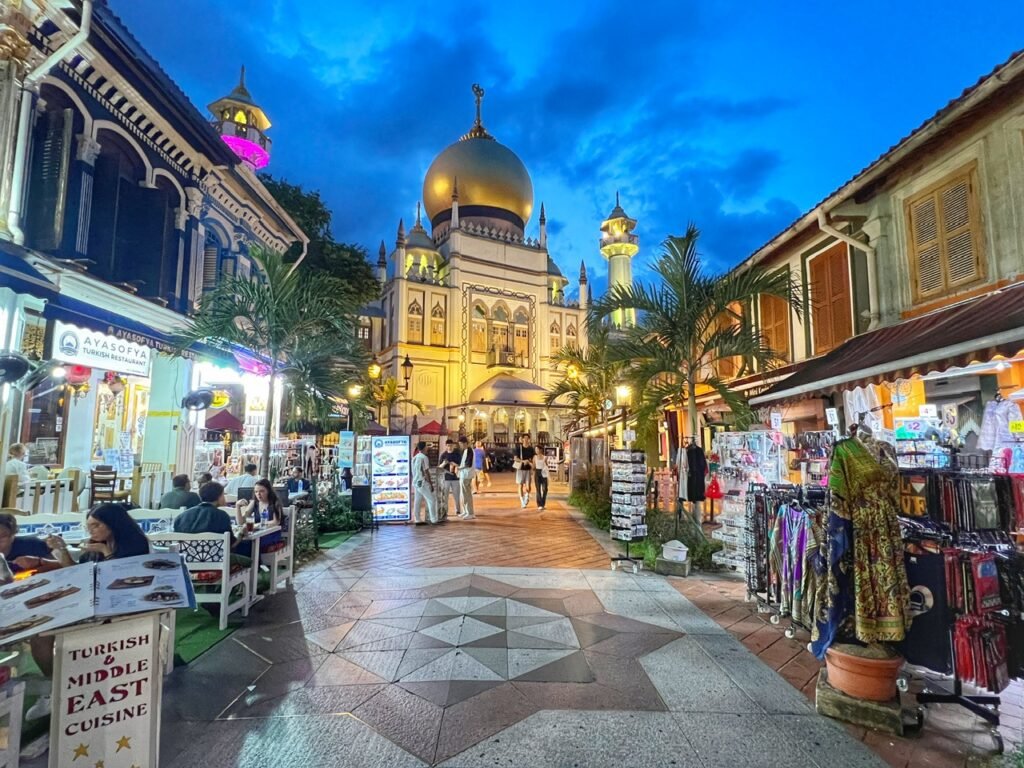
Because this part of the world is one of our favorites, we truly loved the vibe of this neighborhood and the fragrance of Turkish, Lebanese and other Middle Eastern cuisines that danced through the air.
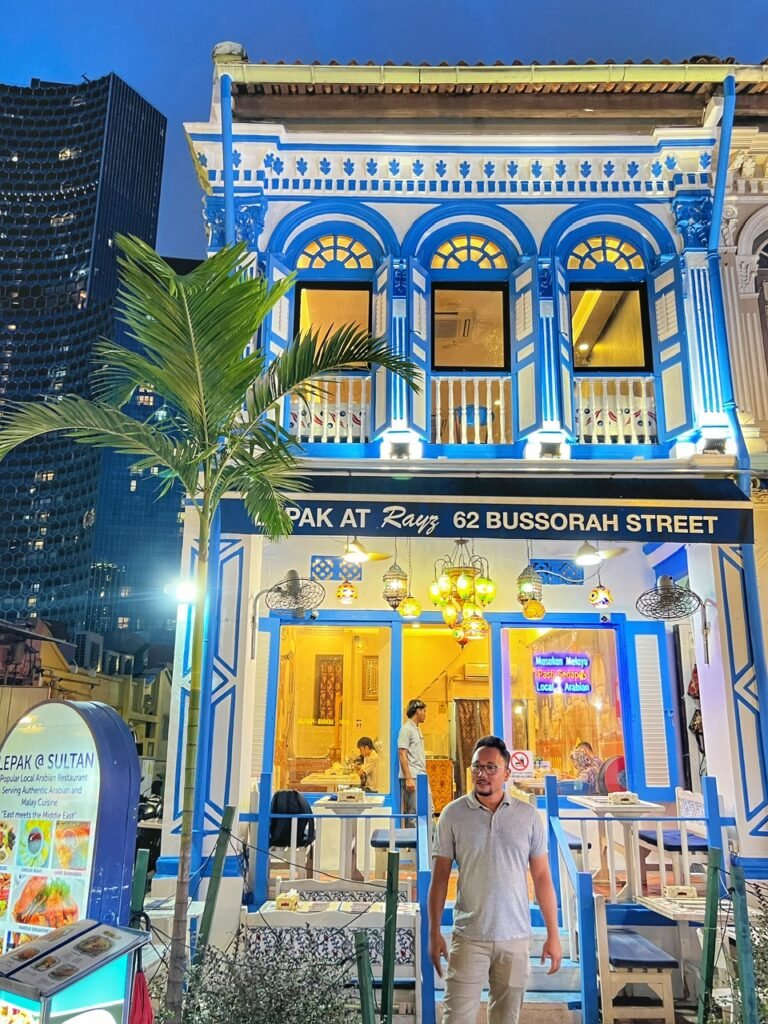
Unfortunately we’d already eaten in Little India so we couldn’t be beckoned by even the most illustrious pile of hummus or baba gnanoush

More old meets new contrasts
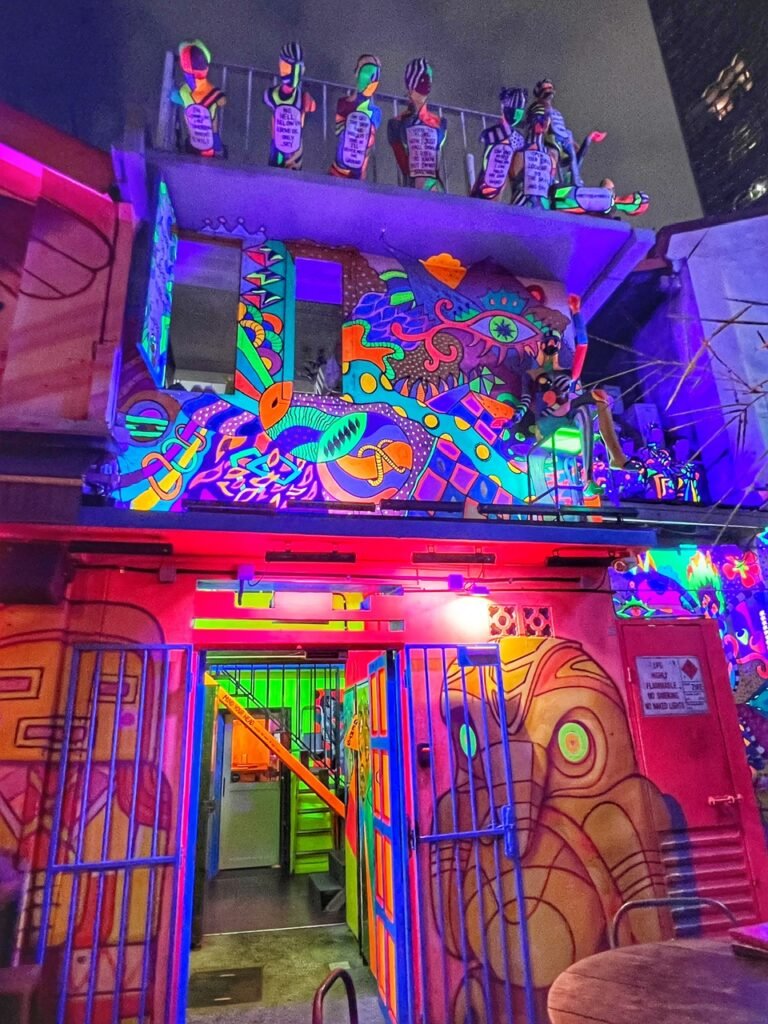

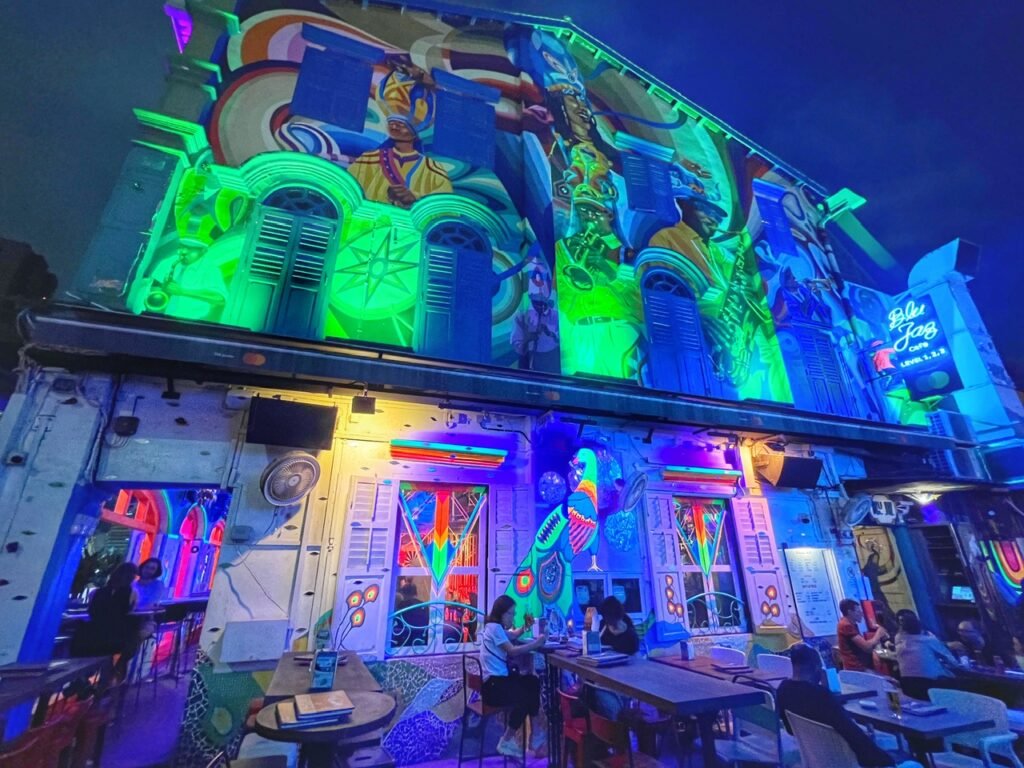
The black lights of Bali Lane definitely had some eccentricity, including a buzzing hot spot called Blue Jazz.
Chinatown & The Cheapest Michelin Star Restaurant in the World
On another day we had to make an obligatory stop for a 60 by 60 item we had on our list…to eat at a Michelin star restaurant. And you can count on us to find the cheapest one in the world at Hawker Chan’s in Singapore’s Chinatown where our Soya Sauce Chicken Rice was $2.59 USD. Was it the best food we’ve ever had? Not even close. In fact, it bordered on quite disappointing, but at least we didn’t pay much for it. 🤣
After that, we wandered around Chinatown admiring the Peranakan architecture, checking out the temple where supposedly an original tooth of Buddha lies, and generally dodging crowds, because tourists do seem to find their way to this part of the city, probably due to its proximity to the “SuperTrees.”

The Soya Sauce Chicken & Rice is the signature and award winning dish of Hawker Chan’s. We’re still scratching our heads to figure out why. Although the chicken was tender, and the sauce was pleasantly sweet, the veggies were overcooked and every bite also had bone fragments that your tongue had to sort through. But we got our 60 by 60 check! 🤣

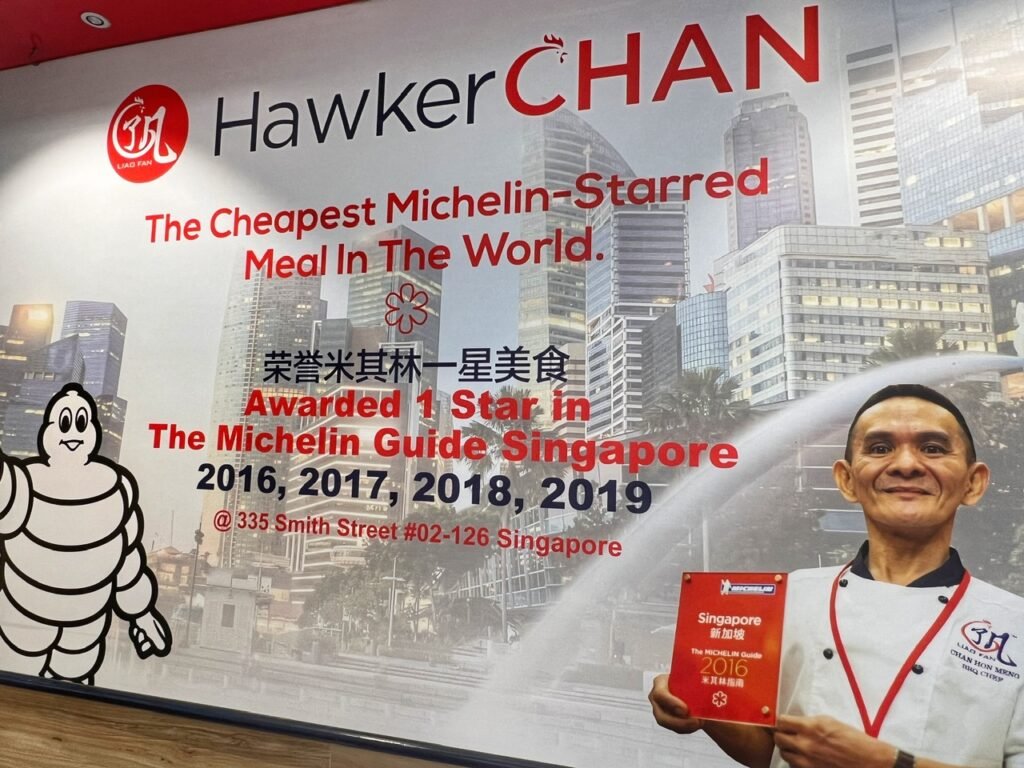
We were ready for lines, however, and were pleased to see there were none in the classic hawker stall atmosphere. However, note that there is also another location right across the street from the market which is much more fast foodie, and seemed to be where the majority of tourists end up. It was slightly more crowded but not bad at all, even at lunch hour. The dish also costs $1.50 more.
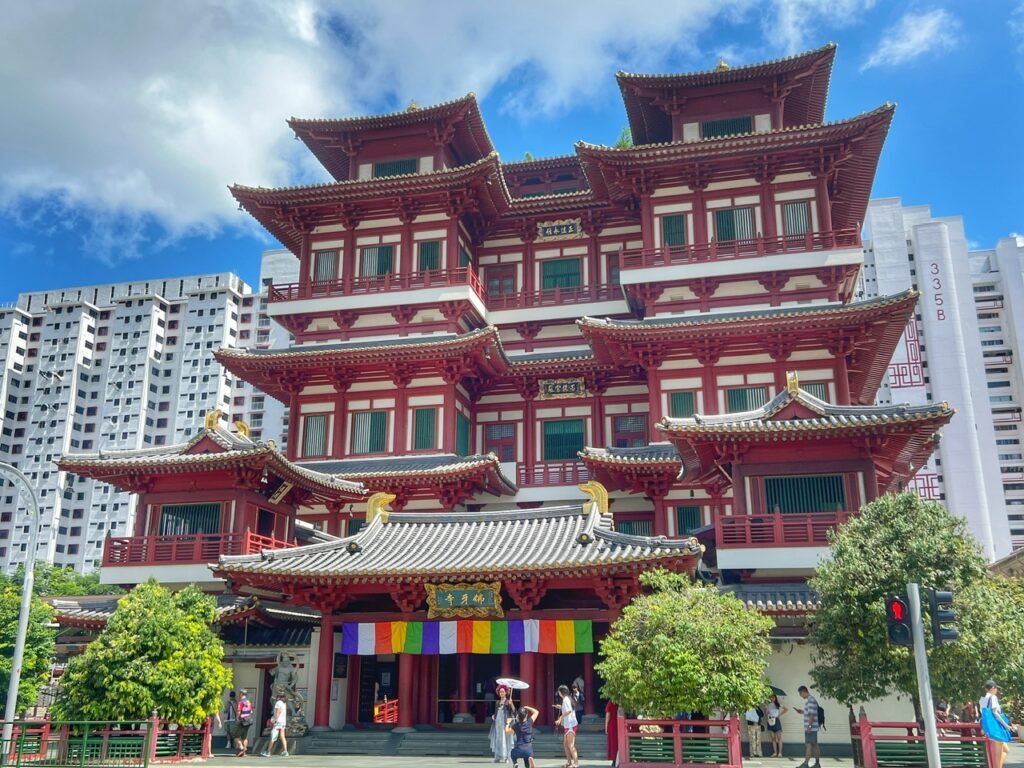

Disappointedly moving along, we checked out the Buddha Tooth Relic Temple, which was built in 2007 and gets its name from what the Buddhists regard as the left canine tooth of Buddha, which has been recovered from his funeral pyre in Kushinagar, India and displayed on the temple’s grounds. The Buddha Tooth Relic is housed in a giant stupa made from 320 kilograms of gold.
The inside of the temple is draped with gold and crimson. The sacred Buddha tooth relic is supposed to held in a glass panel on the third floor but there was not access up there on the day we visited. Is there ever?
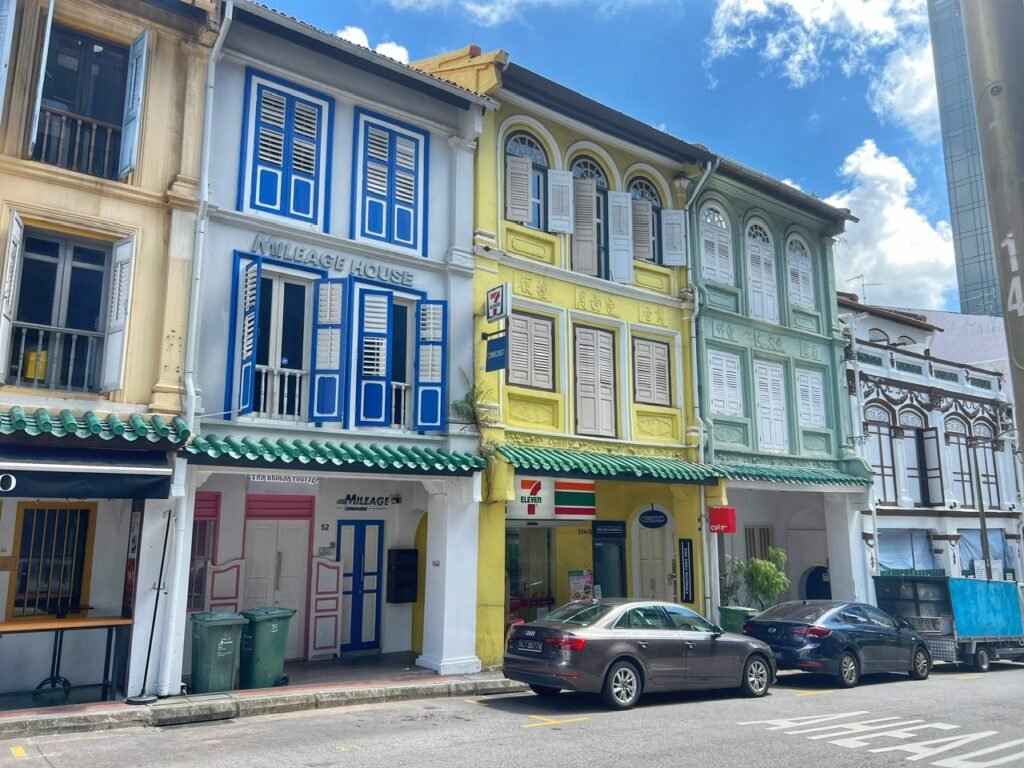
Chinatown originally was a division of colonial Singapore where Chinese immigrants tended to reside. They have since scattered throughout the city.

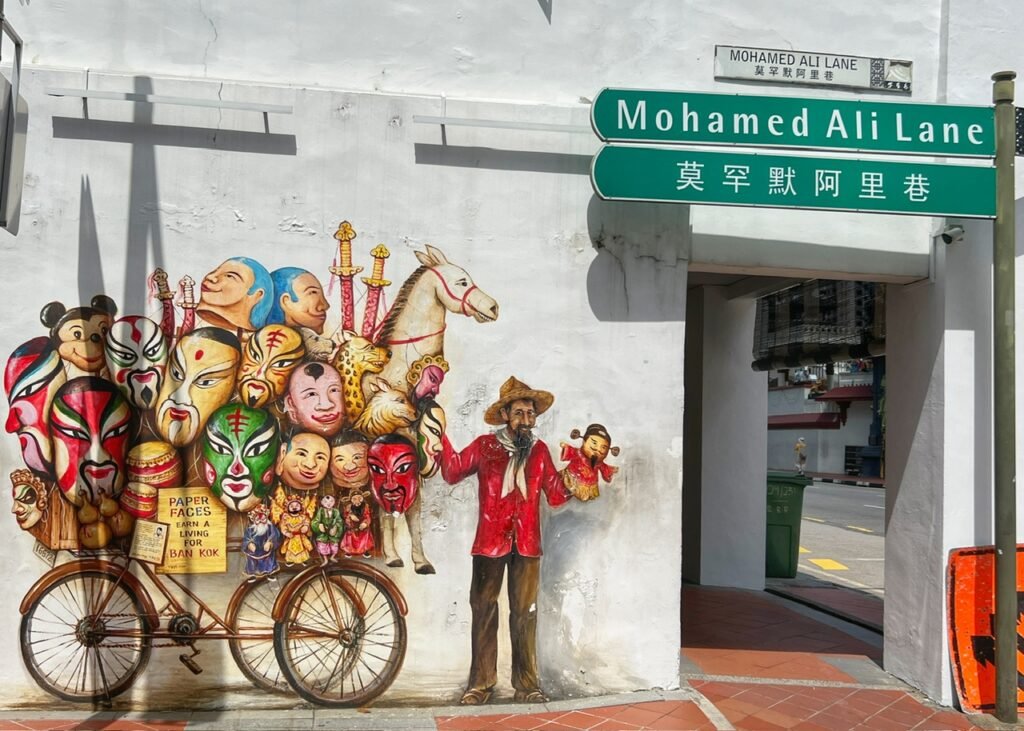
The street art throughout the neighborhood is very amusing and detailed, although we couldn’t exactly figure out what the paper face vendor’s sign meant.
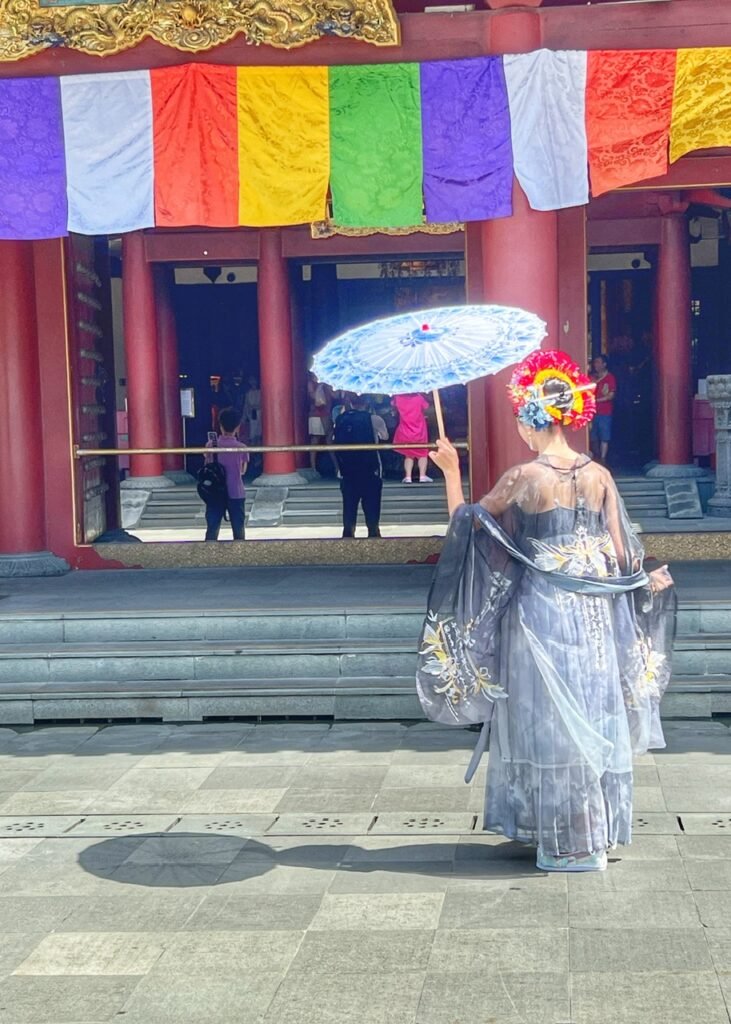
As instagrammer breaking out her templeware. Templeware, for the record, should not reveal this kind of skin 🤣
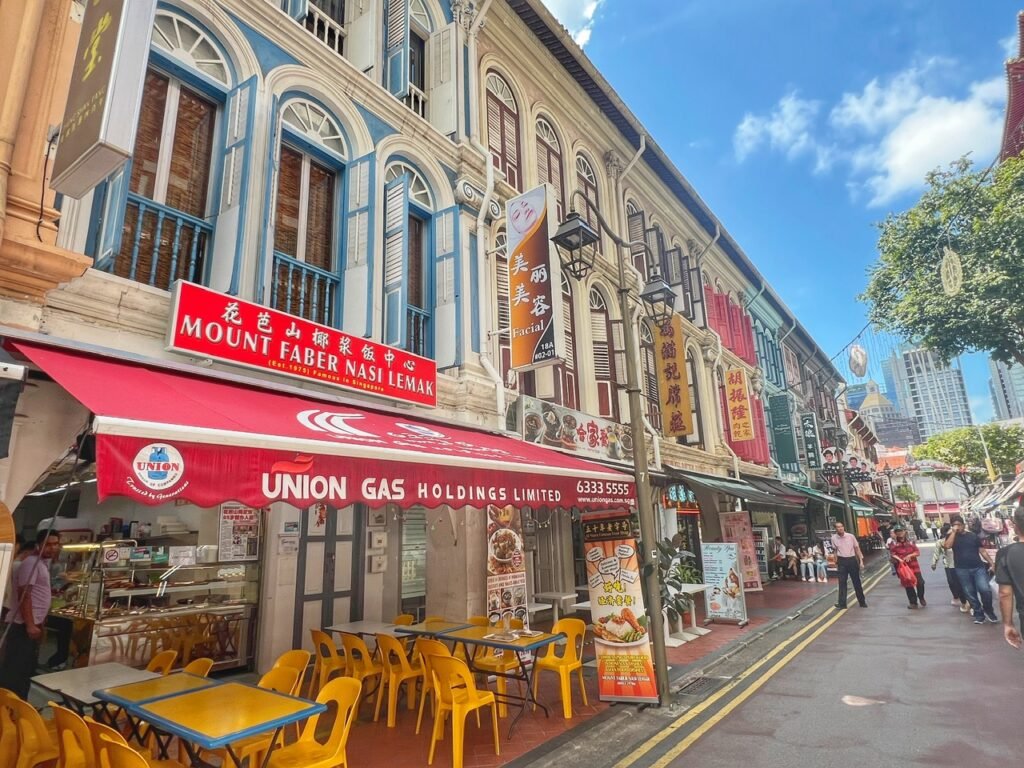

Speaking of skin, the shophouses were home to brothels until 1930, when the Women and Girl’s Protection Ordinance was enacted, bringing the prostitution situation under control. They were also used as “death houses,” aka hospice type homes for the terminally ill until the 1960s. (Wikipedia) Today, the whole area is buzzing with life and activity.

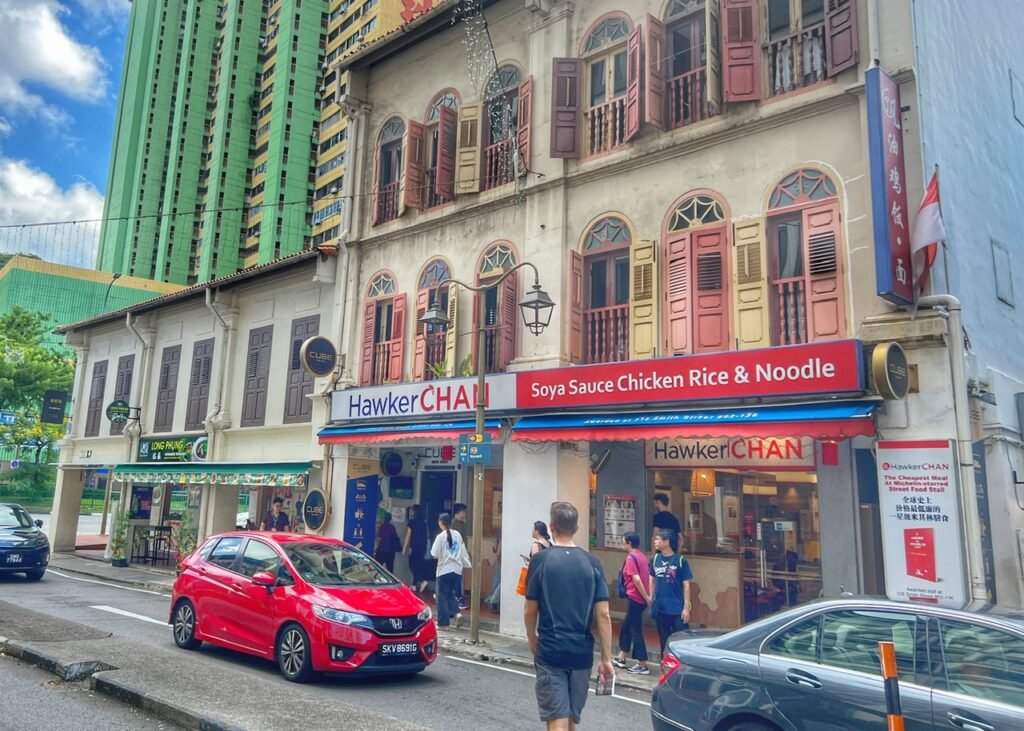
More street scenes, including the other Hawker Chan’s fast food restaurant where we saw more tourists. If you still plan to go, despite our not-so-raving review, make sure and check out the authentic one across the street on the second floor of the hawker stalls.
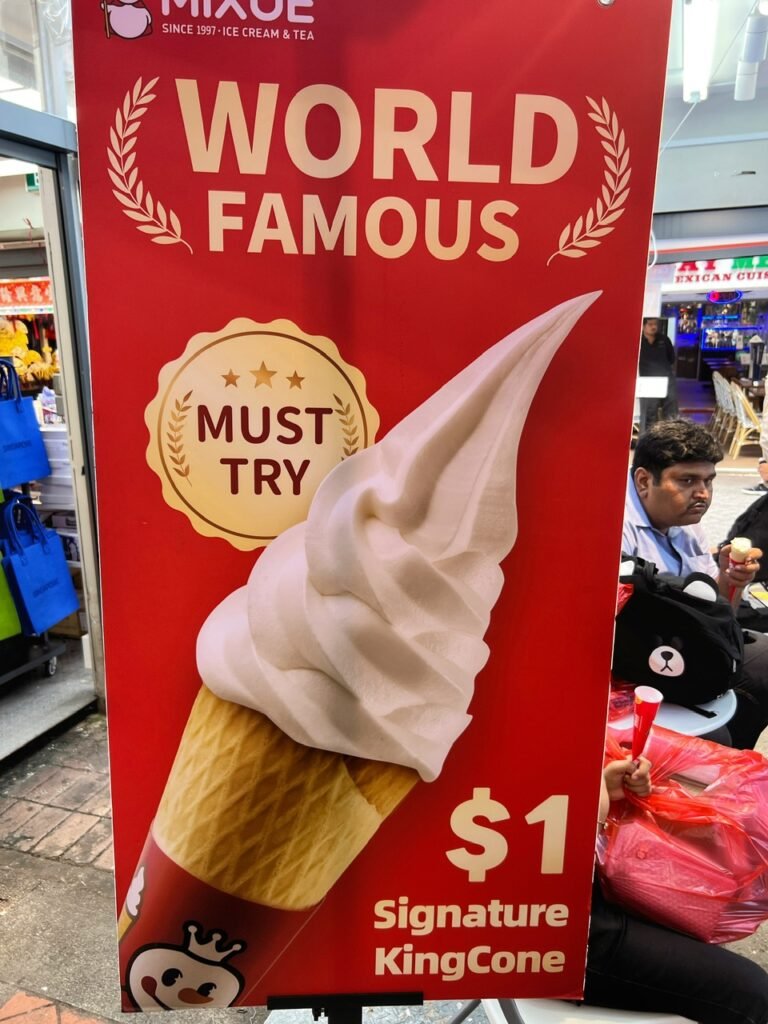
That’s ok. We washed it down with a “Signature” $.74 USD cone from Mixue which are allegedly world famous according to this sign. We had one in Vietnam too…for about $.25 cheaper.
More Food. More Sites. Less Money.
A week was definitely not enough time in Singapore, which means we’ll have lots of things left to do next time we pass through. This last chunk is mostly dedicated to other random things we did, saw and ate during our time in the city.
Among them was a visit with a follower turned friend named Esther, a native born Singaporean turned Iowan, who happened to be visiting while we were there. We also sampled some of Singapore’s terrific hiking options in the tree top canopy walk, and devoured more food, all while having surprising run-ins with various signage sprinkled around.
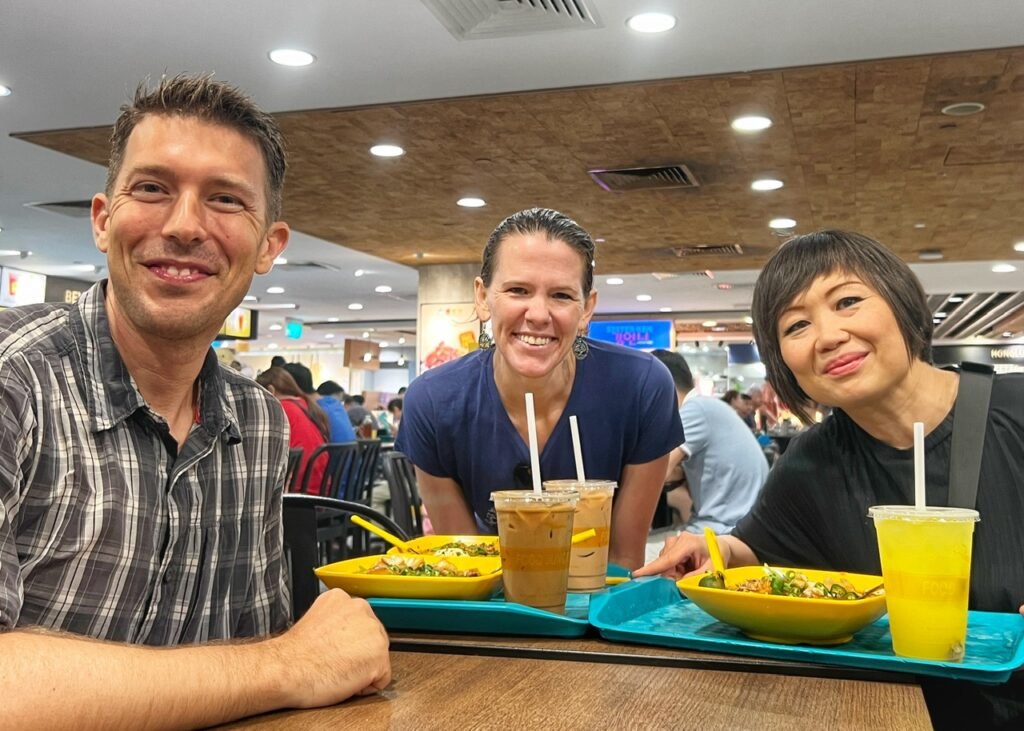
Our best meal in Singapore was thanks to Esther, not only because she chose for us what to eat at the very overwhelming Junction 8 food court, nor because she sweetly treated us, but because of her company. We loved chatting travel, learning more about Singapore and…
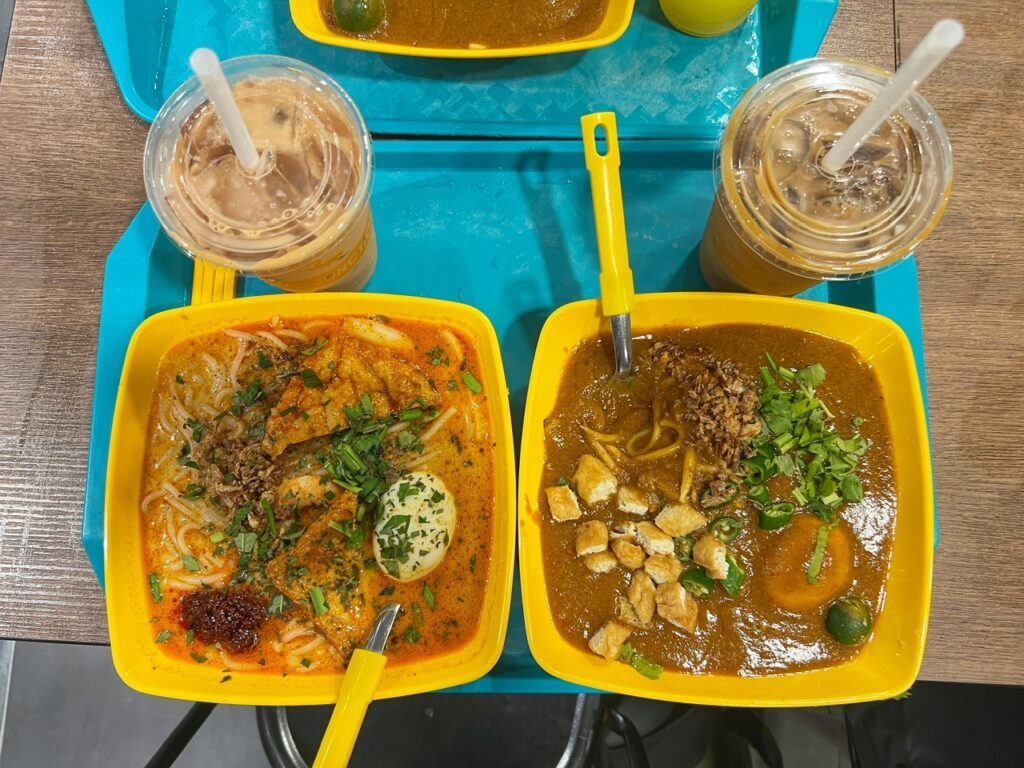

…yes, the food itself!!! We had a Singapore Laksa, Mee Rebus and a sweet iced coffee and tea. In the past, we had only had a Penang Laksa. It’s interesting to learn that all the countries, and even regions, around here seem to have their own version of the dish. Kinda like chili back home. But…not. 🤣 They all originate from Peranakan Chinese cuisine and differ because of the broth based in the recipe…either rich and savoury coconut milk, fresh and sour asam, or a combination of the two. In the Singapore version, they use a coconut curry broth that is complex, fragrant, and just the right amount of richness. The noodles are normally cut up into smaller pieces so that the entire dish can be eaten with a spoon alone, without chopsticks or a fork. (The Laksa Encyclopedia.) It’s delicious in any form we’ve had it.
Mee Rebus is another noodle dish, but vastly different. It’s a beautiful melody of sweet, spicy, a little tangy and creamy. In fact, the broth itself has a bit of the same consistency of brown gravy, but with a much more punchy kick. Mmmm…
And for dessert, Esther plopped one of these down in front of us…an Ais Kacang. The 8-year-old children in us were excited to see this snow cone looking concoction with a pyramid of color. But instead of being accessorized by sprinkles and whipped cream, it was dressed with vegetables in the form of sweet corn, sweet beans and grass jelly, which simply didn’t compute. It wasn’t bad by any means…we were just a little perplexed by the whole experience…and wondering if this might be a way for American children to eat more vegetables. 🤣 Asians sure love their bean creations for desserts….
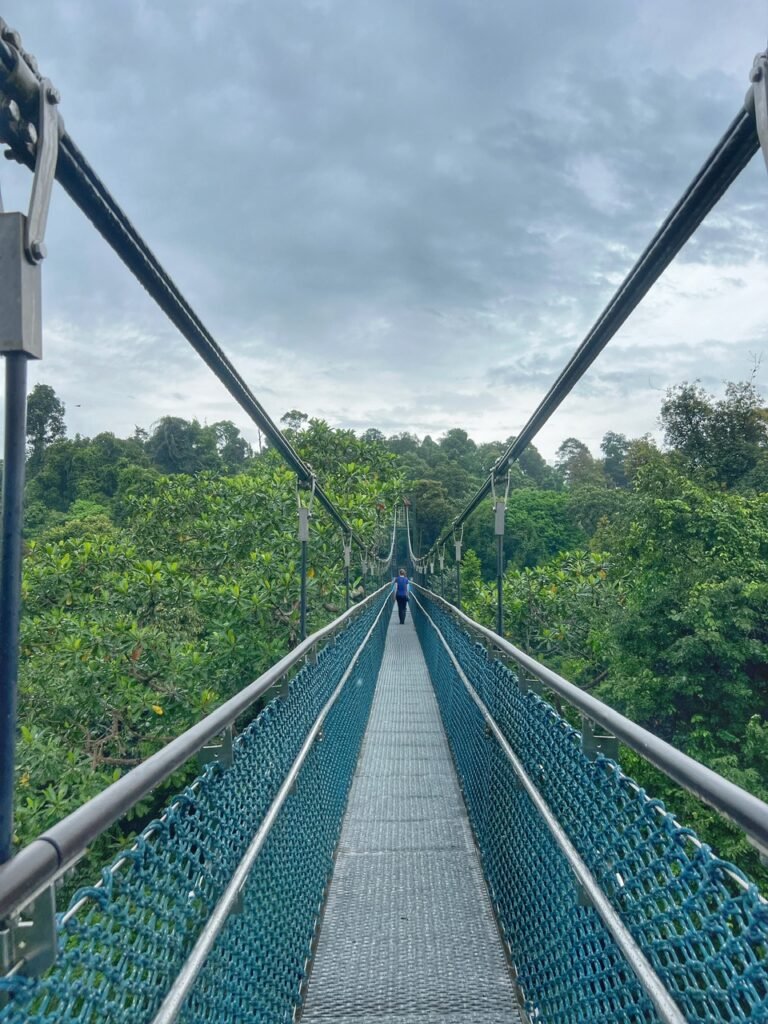


The same morning we took the bus to the Macritchie Treetop Walk Trailhead, a fabulous, but very soggy for us, walk in the tree canopy. And like most trails and parks in Singapore, it was absolutely free! What a wonderful escape from the city!
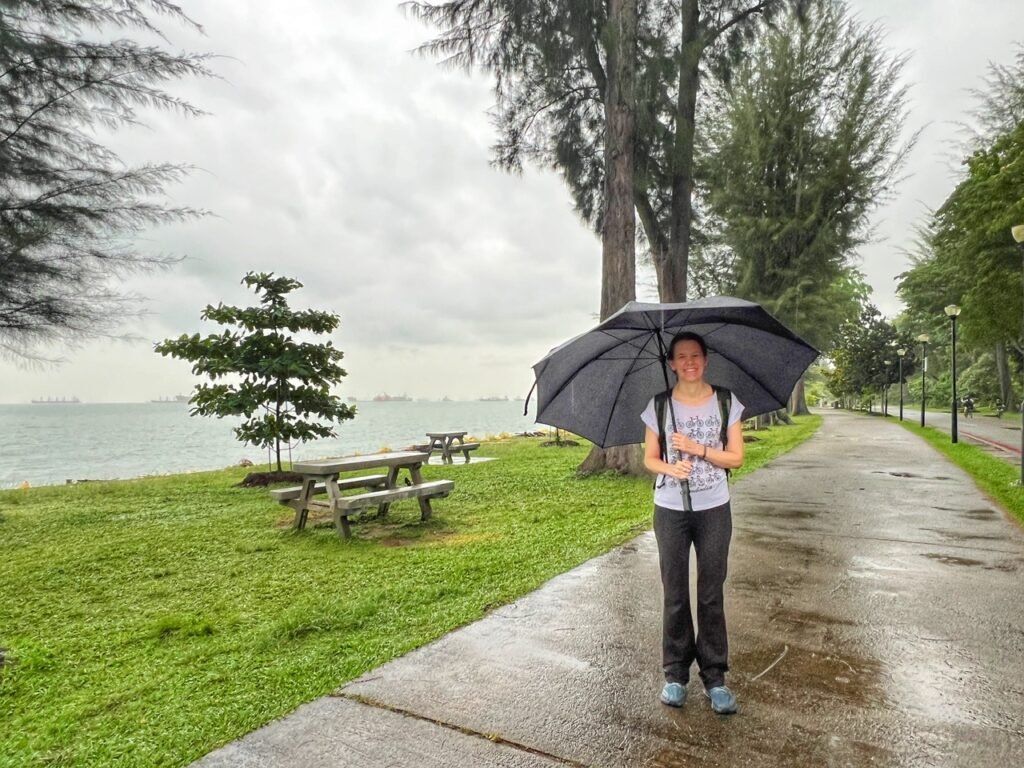
On another soggy occasion, we splashed along the seashore nearest our place in Katong. Fortunately, the slightly slow moving pugs (an understatement) were not with us, and we also were able to borrow massive golf umbrellas from our hosts.


In the distance we could see the ships chugging along the Singapore Strait, the 113 kilometer (70 miles) wide chunk of water that separates from Indonesia. Approximately 2,000 merchant ships traverse these waters everyday, according to Wikipedia. The Amber Beacon Tower, on this same beach, is a still used lighthouse. On this rainy day its main purpose seemed to be umbrella.
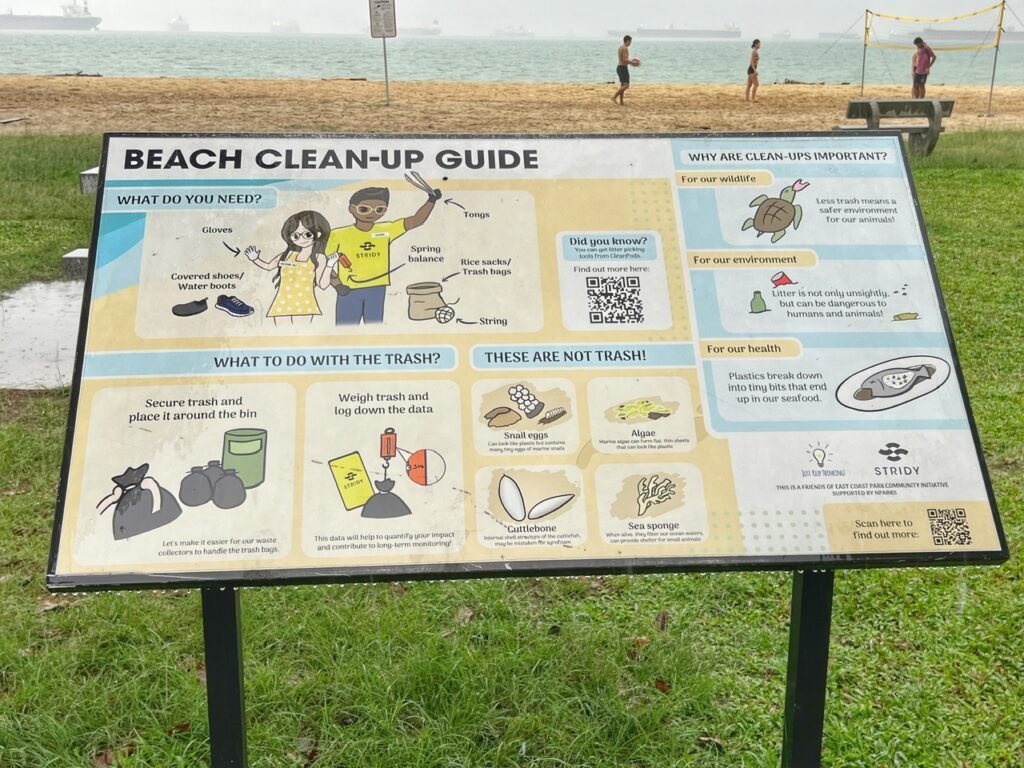

A sign for Stridy, a nonprofit that enables individuals and communities to record and track their unlittering progress through the Stridy App, which makes litter pick up accessible and fun through community building. What a fantastic idea!
We were thrilled…and dismayed…to see the efforts of these litter warriors first hand lining the edges of East Coast Beach. Although the beaches were nearly completely clean, and probably stay that way from the locals due to strict laws and pride for their environment, the horrific plastic that fills the bags mostly floats in from elsewhere. Most of the finger pointing, of course, is directed at Indonesia.
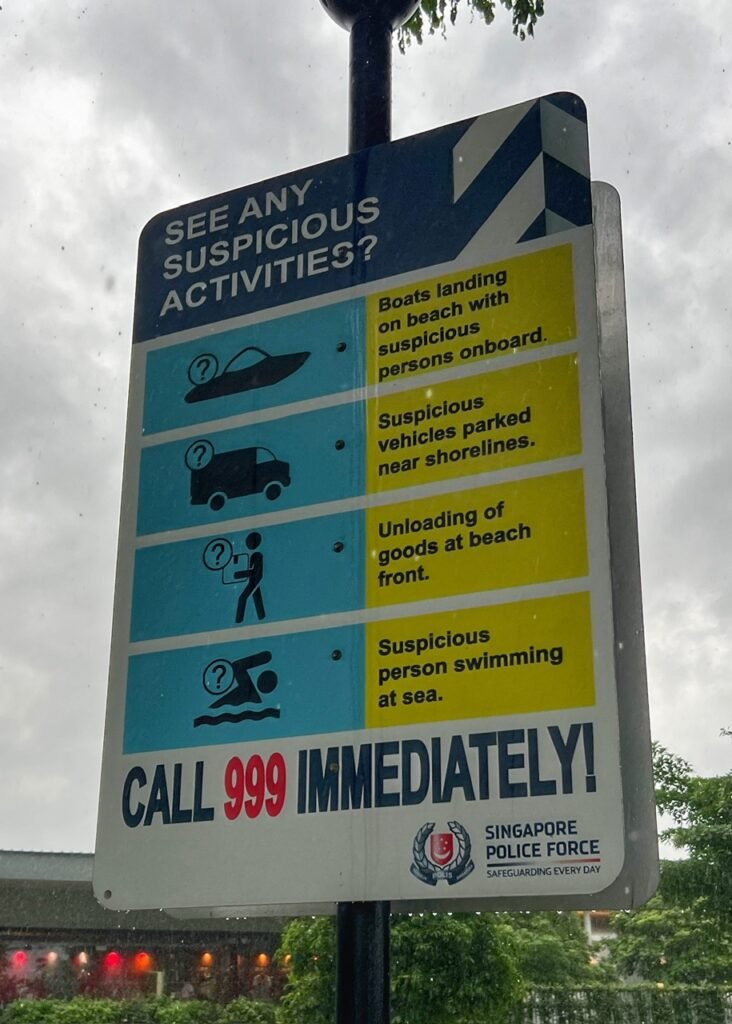
Speaking of which, if you see a “suspicious person swimming at sea” or any other suspicious activities, one should call 999.
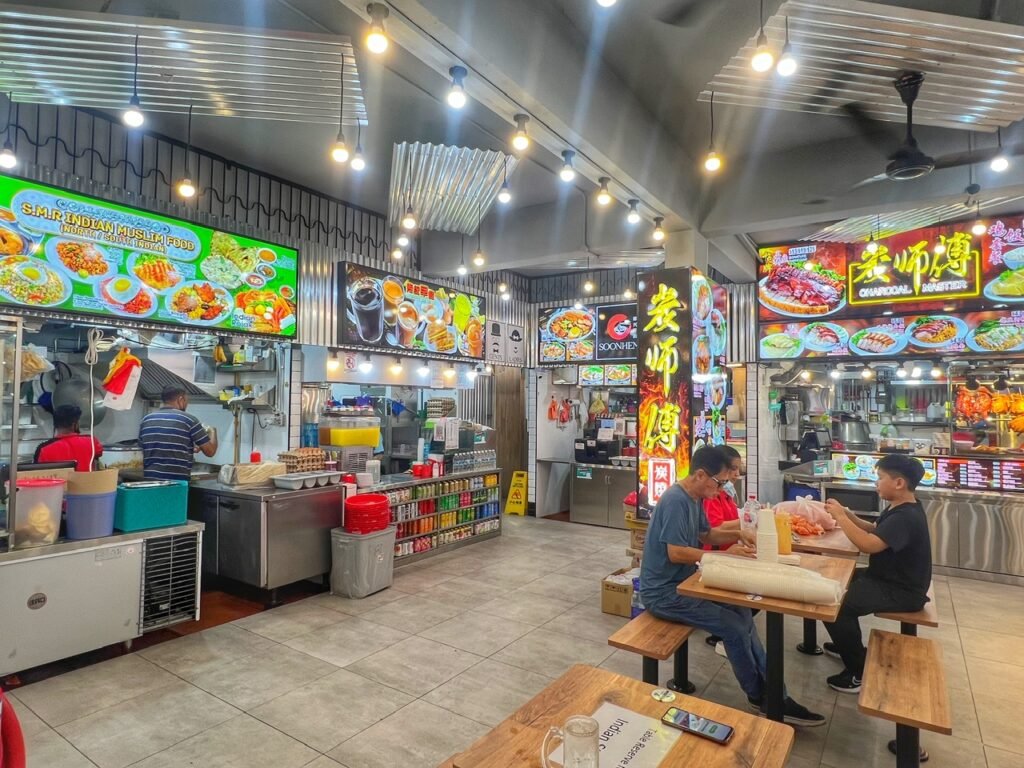

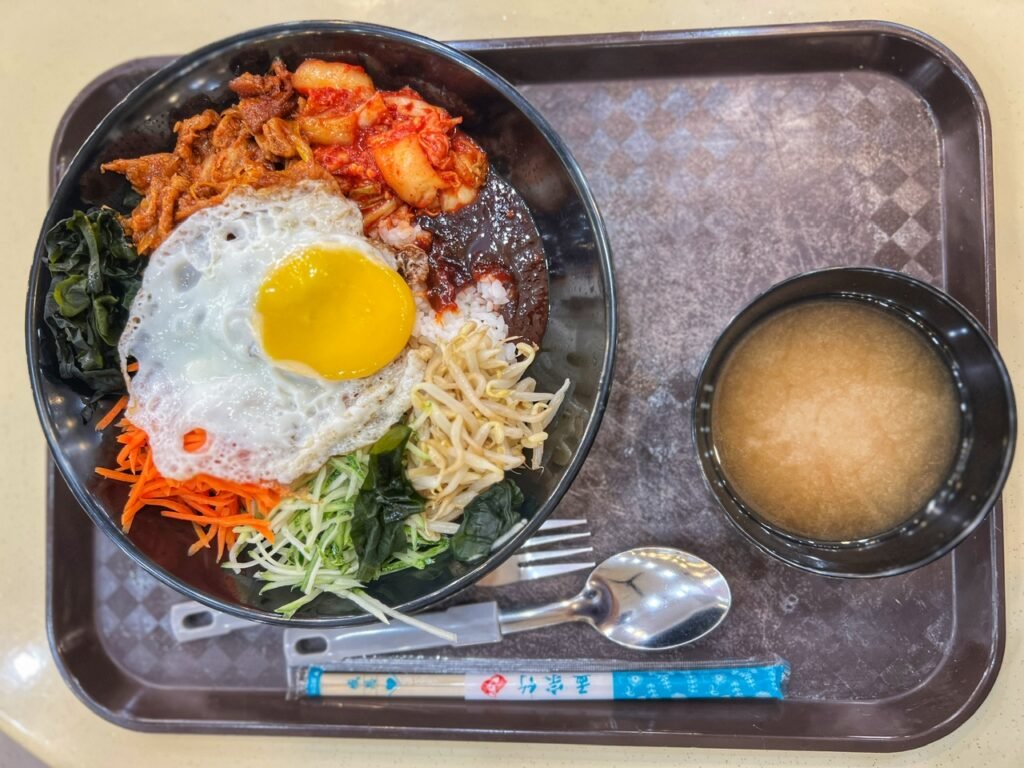
After a very drippy tramp in the rain, we checked out the hawker stalls on Marine Parade. Note to selves: you will get scolded if you take a wet umbrella inside in Singapore. Fortunately, I don’t think anyone turned us in to 999. 🤣 Mandy grabbed a roti dosai platter for $3 and Greg grabbed the Korean dish of bibimbap for $5.
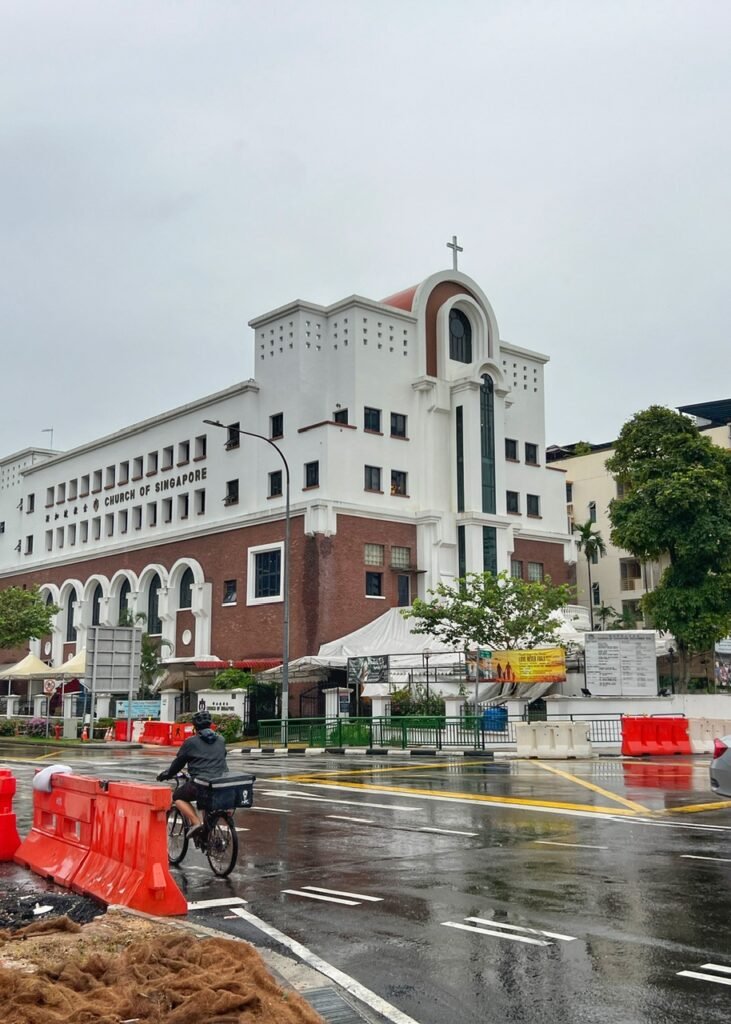
A church in Singapore…often found next to a mosque or a temple.
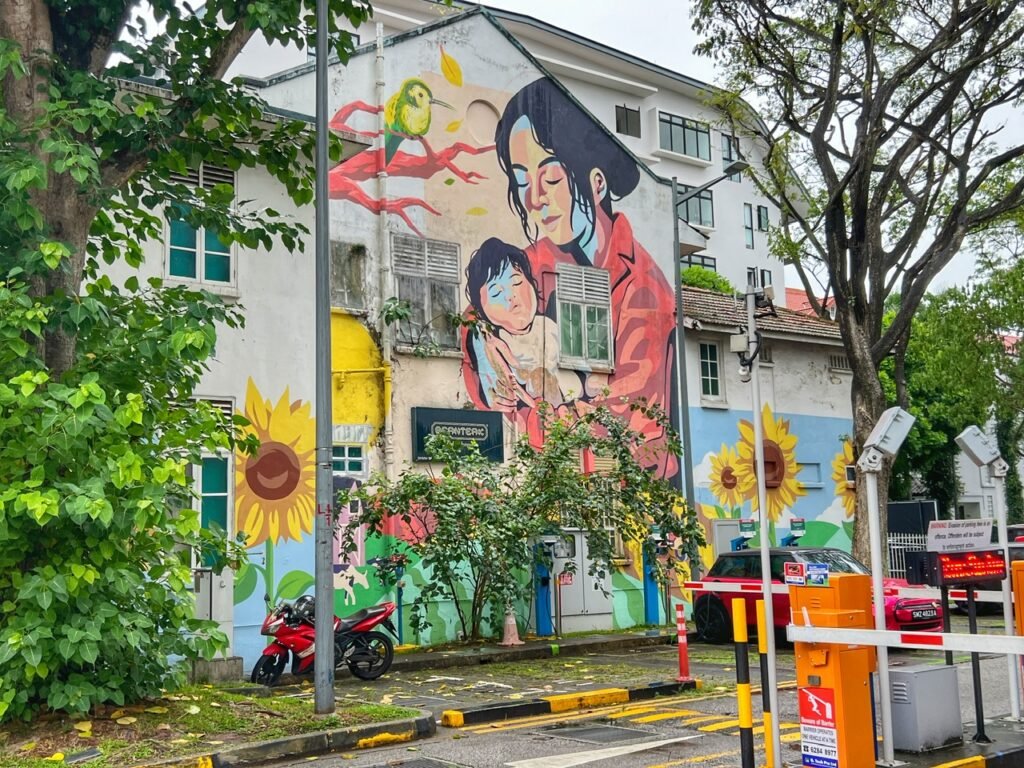
Although graffiti is illegal, street art is abundant and beautiful. Is it just us though, or does that mama kinda look like Michael Jackson?!
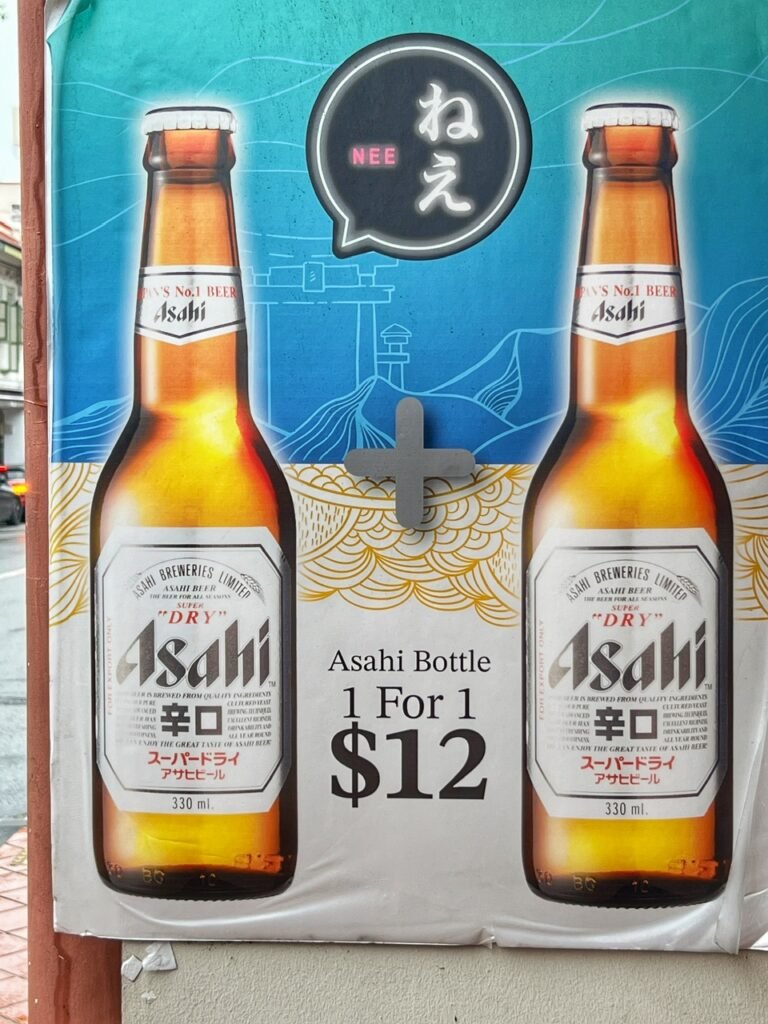
This is why we did not drink in Singapore. Asahi is a Japanese national beer, which isn’t very good, for the record. The cost for one bottle, thanks to taxes, is advertised as $12 Singaporean which is ~$9 USD. Of course, if you want craft, it’ll be $14-18 or $10-13. Even our resident brewer Greg cannot fathom paying that kind of money for beer.

On the bus. Now…this is a law we could get behind. But….caning?!?! 😮 We realized during our quick time there, Singapore seems oddly progressive about some things and oddly in the Middle Ages about others.
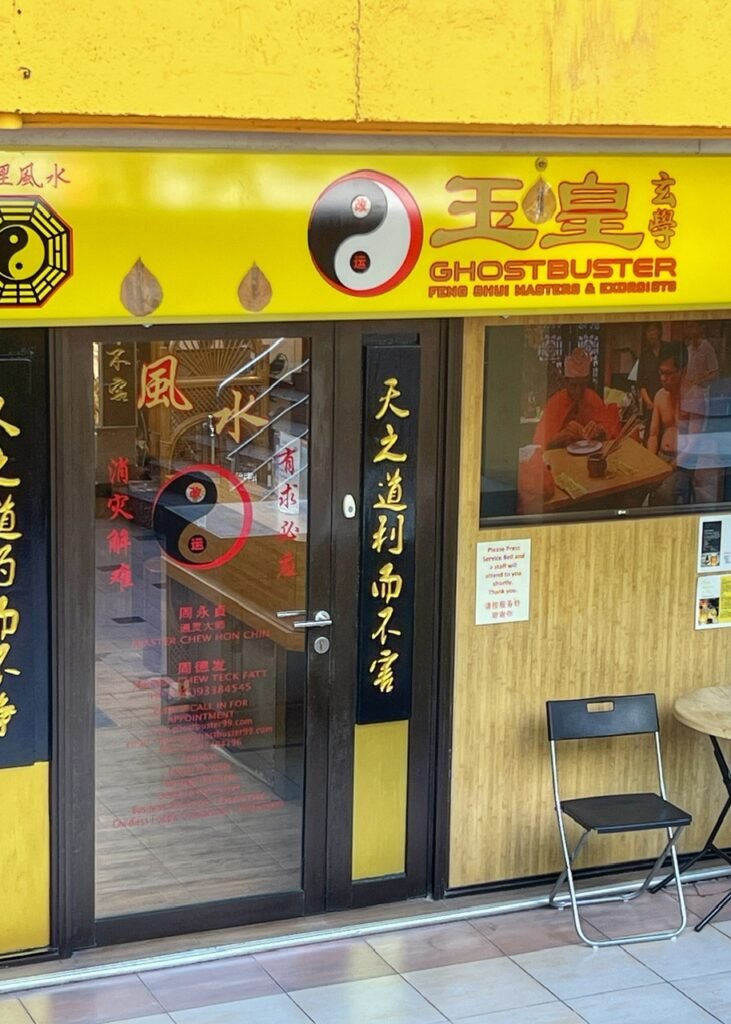
They also have Ghostbusters, aka Feng Shui masters and Exorcists, listed in their yellow pages. (Sorry for the Boomer references, millennials.)
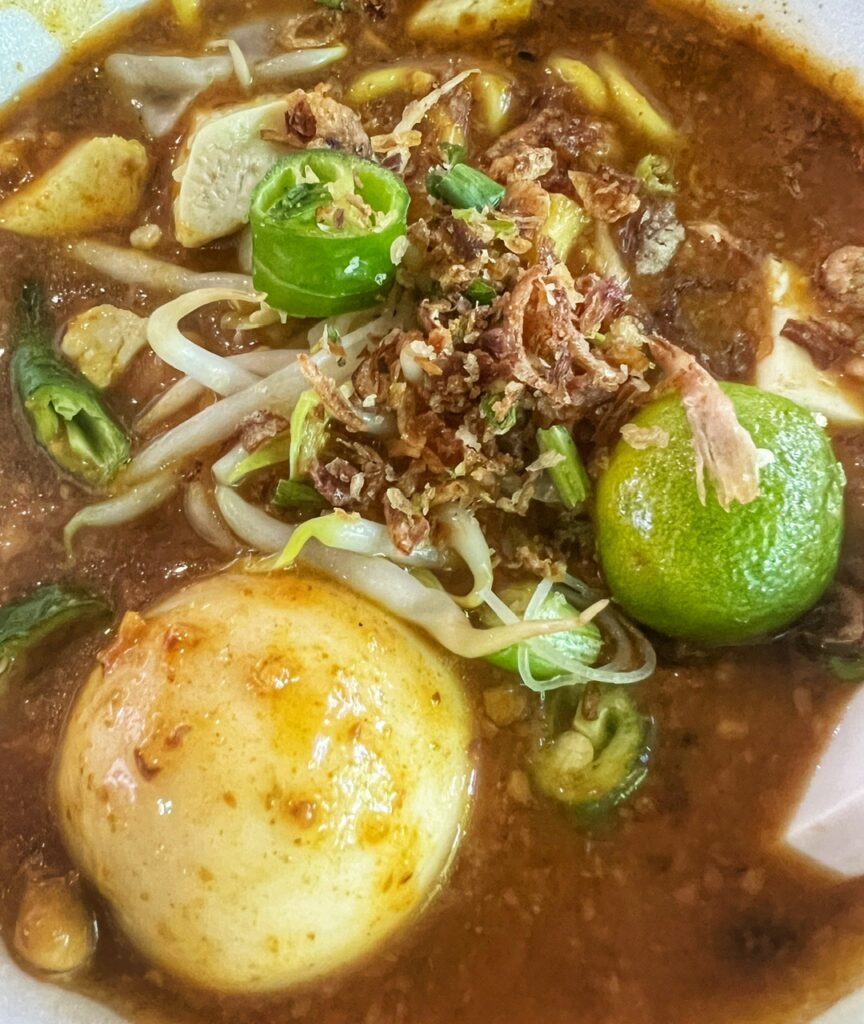

More mee rebus with those adorable little limes they kerplunk on everything. 🤤 Chicken satay with peanut sauce. Both dishes were about $7.50 USD at another hawker stall.


